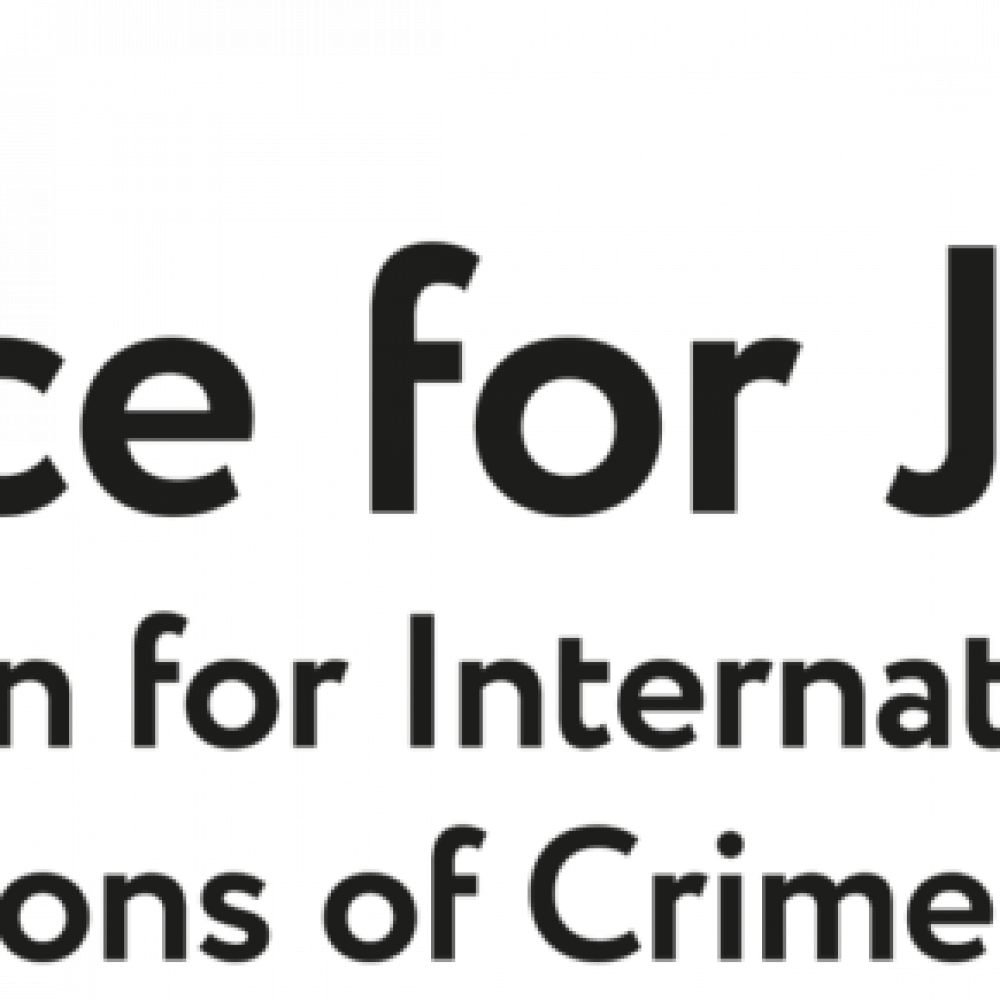
BELARUS
AN INDEPENDENT EXPERT OPINION ABOUT ATTACKS ON MEDIA WORKERS IN BELARUS REPORT
The Justice for Journalists Foundation’s report seems to me to be a document that is rather precise, clear, concrete, and comprehensive from the point of view of the facts. In the report, the principal cases of violation of freedom of speech and of the rights of journalists in the course of 2020 — the beginning of the year 2021 are recorded, while the violators of these rights and the main trends in the suppression of freedom of expression in the country are clearly indicated.
It is worth adding that the largest independent internet portal in Belarus, Charter97.org, is being subjected to illegal blocking since 2018. In 2020 the blocking of the website intensified: in particular, “mirror” sites were blocked; likewise, mass DDoS attacks were used against our media, and Charter97.org’s documentary films were being blocked on YouTube at the demand of Belarusian structures of power.
Besides that, it is important to mention the criminal cases in relation to Belarusian bloggers Sjarhej Pjatrukhin, Dzmitryj Kazloŭ, Aljaksandr Kabanav, Ŭladzimer Cyhanovič, Ihar Losik, Paval Spiryn, and others. They are being held in detention for over half a year already on made-up charges, and face the spectre of a prison term.
I hope that the given report on violation of freedom of speech in Belarus will be taken notice of by international structures: both human-rights ones and those responsible for the foreign policy of the states of the EU and the USA, because the violations enumerated in the report are compelling grounds for introducing serious sanctions against Belarus’s dictatorial regime.
Natallia Radzina, editor-in-chief, Charter-97 website (Belarus)
Author of the report – Belarusian Association of Journalists
1/ KEY FINDINGS
1558 instances of attacks/threats in relation to professional and citizen media workers and editorial offices of traditional and online publications in Belarus in 2020 were identified and analysed in the course of the research. The data were obtained from open sources in the Russian, Belarusian, and English languages using the method of content analysis. A list of the main sources is presented in the Annex 5.
- The quantity of attacks on journalists, bloggers, and media workers in 2020 exceeded the sum total of attacks throughout 2017-2019 (1079) by 1.4 times.
- Attacks via judicial and/or economic means were the most widespread form of pressure on journalists, bloggers, and media workers in Belarus. 1385 incidents were recorded in the given category.
- The majority of physical attacks could be attributed to attacks on the part of representatives of the authorities (91 out of 96 incidents). During a protest against the falsification of the results of the presidential elections, riot police were deliberately targeting journalists for beating and humiliation.
- More than 30 journalists were deported from Belarus and banned from entering the country for a period ranging from 5 to 10 years, including at least 19 journalists from foreign media outlets.
- In 96% of the instances, the attacks against journalists were coming from representatives of the authorities (1506 out of 1558 incidents).
2/ THE POLITICAL SITUATION AND THE MEDIA IN BELARUS
Belarus holds 153rd place out of 180 in the Reporters Without Borders annual freedom of the press index for 2020, falling between Brunei and Turkey.
In the Freedom on the Net rating of the international human rights organisation Freedom House, Belarus’s level of freedom on the net put it into the category of countries with an unfree internet in 2020, with 38 points out of 100.
Two events had the biggest impact on the situation in the media sphere in Belarus in 2020. First, this was the authorities’ attempts to restrict the dissemination of information about COVID-19 in the country. And second, the political and legal crisis after the elections of the president that took place on 9 August 2020.
The mass protests, which began in the country after the Central Electoral Commission announced the official results, were cruelly suppressed by riot police. The demonstrators were demanding the conducting of new elections, the release of political prisoners, a stop to violence, and punishment for the persons guilty of using it. The authorities were responding with harsh measures, administrative detentions, and the opening of criminal cases.
According to the assessment of the Vesna human rights centre, 33 thousand people were detained in the country during the time of the elections and in the post-election period; many of these were subsequently arrested or fined in administrative order. Vesna documented about 1000 witness accounts of torture; no fewer than four people perished. By the end of 2020, 650 people had become subjects in criminal cases connected with the elections and the mass protests; Vesna recognised 169 of them as political prisoners. However, not a single criminal case was opened due to the acts of violence on the part of the riot police and the death of protesters.
Pressure on media workers, journalists, and bloggers intensified sharply in 2020. The vast majority of the attacks on them fell in the post-election period. The situation in which journalists had to work sharply deteriorated.
STATE MEDIA OUTLETS
According to the data of the Ministry of Information, as of 1 January 2021 there were 1626 print media outlets registered in Belarus (there were 1614 a year earlier). Of these, 438 print media outlets are state-owned. The state media outlets receive preferential advantages and funding from the state budget allocated on a non-competitive basis. In 2020 the funding exceeded 73 million US dollars; the main part of this sum was directed towards funding Belgosteleradiokompaniya [the state broadcaster] (more than 55 million US dollars).
Of the 261 registered television and radio programmes, the overwhelming majority (188) are state-owned. The remaining television and radio channels are under the total control of the authorities, be they local or national, thanks to the system of registration and licensing.
As a sign of protest against violence and the need to justify it on the air, after the elections dozens of employees of the state media outlets resigned or were dismissed after participating in protests. Some of them were arrested, and likewise one criminal case was initiated.
INDEPENDENT MEDIA OUTLETS
The vast majority of non-state print media outlets are strictly entertainment and advertisement. According to the data of the Belarusian Association of Journalists (BAJ), there are no more than 30 registered non-state media outlets of a socio-political nature. Six of them ran into problems with distribution and printing in the second half of 2020 and were forced to cease coming out in printed format.
FOREIGN MEDIA OUTLERS
The state monopoly on broadcasting is undermined by foreign stations. A particular role is played by Radio Svoboda [Radio Liberty], European Radio for Belarus, Radio Ratsyia, and the Belsat satellite channel (the last three of which are registered in Poland). Their broadcasts are oriented towards Belarusians and are prepared predominantly by Belarusians.
However, neither Belsat nor Radio Ratsyia have lawful status in Belarus, despite attempts to open correspondent offices and obtain accreditation for their journalists. Freelancers who work with them are subjected to pressure on the part of the authorities; they are fined for “violating the order for the production and dissemination of mass information media output” (art. 22.9 of the Code on Administrative Violations).
Previously, Radio Svoboda and European Radio for Belarus journalists had received MFA accreditation every year; however, after the elections, under the pretext of elaborating a new statute on accreditation, the MFA revoked the accreditation of all foreign correspondents, including the employees of these media outlets. Radio Svoboda and European Radio for Belarus had still not been able to get new accreditation for their correspondents as of the end of the year.
INTERNET AND SOCIAL MEDIA
The freest sector of Belarus’s information space remains the internet. In all, there are seven non-state and 26 state net publications registered in Belarus as of 1 January 2021. Over the course of the year, only two non-state internet sites obtained registration as a media outlet. This is associated with the complexity of the registration requirements, while the advantages of having such registration are not self-evident in light of the existing conditions.
After eight months of unsuccessful attempts to register as a net publication, the Media-Polesye internet site received this status concurrently with a warning from Mininform, which is in fact how the editorial office found out about the registration in the first place. Subsequently, this allowed the police to fine Media-Polesye a hefty sum for violating the legislation on mass information media.
Pursuant to a lawsuit by the Ministry of Information, the largest Belarusian internet portal, TUT.by, had its status as a media outlet revoked.
All internet sites with an independent editorial policy were blocked on election day. Access to many of them is restricted in the country to this day. What is more, for three days the internet in Belarus was factually shut down. Later, shutdowns of mobile internet in Minsk took place regularly on the days of protests.
In these conditions, Telegram has acquired widespread popularity. However, the owners and administrators of many popular Telegram channels have been subjected to criminal prosecution. One of the vivid examples – pressure on the NEXTA Telegram channel, which was recognised as extremist.
Representatives of the authorities are declaring that the journalists of internet sites not registered as net publications do not enjoy the status of journalists and are not implementing professional activity as journalists.
3/ GENERAL ANALYSIS OF ATTACKS
The graph below represents the general analysis of attacks of the three main categories of attacks/threats on media workers in Belarus.

2020 turned out to be the most difficult one for Belarusian media and journalists in all the period that the situation with the media in Belarus has been monitored. The number of attacks against journalists, bloggers, and media outlets significantly exceeded the numbers for the three previous years combined. 1558 attacks on media workers were recorded in 2020; 88% of these (1385) fell into the category of attacks via judicial and/or economic means.
In addition to this, 2020 saw the largest number of physical attacks and threats in relation to journalists and bloggers – 96, which is four times more than over the three previous years in aggregate.
In 96% of the instances, the attacks in relation to journalists came from representatives of the authorities (1506 incidents out of 1558). 40 attacks were from non-representatives of the authorities and 12 from unknown perpetrators.
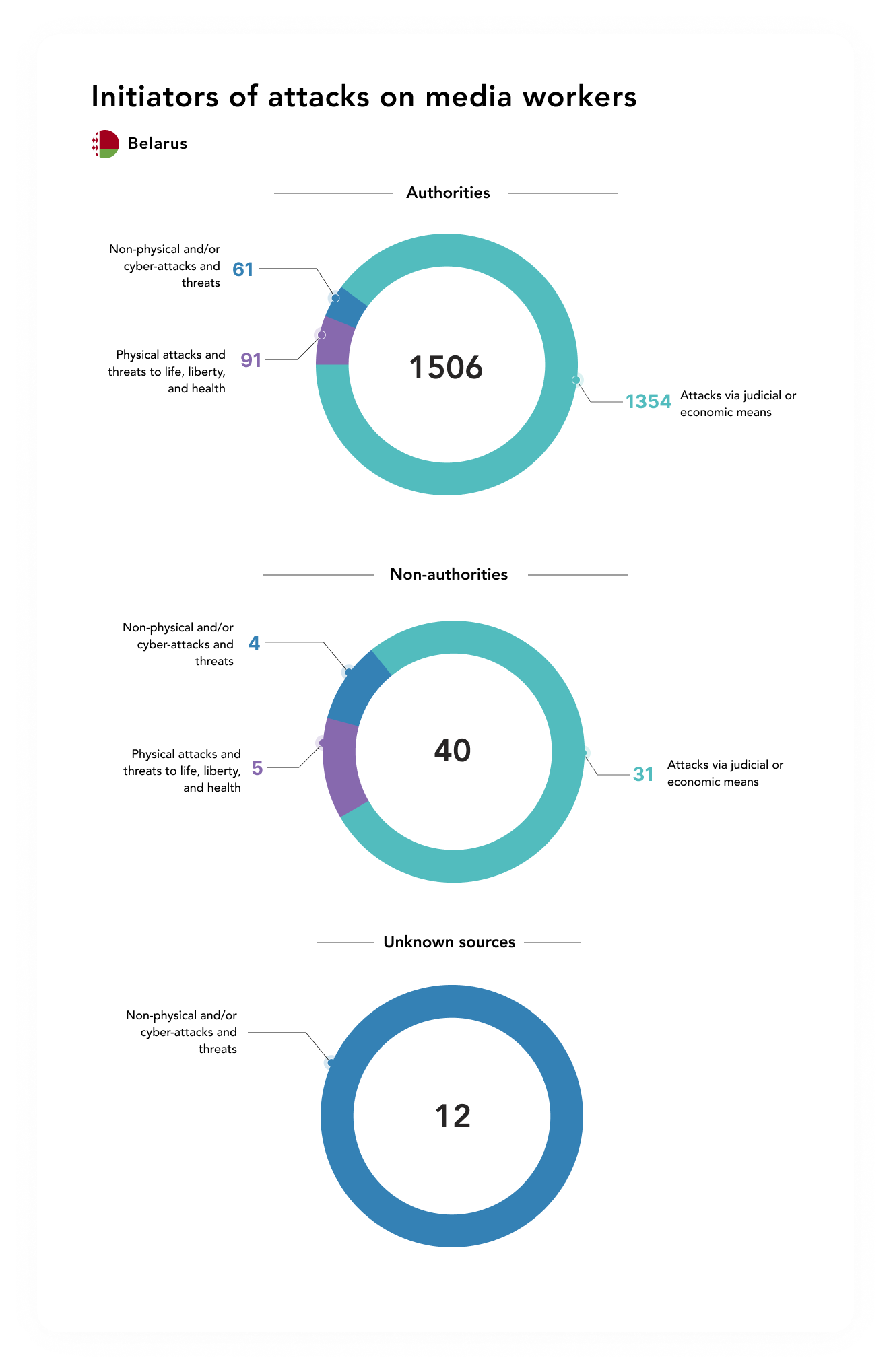
In 2020, the actions of the authorities with respect to restricting freedom of expression of opinion acquired a systemic nature and a hitherto unseen scope. Pressure was being exerted in all spheres associated with the media, with the use of the following repressive measures:
- detentions and arrests of journalists, oftentimes with the use of violence, damage to and impounding of professional equipment, and removal of material that had already been shot;
- initiation of criminal cases against journalists and media specialists;
- blocking of the internet in the first days after the elections and constant restrictions on mobile internet during mass protests;
- restriction of access to internet sites independently covering the political situation, obstacles to the printing and distribution of several non-state newspapers;
- revocation of the status of a media outlet for the largest internet portal in Belarus, TUT.by;
- recognition of NEXTA‘s popular Telegram channel and logo as extremist materials;
- denials of accreditation to foreign correspondents who had come for the elections and subsequent revocation of accreditation for all correspondents of foreign media outlets;
- dismissals,harassment and persecution of state media outlet journalists who had spoken out against the dissemination of unreliable propagandistic information.
For the purposes of more precisely reflecting combination assaults on media workers in 2020 we are introducing a new category of attacks – hybrid.
We are calling systematic persecution of some publication or media worker with the use of tools from two or more categories of assaults – physical, non-physical, and judicial/economic – “hybrid”. Such a combination of means involving and not involving force with judicial means of pressure on undesirable journalists is carried out with a view to demoralising them or getting them to self-censor or to give up the profession or even life itself.
In 2020, 162 hybrid attacks were recorded. Presented below is the list of the journalists and bloggers who were being subjected to the most intensive hybrid attacks in 2020.
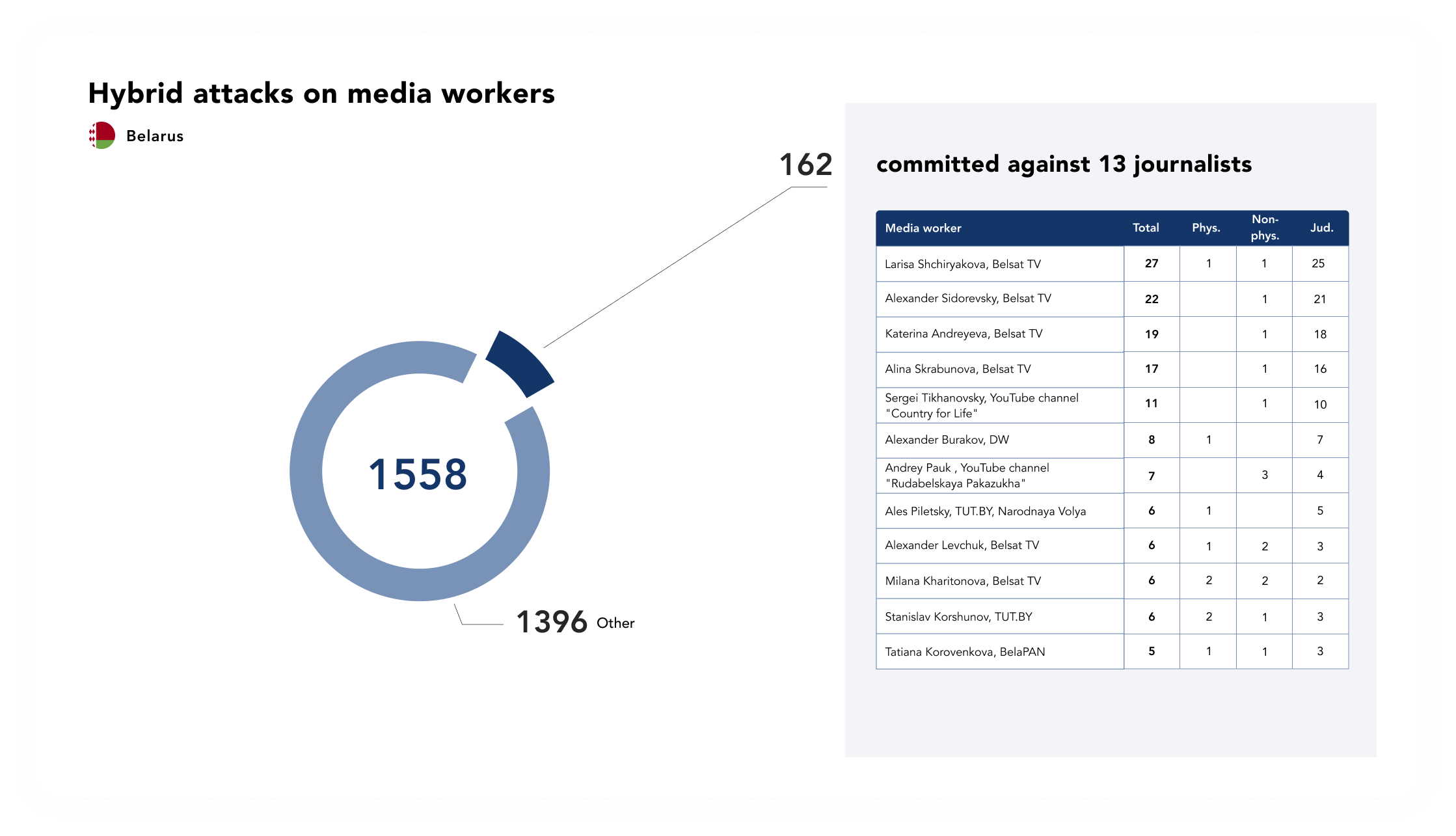
4/ PRESSURE ON MEDIA WORKERS UNDER THE PRETEXT OF RESTRICTIONS CONNECTED WITH THE COVID-19 PANDEMIC
Belarus turned out to be one of the few European countries in which quarantine was not declared in connection with COVID-19. Furthermore, for a long time the authorities were denying the seriousness of the illness. President Alexander Lukashenko [“Lukashenka” in Belarusian] was calling the pandemic a “psychosis” and an “infodemic” and called upon the Ministry of Information and the state security services to fight the disseminators of “hype” on the subject of COVID-19.
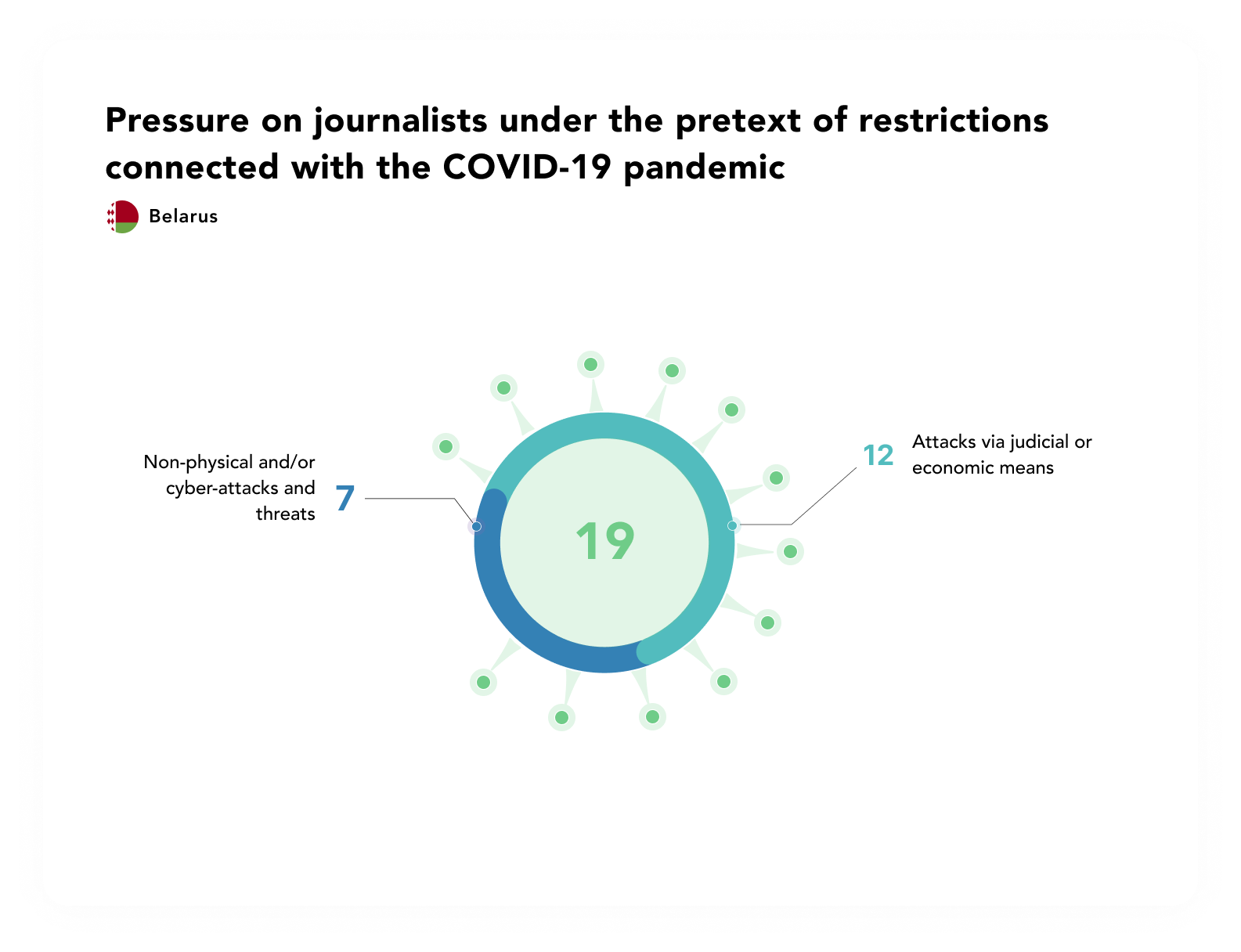
On 21 March, Lukashenko publicly addressed the chairman of the State Security Committee with a call to “deal with the lowlifes who are putting out these hoaxes” [about deaths from COVID-19 – Ed.]: “Enough of looking at this. We need to go through these sites and channels nice and thorough”.
A total of 19 attacks on journalists in connection with the coronavirus were recorded: 7 non-physical and/or cyber-attacks and threats and 12 attacks via judicial and/or economic means. All of the attacks came from representatives of the authorities.
The most widespread method of pressure was illegal impediments to journalistic activity or denial of access to information (8 incidents), when journalists were not being allowed into hearings and/or court sessions due to quarantine restrictions (in the absence of an announced quarantine). The last briefing by the Ministry of Health for journalists at which they could pose questions to representatives of the ministry took place on 17 April. After this, the Ministry of Health has been furnishing contradictory information only through its press releases.
Another widespread method of pressure became charges of administrative violations and fines for “illegal dissemination of information in the mass information media” (5 incidents).
- On 6 April, the Ministry of Information issued the owner of the net publication Media-Polesye a written warning about violation of the law On Mass Information Media. The pretext became a publication about the spread of the coronavirus in Luninets, which contained erroneous information about the death of a patient. It is worth noting that the error was corrected 15 minutes after the appearance of the text on the site.
- On 21 April, journalists Larisa Shchiryakova [Larysa Ščyrakova] and Andrey Tolchin [Andrej Tolčyn] were served with an administrative offence report from the Homyel [formerly spelled “Gomel”] central district administration of the police for illegal dissemination of information in the mass information media. On 20 March, they had recorded a short video interview about the quarantine due to the coronavirus with students at the Francisk Skorina University. The video was used by the Belsat satellite channel.
- On 13 May, the court of Luninets District fined the editorial office of the Media-Polesye internet site 120 base values ([about 1250 euros). The court decreed that information on Media-Polesye associated with the coronavirus had inflicted harm to the national interests of the Republic of Belarus.
- On 2 June, a Homyel Region court fined independent journalist and BAJ member Larisa Shchiryakova 675 roubles. The court found her guilty under article 22.9 of the CoAV (violation of legislation on the mass information media). Serving as the reason was a photo essay for the Belsat channel from the village of Kommunar of Buda-Kashalyova District of Homyel Region, about the first case of coronavirus in a year three [third grade] pupil and the hospitalisation of 39 residents of the village – schoolchildren, their parents, teachers, and a doctor from the local polyclinic.
Three journalists had their accreditation cancelled under the pretext of the pandemic:
- On 6 May, the MFA of Belarus revoked the accreditation of journalists from the Russian Channel One Alexey Kruchinin and Sergey Panasyuk. MFA press secretary Anatoly Glaz [Anatol Hlaz] clarified that “the decision has been adopted in connection with the dissemination of information not corresponding to reality”. This took place after the appearance of a story on the situation with the coronavirus in Belarus.
- On 11 June, journalists of the leading independent news agency, BelaPAN, who had previously received accreditation for a session of the Chamber of Representatives (the lower chamber of the Belarusian parliament), had it cancelled under the pretext of the pandemic (which was officially not being acknowledged in Belarus).
5/ PHYSICAL ATTACKS AND THREATS TO LIFE, LIBERTY AND HEALTH
The graph below represents the total number of physical attacks and threats to life, liberty and health. The number of physical attacks on journalists in 2020 grew more than four-fold in comparison with the sum total number of such attacks over the three preceding years. The vast majority of such attacks were associated with coverage of mass protests by reporters.

Police employees were assaulting the journalists in 91 instances out of 96. Violence was used against journalists from both Belarusian and foreign media outlets, when they were executing their professional duties, as they were being detained, and in places of detention.
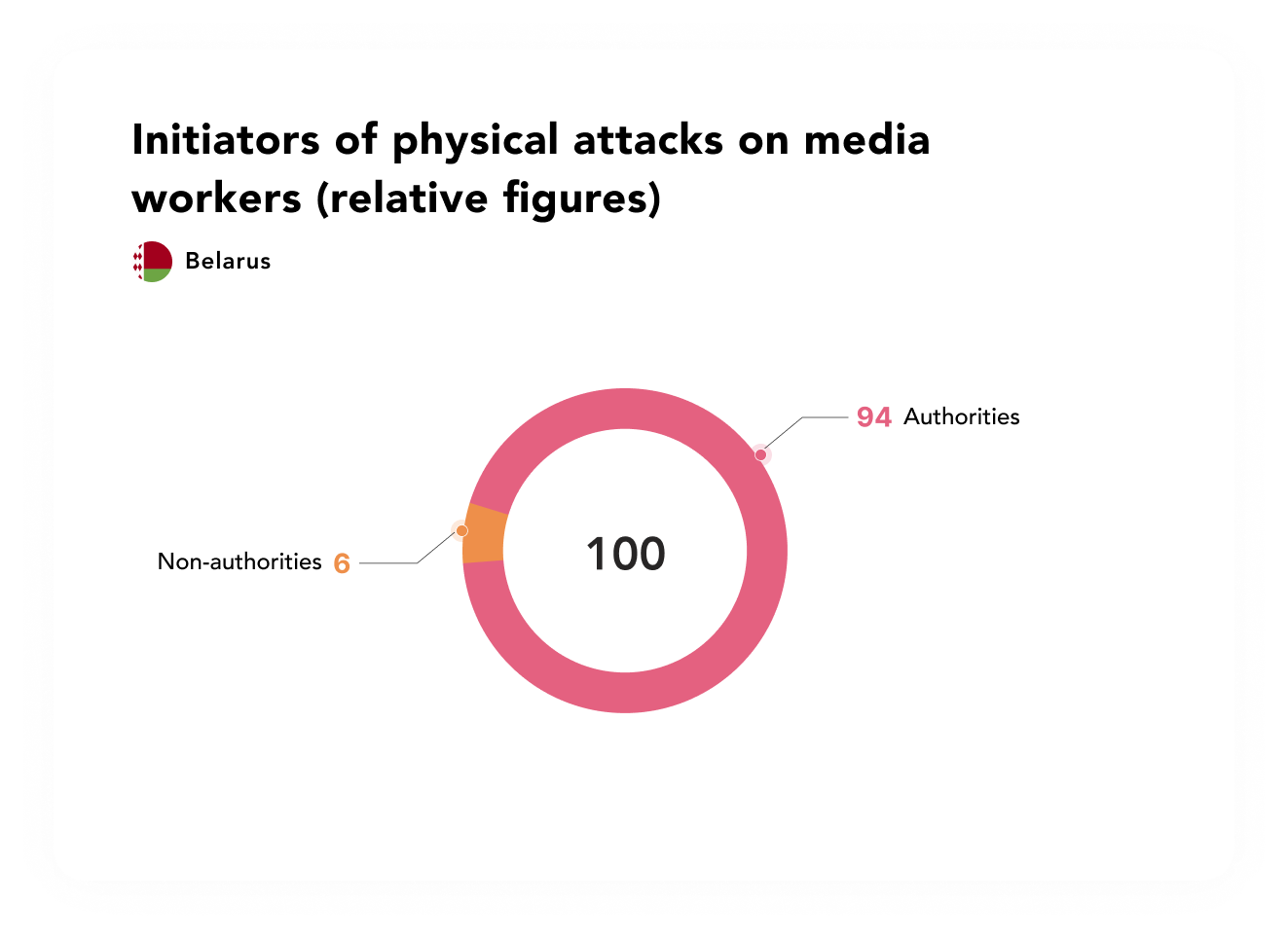
Three instances were recorded in Minsk of the use of firearms in relation to female journalists during work at protests, as a result of which they were wounded:
- On 9 August, Emilie van Outeren, a journalist with the NRD Handelsblad newspaper (Netherlands), was wounded in the thigh by an unknown projectile after riot police began strafing demonstrators.
- On 10 August, Nasha Niva journalist Natalia Lubnevskaya [Natallja Lubneŭskaja] was wounded by a rubber bullet when one of the employees of the law enforcement agencies stopped 10 metres from a group of journalists in blue “Press” vests and shot the journalist in the leg. Lubnevskaya spent over a month in hospital; the after-effects of the injury are still ongoing.
- On 11 August, a BelaPAN freelance journalist was wounded by a rubber bullet whilst covering a forcible dispersal of a peaceful protest.
Another three journalists – documentarians with the Neizvestnaya Belarus’ [The Unknown Belarus] project (Nastoyashchee vremya [Current Time]) Vladimir Mikhailovsky, Maksim Gavrilenko, and Lyubov Zemtsova – perished as the result of an automobile crash that occurred on 14 May on the Homyel – Minsk road. In Homyel, the documentarians had been shooting a film about how volunteers are helping medical personnel in the fight with the coronavirus.
6/ NON-PHYSICAL AND/OR CYBER-ATTACKS AND THREATS
The graph below represents the total number of non-physical and/or cyber-attacks and threats. The most widespread types of non-physical attacks and threats over the period under consideration were illegal impediments to journalistic activity (28 incidents); bullying, intimidation, pressure, threats of violence and death, including cyber- (27 incidents and damage to/seizure of property, vehicles, equipment, documents, printed copies of a periodical (12 incidents). The quantity of such attacks grew significantly in comparison with previous years.
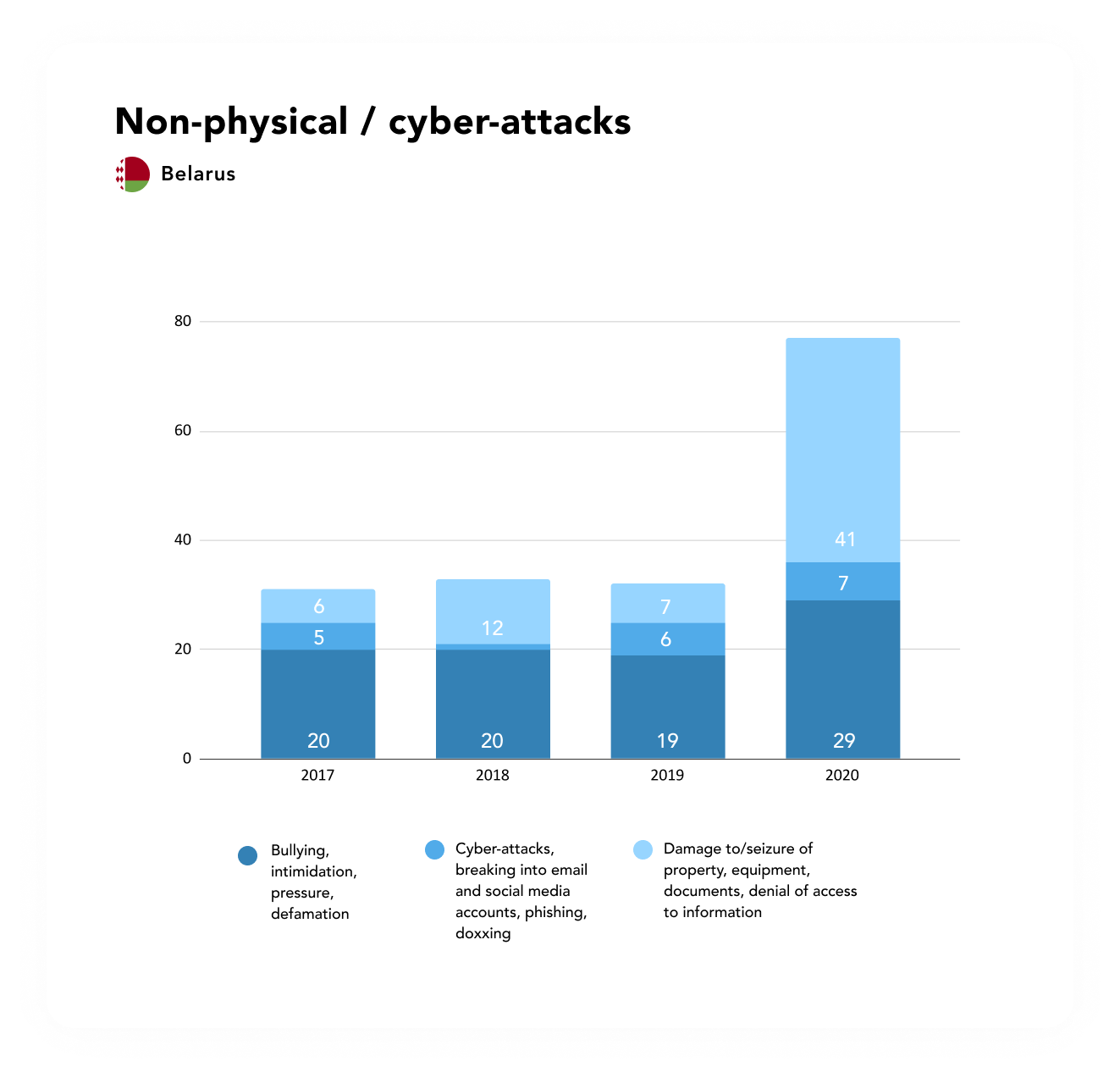
7/ ATTACKS VIA JUDICIAL AND/OR ECONOMIC MEANS

Appearing as the main initiator of attacks against media outlets, journalists, and bloggers in Belarus were representatives of the authorities. They stood behind 1354 out of 1385 recorded attacks via judicial and/or economic means (84% of the incidents).
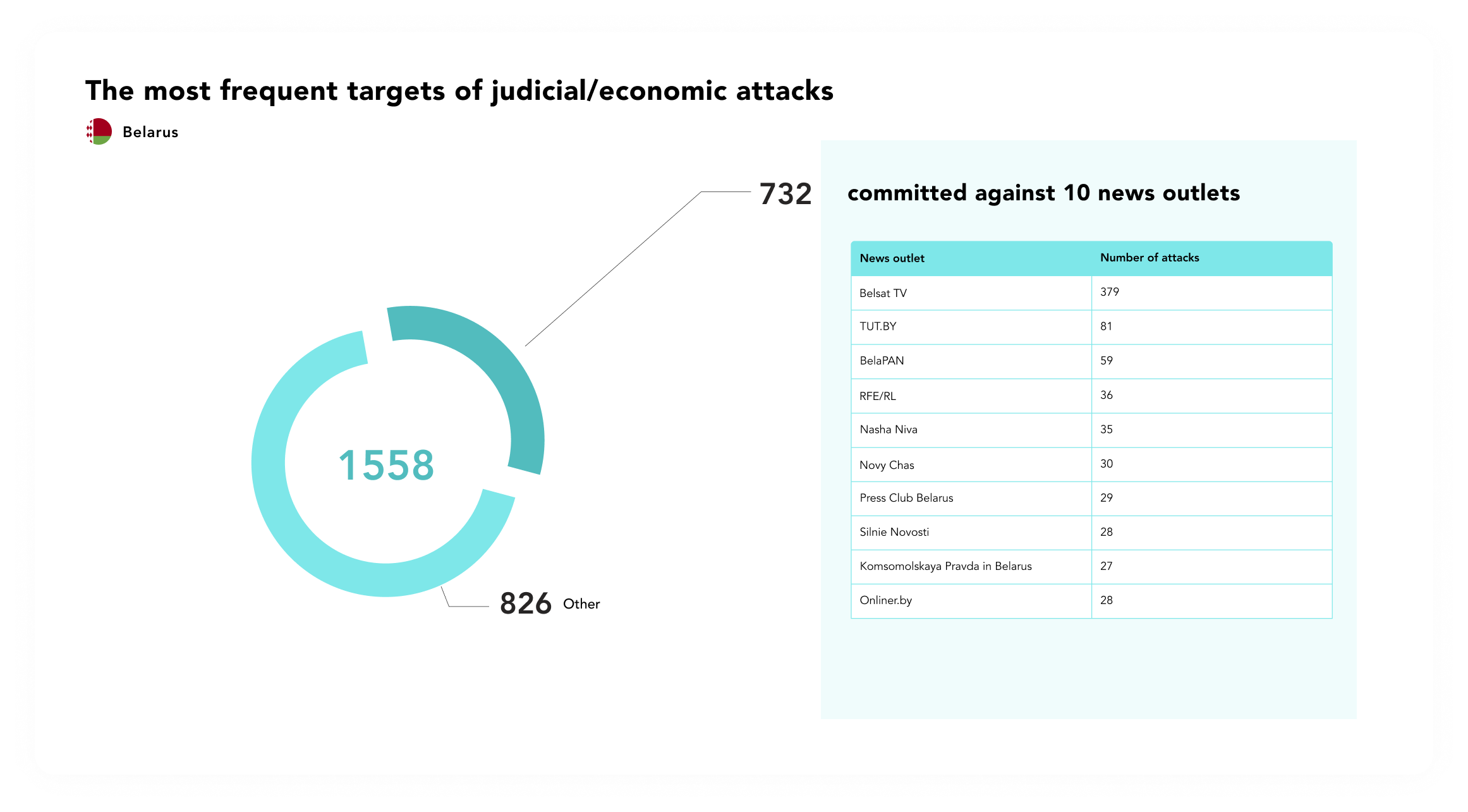
The top 5 methods of pressure on journalists in Belarus in 2020:
- short-term detention (297 incidents)
- administrative arrests/remand/pre-trial detention/prison (216 incidents)
- court trials (217 incidents)
- administrative offence, fine (175 incidents)
- confiscation/seizure of property, equipment, documents (83 incidents)
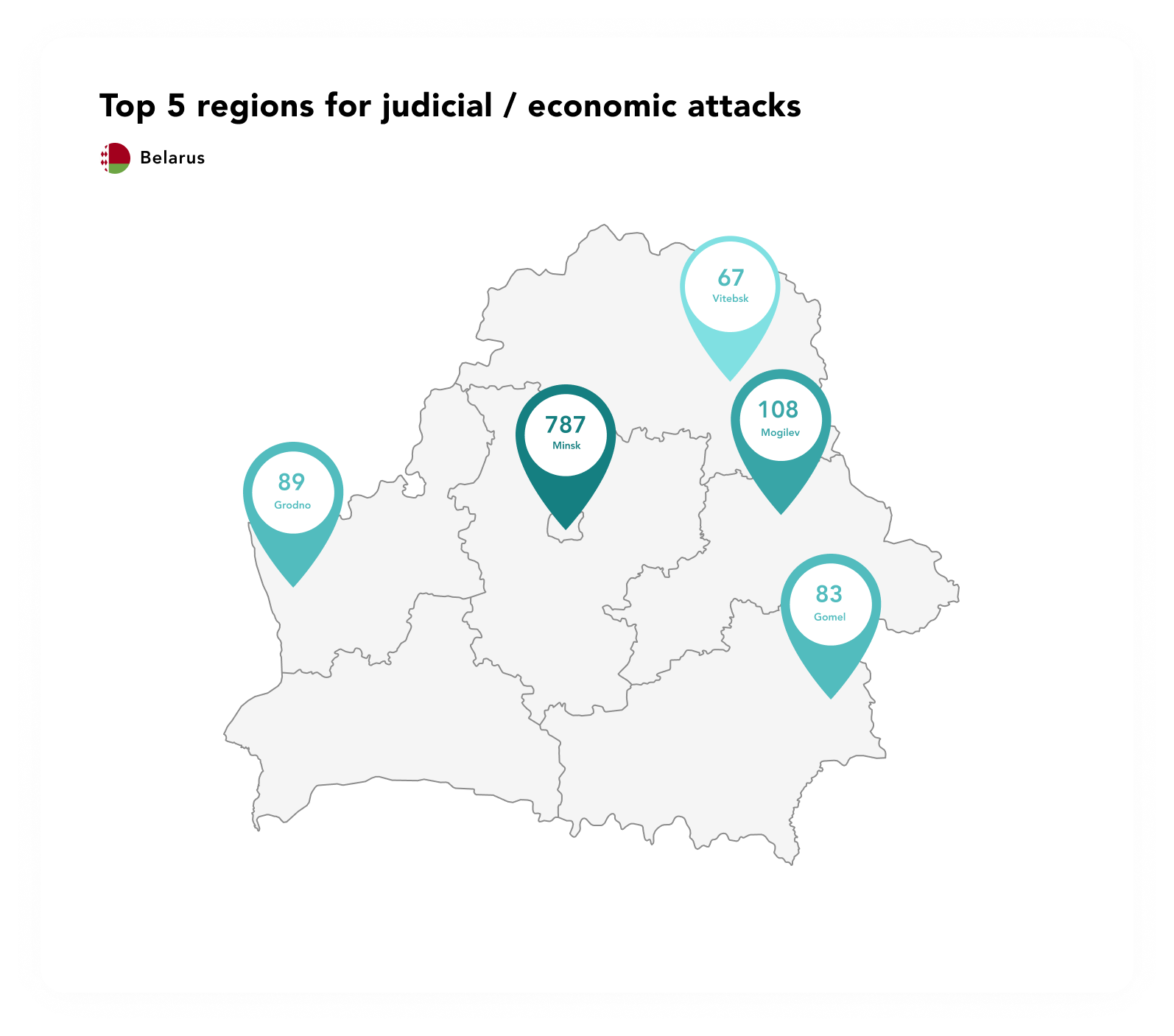
The quantity of fines for Belarusian freelance journalists working with foreign media outlets without the accreditation of the Ministry of Foreign Affairs declined somewhat – 33 (journalists were held administratively liable under this article of the CoAV 118 times in the “peak” year of 2018). This is connected above all with the fact that in the majority of the situations, instead of fines the courts were selecting another form of liability – administrative arrest for participation in illegal mass events and resisting employees of the police. Taking instances of longer-term detention in criminal cases into account, journalists and media workers spent 1200 days in aggregate behind bars in the course of the year.
- Sparking the biggest outcry was the criminal prosecution of Belsat television channel journalists Katerina [Katsjaryna] Andreyeva and Daria Chultsova for broadcasting a live stream from a mass protest event (they are charged with organising mass protests). On 18 February 2021, a court sentenced the journalists to two years in a prison colony.
- Internet portal TUT.by journalist Katerina Borisevich [Barysevič]’s “zero per mille” case became a high-profile one. She was charged with violating doctor-patient confidentiality: she had reported information furnished by a doctor that contrary to the authorities’ assertions, there was no alcohol in the blood of the dead activist Roman Bondarenko [Raman Bandarenka]. On 2 March 2021, a court sentenced the journalist to six months in a prison colony and fined her 100 base values (1000 US dollars).
- A criminal case was initiated against the investigative journalist Sergey [Sjarhej] Satsuk for supposedly receiving a bribe whilst raising funds for investigations.
- A criminal case was initiated against the managers and journalists of the “Press-club” under the pretext of the violation of tax legislation by them.
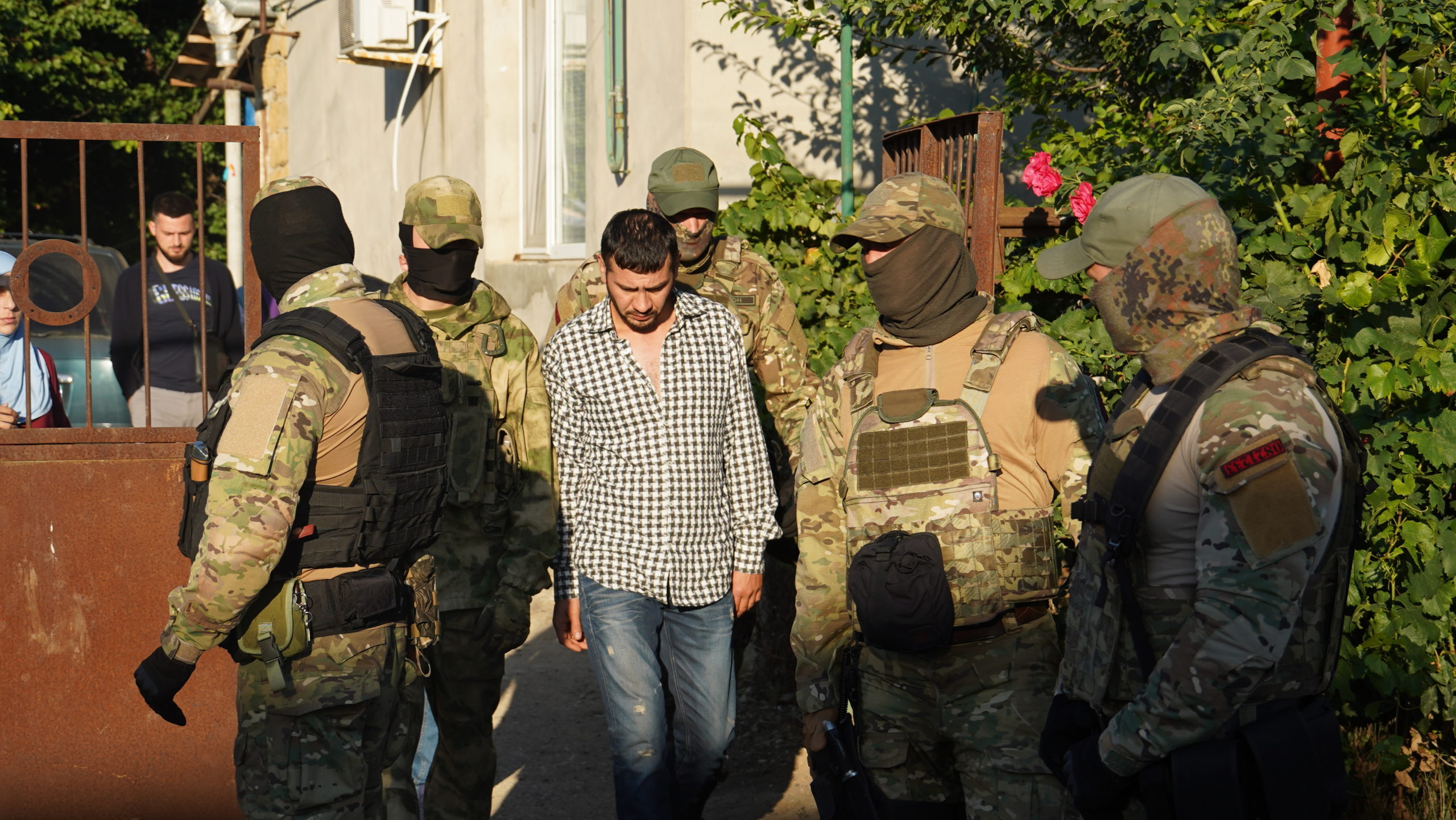
CRIMEA
Author of the report – Human Rights Centre ZMINA
1/KEY FINDINGS
58 instances of attacks/threats in relation to professional media workers and citizen journalists, editorial offices of traditional and online publications and Telegram channels, as well as online activists, that took place in 2020 on the Crimean Peninsula were identified and analysed in the course of the research. The data for the study were obtained from open sources in the Russian language using the method of content analysis, as well as with the use of the Human Rights Centre ZMINA’s own sources in Crimea (the information was checked by Centre employees). A list of the main sources is presented in the Annex 6.
- The principal method of pressure on journalists, bloggers, and media workers in Crimea is attacks via judicial and/or economic means.
- The main source of threats for media workers are representatives of the authorities (in 50 instances out of 58), while the most widespread method of pressure is charges of extremism, links with terrorists, inciting hate, rehabilitation of Nazism, high treason or calling for the overthrow of the constitutional order.
- There were 9 attacks connected with quarantine restrictions recorded in 2020. These were predominantly expressed in the actions of court bailiffs, who were not granting journalists access to politically-motivated court trials.
- There were 4 instances of physical attacks and threats to the life, liberty, and health of media workers recorded in Crimea in 2020. The given kind of attacks is no longer dominant, in contrast with 2014, when a record numberof violations of the rights of journalists with the use of force was recorded.
- The course taken by the new authorities from the moment of the occupation in 2014 to totally suppress independent journalism and establish full control over Crimea’s information space continues.
2/THE POLITICAL SITUATION AND THE MEDIA IN CRIMEA
Crimea was not studied as a separate region in the Reporters Without Borders World Press Freedom Index 2020rating. In the Freedom House human rights organisation’s Freedom in the World – 2020 annual report about the situation with civil and political rights, Crimea has been included in the group of “not free countries and territories” with a score of 7 points out of 100; furthermore, a deterioration of 2 points is noted in the situation in the sphere of political rights. A situation with freedom that is worse than that in Crimea, according to Freedom House’s assessments, can be observed in only 9 countries/territories of the world, including Turkmenistan, North Korea, Tibet, Syria, and the territory of the Donbass that is not under the control of the Ukrainian authorities.
PERSECUTION OF CITIZEN JOURNALISTS
After the occupation of Crimea in 2014, the peninsula’s independent media outlets were completely destroyed. Professional journalists and editorial offices that tried to continue their work were being subjected to systematic pressure, intimidation, and other forms of systematic persecution, including harassment and other methods of attacks by the new authorities and those helping them. Many journalists left the profession or were forced to leave for the mainland part of Ukraine’s territory.
In subsequent years, the occupation forces switched to using judicial mechanisms for intimidating journalists and bloggers. This trend continued in 2020 as well.
In the conditions of an “information ghetto” and a lack of independent sources of news on the peninsula, the phenomenon of “citizen journalism” has appeared. Nowadays, it is entirely thanks to ordinary citizens and civic activists that events taking place on the peninsula are receiving coverage, especially arrests, searches, and politically motivated court trials.
One of the best-known initiatives, which has brought together many citizen journalists, is Crimean Solidarity, which was founded in 2016 through the efforts of the relatives of political prisoners, lawyers, and activists as an informal human rights organisation to protect victims of political repression. With time, the Crimean Tatar citizen journalists who were creating and disseminating news about politically motivated criminal and administrative cases in Crimea became a new target for prosecutions. Charges were brought against many of them within the framework of the “case of the Crimean Muslims” for involvement in terrorism and Hizb ut-Tahrir (an organisation that was banned in the Russian Federation by a Supreme Court decision in February 2003; however, it functions legally in Ukraine and the majority of the world’s countries). As of the end of 2020, 8 Crimean Solidarity citizen journalists find themselves in places of deprivation of liberty (Server Mustafayev, Timur İbragimov, Marlen Asanov, Seyran Saliyev, Remzi Bekirov, Ruslan Suleymanov, Osman Arifmemetov, and Rustem Şeyhaliyev); yet another one (Amet Suleymanov) finds himself under house arrest. On 21 September 2020 the Crimean Solidarity media coordinator, Crimean Tatar activist and blogger Nariman Memedeminov, who spent 2.5 years in a Russian penal settlement-colony, was released from prison.
Several trials of Crimean Tatar citizen journalists were heard in court in 2020. On 16 September 2020, the Southern District Military Court of the RF issued a verdict in the so-called case of the “second Bağçasaray [also spelled “Bakhchysarai”] Hizb ut-Tahrir group”, the figurants in which were found guilty of preparing a forcible seizure of power and participating in the activity of a terrorist organisation. The defendants in this case included 4 citizen journalists from the Crimean Solidarity civic association: Server Mustafayev was sentenced to 14 years of imprisonment in a strict regime colony, Seyran Saliyev to 16 years, Timur İbragimov to 17 years, and Marlen Asanov to 19 years.
In December, the Southern District Military Court of the RF began hearing the so-called case of the “second Simferopol Hizb ut-Tahrir group”, the members of which are being charged with preparing a forcible seizure of power and participating in the activity of a terrorist organisation. The defendants in this case include 4 citizen journalists from the Crimean Solidarity civic association: Remzi Bekirov, Osman Arifmemetov, Rustem Şeyhaliyev, and Ruslan Suleymanov.
BLOCKING OF UKRAINIAN MEDIA OUTLETS
The situation regarding the blocking of access to a whole series of Ukrainian media resources on the territory of Crimea remained unchanged in 2020. According to the data of a Crimean human rights group, a minimum of 11 providers in 9 Crimean population centres have completely blocked 20 Ukrainian media websites: Ukrinform,Censor.net, QHA Crimean News Agency, SLED.net.ua, Information Resistance, UAinfo, BlackSeaNews, Apostrophe, Glavnoe, Hromadske Radio, Centre for Journalistic Investigations, Levyy Bereg [LB.ua], Podrobnosti, Strichka, ToNeTo, TSN, Ukrayinskapravda, RBK Ukrayina, Dzerkalo Tyzhnia [Mirror Weekly], and Kherson Daily. Additionally, some providers are blocking another 4 Ukrainian media outlets: the Glavcom, 5 Kanal, 112 Ukraine, and Depo websites are inaccessible through nine out of eleven providers. It is worth noting that some of these resources are accessible for users in Russia. Additionally, reception of the signal of Ukrainian FM radio stations in the north of Crimea has worsened significantly, while in many population centres Russian radio stations are broadcasting on these frequencies.
Representatives of the occupation authorities continue to regard independent sources of information on the territory of Crimea as a threat and as the adversary’s tools in an information war, while considering the principal task of media outlets in the region to be a defence against “enemy” distortion of the facts.
LEGISLATIVE REGULATION OF THE ACTIVITY OF MEDIA OUTLETS AND JOURNALISTS
A whole series of new normative-legal acts, the effects of which extend to the territory of Crimea, were adopted in the Russian Federation in 2020.
On 1 April 2020, president Vladimir Putin signed a law that introduces new articles to the Criminal Code: 207.1 (“public dissemination of knowingly false information about circumstances presenting a threat to the life and safety of citizens “) and 207.2 (“public dissemination of knowingly false socially significant information entailing grave consequences”). Falling under the norms of these articles is information about measures being undertaken to ensure security in the conditions of the COVID-19 pandemic. In addition to this, in the Code on Administrative Offences, article 31.15 (“abuse of freedom of mass information”) was supplemented by two items: “dissemination of knowingly unreliable information about circumstances presenting a threat to the life and safety of citizens” (item 10.1) and “dissemination of knowingly unreliable information entailing death, harm to health, mass breach of security” (item 10.2).
Changes to the law “On the federal security service” [the FSB] entered into force on 1 August; its article 7 now has the language: “Publication (posting, dissemination) of informational materials, concerning the activities of bodies of the federal security service, without a corresponding opinion from a body of the federal security service shall not be permitted.” It can not be said with confidence from the general context of the article whether this restriction is only for FSB employees or if it extends to all citizens.
Amendments to article 280.1 of the Criminal Code (“public calls for implementing acts aimed at violating the territorial integrity of the Russian Federation”) entered into force on 8 December;prescribing administrative prejudgment and the onset of criminal liability in the event of a repeat violation over the span of a year. A new article, 20.3.2 on “calls for separatism”, prescribing punishment in the form of fines, was introduced into the Code on Administrative Offences at the same time.
3/ GENERAL ANALYSIS OF ATTACKS
38 attacks via judicial and/or economic means, 16 non-physical and/or cyber-attacks, and 4 physical attacks were identified in the course of the research.
Physical attacks were not dominant in 2020, in contrast with 2014, when the greatest quantity of violations of the rights of journalists with the use of force were committed. Thus, more than 100 instances of physical attacks on journalists were recorded during the active phase of the armed occupation from 26 February through 22 March 2014, including beatings, abductions, and torture. Arbitrary detentions, damage to property, prohibition of video shoots and denial of access to the peninsula, as well asvarious threats and intimidations, took place as well. Such acts were perpetrated primarily by paramilitary formations of “Cossacks” and “militias” under the control of the RF.
4/ PRESSURE ON JOURNALISTS UNDER THE PRETEXT OF RESTRICTIONS CONNECTED WITH THE COVID-19 PANDEMIC
A “state of high alert”, not prescribed in legislation, has been introduced in Crimea as of 17 March 2020 in connection with the pandemic. The set of restrictions within the framework of this state has been changed on numerous occasions, and a series of prohibitions continues to be in effect to this day.
On 3 April, within the framework of the “state of high alert”, everyone except life-support services workers was prohibited from leaving their place of residence. An exception was made for journalists from the pro-government Krym television channel. Journalists from other registered media outlets having the opportunity to draw up official editorial assignments received the right to leave their place of residence on 14 April. Bloggers, citizen journalists, and non-staff employees of media outlets were restricted in the right of movement until 18 May 2020.
On 10 June, by decree of the “Council of Judges of the Republic of Crimea”, access to court sessions was completely ruled out for persons who are not participants in the trial. As such, journalists were deprived of the opportunity to cover socially significant court trials, including political and religious persecutions, as well as examinations in environmental damage cases. This restriction continues to be in effect to this day; that being said, judges can establish the quantity of journalists for whom it is permitted to be present as attendees at their own discretion.
9 attacks connected with quarantine restrictions were recorded in 2020. All of them consist of non-physical and/or cyber-attacks and threats. They were predominantly expressed in the actions of court bailiffs, who were not granting journalists access to politically motivated court trials, citing coronavirus restrictions.
- On 24 March, the press service of the head of Crimea asked representatives of the mass information media to temporarily restrict visits to the Council of Ministers due to the situation with the coronavirus. Despite the recommendatory character of the request, access for journalists to the Council of Ministers building was terminated and has not been reinstated to this day.
- On 19 and 22 May, two sessions took place in the Central District Court of Simferopol in the case of former political prisoner Edem Bekirov, released in an exchange and subsequently declared a wanted fugitive. Bailiffs announced to a Crimean Process journalist and other attendees at the entrance to the courthouse that only participants in the trial were being let into the building in connection with measures to prevent the spread of the coronavirus infection.
- On 26 June, an examination took place in the Kiev District Court of Simferopol of a complaint by lawyer Nikolai Polozov, a motion for whose dismissal had been brought by an investigator in a criminal case in relation to the head of the Mejlis of the Crimean Tatar People, Refat Çubarov. Bailiffs announced to a Crimean Process journalist and other attendees at the entrance to the courthouse that only participants in the trial were being let into the building.
- On 19 October, a repeat examination of a criminal case in relation to a participant in the Jehovah’s Witnesses religious community, Viktor Stashevsky, began in the Gagarin District Court of Sevastopol. Bailiffs announced to a Crimean Process journalist and other attendees at the entrance to the courthouse that only participants in the trial were being let into the building.
5/ PHYSICAL ATTACKS AND THREATS TO LIFE, LIBERTY, AND HEALTH
4 physical attacks and threats to the life, liberty, and health of media workers were recorded in 2020, including two instances of the use of punitive psychiatry and two non-fatal attacks in the course of a conflict situation with a Krym 24 television channel camera crew.
- It became known on 24 June that Crimean Solidarity citizen journalist Ruslan Suleymanov had been forcibly sent to the Crimean Psychiatric Hospital for the conducting of a forensic psychiatric evaluation. Suleymanov spent no less than a month in the psychiatric hospital.
- On 26 October a Krym 24 camera crew (journalist Dmitry Popov and camera operator Maxim Savenkov) entered onto the territory of a private housing estate in search of the owner of an illegal building site in a nature reserve. A man lunged at the journalist, and then inflicted several blows to the camera operator and damaged the video camera. Later the assailant caught up with Popov and Savenkov and was throwing stones.
- On 16 January, Crimean Solidarity citizen journalist Rustem Şeyhaliyev was forcibly sent to the Crimean Psychiatric Hospital for the conducting of a forensic psychiatric evaluation. Şeyhaliyev spent no less than a month in the psychiatric hospital.
6/ NON-PHYSICAL AND/OR CYBER ATTACKS AND THREATS
The most widespread method of pressure on media workers, bloggers, and online activists is illegal impediments to journalistic activity, denial of access to information (12 incidents, 9 of which are attacks connected with restrictions within the framework of quarantine measures). In 11 instances out of 16, the attacks came from representatives of the authorities.
Illegal impediments to journalistic activity, denial of access to information was expressed primarily in the actions of court bailiffs and the conducting of trials behind closed doors.
- On 24 April, during the filming of a story about illegal construction inside the boundaries of the Qaradağ nature reserve, a camera crew from the Vesti Krym television channel encountered attempts by the site’s security to prohibit the shoot and threats to block the camera operator’s movements.
- On 27 October, examination began in Crimea’s Kirov District Court of a criminal case in relation to a participant in the Asker volunteer organisation, Mecit Ablâmitov. Bailiffs at the entrance to the courthouse announced to a Crimean Process journalist and other attendees that the session was going to take place behind closed doors. They refused to let the journalist enter the building. All further sessions in the case were likewise taking place without the participation of attendees and journalists.
- On 2 September, an appellate complaint against a measure of restraint in relation to the participant in the Asker volunteer organisation Mecit Ablâmitov was examined in the Supreme Court of Crimea. Bailiffs at the entrance to the courthouse announced to a Crimean Process journalist and other attendees that the session was going to take place behind closed doors. They refused to let the journalist pass through into the building for the reading of the court decree.
Likewise noted were single isolated cases of attacks such as “bullying, intimidation, pressure, threats of violence and death, including cyber-“, “breaking into email/social media accounts/computer/smartphone”, “defamation, spreading libel about a media worker or media outlet”, and “damage to/seizure of property, vehicles, equipment, documents, journalistic materials, print run”.
- On 18 November, a publication without a byline appeared on the Novoros.info publication’s website, in which editor of the Crimean Tatar newspaper Qırım Bekir Mamut was called a supporter of a banned organisation and a radical and was accused of publishing anti-Russian articles, as well as doubt being cast on the legality of the activity of the Qırım publication in Crimea.
- On 24 November, after a three-day absence of publications on the Zorro iz Kryma [Zorro from Crimea] Telegram channel, a report appeared about how the authors of the social media channel had been “revealed, identified, and conducted educational work” [sic], while all their correspondence with sources of information had been “documented”. Contained in the report was a call addressed to “all who have not passed the point of no return” to come to their senses. After this the channel stopped being updated.
7/ ATTACKS VIA JUDICIAL AND/OR ECONOMIC MEANS
The principal methods of pressure in the given category are charges of extremism, links with terrorists, inciting hate, high treason, calling for the overthrow of the constitutional order, rehabilitation of Nazism (12), short-term detention (5), and court trials (5).
Blocking of Ukrainian online publications (including Crimean media outlets working in exile on the mainland part of Ukraine) and FM radio stations continued throughout the course of 2020. Thus, monitoring of access to internet resources in December 2020 conducted by a Crimean human rights group among 11 of Crimea’s internet providers showed that a minimum of 25 Ukrainian websites were being fully blocked, and another 5 partially (in individual districts and/or by individual operators). Monitoring of FM band broadcasting in the north of Crimea showed that the signal of Ukrainian radio stations is accessible in only 7 out of 19 population centres. Blocking of signals is implemented by way of broadcasting Crimean and Russian radio stations on the frequencies of Ukrainian broadcasters.
Attacks on Crimean citizen journalists and bloggers by means of visits to them at home by employees of the law-enforcement agencies became more frequent in 2020. Cautions about the impermissibility of extremist acts were read out in the course of such visits (8 incidents). It was being asserted that it was supposedly known with certainty to the police that that or the other journalist was an organiser of or participant in planned disorders and other extremist actions.
- On 25 March, blogger Rolan Osmanov received a “warning about the impermissibility of extremist activity”. What was being spoken of in the caution was that supporters of the Mejlis of the Crimean Tatar People, which is banned in the RF, were planning to conduct unapproved mass events in this period.
- On 26 March, in Nizhnegorsk, cautions about the impermissibility of extremist acts were issued to at least 10 Crimean Tatars. Among them was the citizen journalist with Crimean Solidarity Ayder Kadyrov, who was detained 5 months later as a suspect in a criminal case related to terrorism.
- On 2 April, a police employee drove to Crimean Solidarity citizen journalist Nuri Abdureşitov‘s home and was trying to conduct an interrogation, and later read out a caution about the impermissibility of extremist activity to the journalist.
- On 17 April, three Crimean Solidarity citizen journalists from different regions of Crimea —Kulamet İbraimov, Emin Rustemov, and Nuri Abdureşitov— received cautions from law-enforcement agencies about the impermissibility of extremist activity. Rustemov and Abdureşitov noted that they had already received such cautions earlier.
- On 21 April, a field operative drove up to the home of Elmaz Akimova, a citizen journalist with the Nefespublication, conducted questioning about the place of her work and plans for the immediate future, and posed a series of other questions, after which he served her with a caution about the impermissibility of extremist acts.
- On 1 May, police precinct employee Vladislav Sadovoy served citizen journalist Lutfiye Zudiyeva with two cautions about the impermissibility of extremist acts. Zudiyeva subsequently appealed these acts in court, and during the time of the examination MVD [Ministry of Internal Affairs] employees could not substantiate the necessity of such a caution.
Court trials on charges of terrorism have likewise been one of the widespread methods of pressure on citizen journalists, bloggers, and online activists in Crimea over the span of recent years (5 incidents in 2020). All criminal cases such as these, in relation to citizen journalists, end with guilty verdicts. The charges in these cases are preceded by searches, detentions, interrogations, arrests, and often forced forensic psychiatric evaluations with the persons under investigation being held in psychiatric treatment institutions for a lengthy period of time.
- On 11 March, searches took place in the homes of five Crimean Tatar families in Bağçasaray [Bakhchysarai], including the house where Crimean Tatar television channel ATRC journalist Seytumer Seytumerov previously resided. FSB employees consider him to be the organiser of a terrorist cell, but the journalist himself asserts that the accusations are baseless. During the time of the first search in 2017 no charges were brought against him, and after that he was able to leave Crimea.
- On 11 March, a search was likewise conducted in the home of Crimean Solidarity citizen journalist Amet Suleymanov. The next day a measure of restraint in the form of house arrest was selected for Suleymanov in a case of “participation in the activity of a terrorist organisation”. The measure was subsequently extended on several occasions.
- On 11 March, the Kiev District Court of Simferopol extended the measure of restraint in the form of detention for citizen journalist Remzi Bekirov of the Crimean Solidarity association. In the course of the session it became known that an additional charge had been laid against Bekirov under article 278 of the Criminal Code (“violent seizure of power”). Bekirov has been in detention since 28 March 2019. He is being charged under part 1 of article 205.5 of the CC (“organisation of the activity of a terrorist organisation”).
- On 23 March, the Supreme Court of the Republic of Crimea extended the measure of restraint in the form of detention for Crimean Solidarity citizen journalist Osman Arifmemetov, who had earlier (in March 2019) been charged with having taken part in a terrorist organisation. In the course of the session it became known that an additional charge had been laid against him under article 278 of the CC (“violent seizure of power”).
- On 17 December, a preliminary court session began in Crimea’s Nizhnegorsk District Court in a criminal case in relation to Crimean Solidarity citizen journalist Ayder Kadırov, who had been charged with failure to report a crime for a supposedly existing correspondence with a member of the ISIS terrorist grouping. The start of the court trial was preceded by a restriction on leaving the region. Before this, on 3 August, Kadırov was detained for 15 hours and was interrogated in the absence of a lawyer.
6 instances of unjustified short-term detentions of journalists and bloggers were recorded. The detentions were likewise frequently accompanied by searches and administrative offence reports.
- On 30 October, after an unsanctioned search in his house, blogger Ilya Bolshedvorov was delivered to a police station for the drawing up of an administrative offence report for a single-person picket that the blogger had been shooting video of on a mobile telephone.
- On 3 November, Crimean Solidarity citizen journalists Vilen Temeryanov and Ablâmit Ziyadinov, who were filming a protest at the Crimean Garrison Military Court building, were detained outside the courthouse by police employees and delivered to the “Central” Department of Internal Affairs [police station – Trans.]. As a result, two administrative offence reports were drawn up in relation to Temeryanov — under part 5 of article 20.2 of the Code on Administrative Offences (“violation by a participant in a public event of the established order for conducting a meeting, rally, demonstration, march, or picketing”) and under article 20.6.1 (“non-observance of the rules of conduct after the introduction of a state of high alert”). On 28 December, police employees detained Vilen Temeryanov outside his house in order to deliver him to court for the examination of an administrative case pursuant to the report drawn up on 3 November.
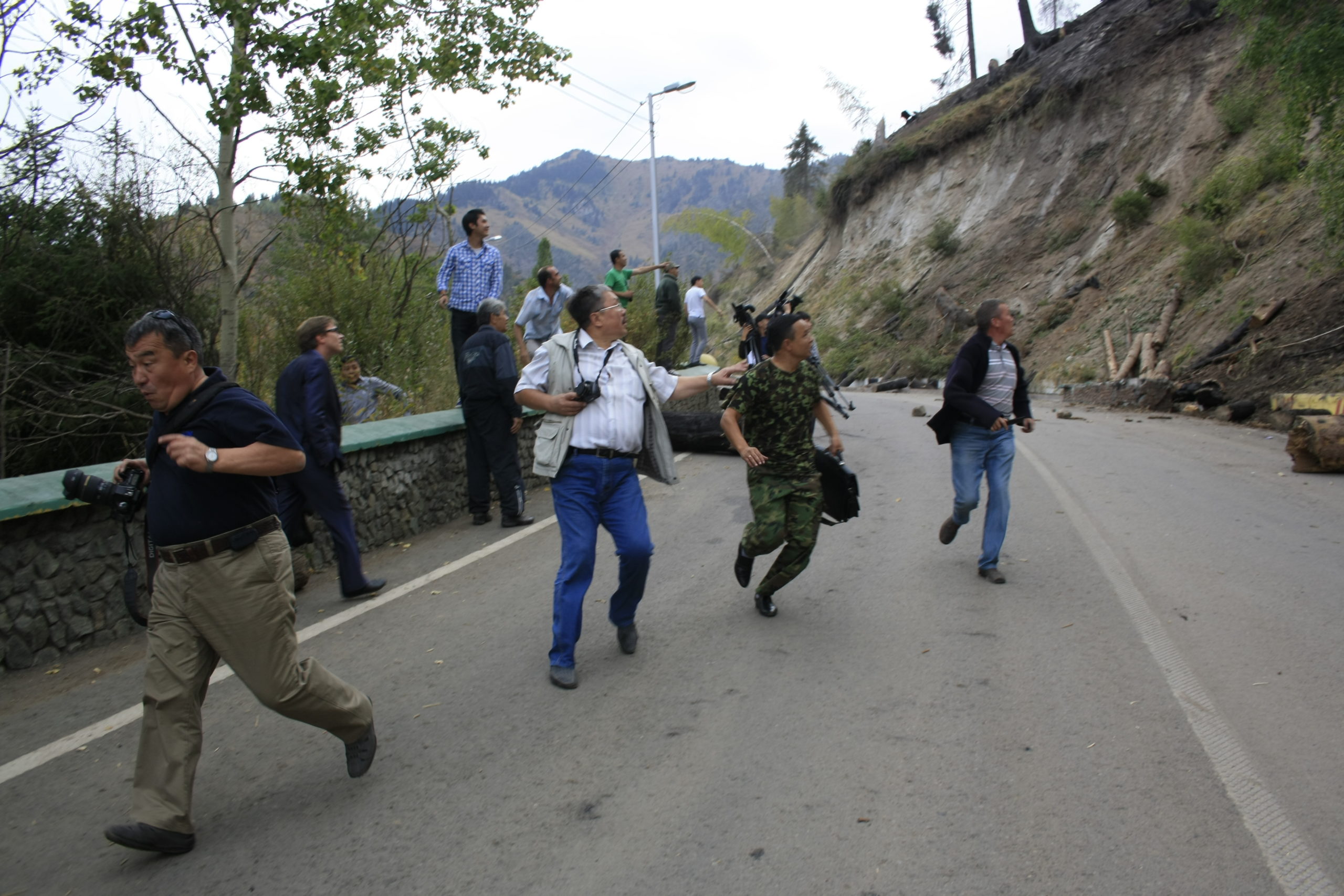
KAZAKHSTAN
An independent expert opinion about Attacks on media workers in Kazakhstan report
Despite Kazakhstan’s regular efforts to demonstrate democratic changes, the situation with journalistic freedoms remains dismal. Cosmetic amendments to legislation unfortunately do little to promote real reforms, while media workers find themselves under a constant onslaught of pressing.
The period from 2017 through the year 2020 was intense and dramatic for Kazakhstani journalists: a several-times “patched up” law on the mass information media, changes to normative legal acts regulating the activity of the press, claims for huge sums made in cases of defamation, and the old tried and true methods of influencing the press – threats and intimidation.
Although 90% of the media in Kazakhstan take positions in support of the ruling power and are dependent on state bodies, the old-fashioned, weak, and inefficient government continues to fear the utterance of free thoughts. It is precisely for this reason that government officials remain the main threat to the media – the number of assaults and attacks on journalists is not falling, but rising.
As has been rightly noted in the report, the methods of attacks in recent years have changed. Today the bodies of state prefer to “avoid needless bloodshed”, using judicial and economic means in relation to the media. With the development of the internet and the migration of part of the audience there, blocking of websites has begun to be applied more frequently, which represents not only a restriction of citizens’ right to access to information, but also an attack on free expression of opinion. Blocking “for no reason”, when not a single state agency takes responsibility for having restricted access to a website, has acquired particular popularity in Kazakhstan. All the while there are no official violations and charges, and yet the website remains blocked. In the opinion of human rights advocates, the motives for such blocking are political.
The pandemic of 2020 exacerbated practically all of the problems in the mediasphere. The situation with access to information deteriorated significantly; as before, many court cases are connected with publications on the internet. Online briefings and press conferences afford the opportunity for state agencies to duck questions, interrupt journalists, and limit their participation. The same thing concerns court trials as well. Such incidents represent a real threat for journalists inasmuch as they impede their professional activity.
The adoption of a law on peaceful rallies has transformed the Kazakhstani practice of control over the mass media somewhat. In 2020 state bodies changed the tactic of detention: now journalists and activists are simply rounded up in a circle and held there for hours – a practice that has received the name “kettling”. As a result, representatives of the media are not subjected to physical beatings, but are deprived of the opportunity to carry out their professional duty.
Nor can we fail to mention self-censorship as well. The articles of the Criminal Code on inciting hate and disseminating knowingly false information are rarely applied in relation to journalists, but they do serve as a deterrent factor during the publication of investigations and hard-hitting materials.
In recent years citizen journalists and bloggers have started getting subjected to threats more frequently – to cyber-threats as a rule. That being said, the registered media also continue to experience difficulties connected with repressive legislation, dependence on state agencies, and political pressure.
A series of NGOs are working in Kazakhstan, rendering legal aid to journalists and bloggers, consulting, teaching, and lobbying the government on the urgent questions facing the media community. It ought to be noted that their activity has been quite effective in some spheres. Thus, with the active participation of NGOs, amendments were adopted to the law on the mass information media concerning protection of the rights of children, libel has been decriminalised, and appropriate language has been used in the law on peaceful rallies concerning the participation of journalists.
Diana Okremova,
Director, OF Legal Media Centre (Astana)
Author of the Report – International Foundation for Protection of Freedom of Speech
1/ KEY FINDINGS
342 instances of attacks/threats in relation to professional media workers and citizen journalists, and editorial offices of traditional and online publications, as well as online activists in Kazakhstan in 2020 were identified and analysed in the course of the research. The data for the research were obtained from open sources in the Russian, Kazakh, and English languages using the method of content analysis. A list of the main sources is presented in the Annex 7.
- The main type of attacks in relation to media workers, as well as bloggers and online activists, is attacks via judicial and/or economic means.
- The main source of threats for media workers, bloggers, and online activists in Kazakhstan are representatives of the authorities, while the most widespread methods of attacks on media workers and civilian journalists in this category are court trials, charges in administrative offence cases, summonses for interrogations, and short-term detentions.
- Mass short-term detentions are directly connected with the growth in protest sentiments in society. Short-term detentions of journalists take place in the course of their coverage of mass protests in the large cities of Kazakhstan.
- The second most popular type of attacks in relation to traditional media journalists and civilian journalists (according to openly available statistics) are non-physical and/or cyber-attacks and threats, especially illegal impediments to journalistic activity and denial of access to information. The main source of threats in this category are likewise representatives of the authorities.
- 24 instances of physical attacks and threats to the life, liberty, and health of media workers were recorded in 2020 (for comparison: there were 19 such attacks in 2019).
2/ THE POLITICAL SITUATION AND THE MEDIA IN KAZAKHSTAN
Kazakhstan has improved its position in the Reporters Without Borders 2020 World Press Freedom Index, having taken 157th place out of 180 (the country held 158th place in the rating for 2019). In the Freedom House human rights organisation’s annual Freedom in the World 2020 report about the situation with civil and political rights, Kazakhstan, with a score of 23 points out of 100, remains in the category of “unfree countries”, as it had been in the previous year (22 points out of 100).
It is possible that some improvement in the country’s position in the ratings is associated with the long-awaited decriminalisation of libel. In December 2019, the president made an announcement about a decision to remove libel from the ranks of criminal offences. On 10 July 2020, a law entered into force whereby libel was moved from the Criminal Code to the Administrative Code.
According to the data of the Ministry of Information and Social Development, as of 19 October 2020 there were 4597 media outlets registered in Kazakhstan, of which 3432 comprise periodical publications, 175 are television channels, 74 are radio, and 660 are news agencies and online publications. There are 256 foreign television channels registered on the list of media outlets.
THE COVID-19 PANDEMIC AND THE STATUS OF THE MEDIA
A state of emergency was introduced in Kazakhstan as of 16 March 2020 in connection with the pandemic. It was extended several times and ended on 11 May. However, quarantine restrictions of various degrees of severity continue to this day.
As of 16 March, the head state sanitary doctor [chief public health officer ‒Trans.] introduced a prohibition on audio, photo, and video shoots in health care organisations, ambulances, in quarantined premises, and during the rendering of in-home medical assistance by medical workers and the conducting of epidemiological research in a focus of infection. Both interview and questionnaire surveys of patients and of “contacts” were prohibited. The prohibition became the reason for the detaining of KTK television channel journalists in Atyrau Region on 11 April.
In the conditions of the state of emergency and quarantine, all sessions of state bodies are being conducted remotely via online means. Online transmissions of sessions take place with disruptions. In response to journalists’ complaints with respect to the bad quality and disruptions of the online transmissions, the officials responsible for ensuring access to information cite technical problems.
At briefings and press conferences, the majority of which take place online, journalists, who are obliged to send in their questions in advance, encounter a situation where the moderators pose only the “convenient” questions to the spokespersons.
In the period that the state of emergency and quarantine regime has been in effect, the most defenceless category of journalists have become bloggers, whose status is not defined in any way in Kazakhstan’s legislation. It is specifically bloggers and online activists who are most frequently charged with libel and with violating the state of emergency regime.
Kazakhstan’s mass media outlets have encountered economic hardships as a result of the pandemic. This especially concerns the print media, which has been deprived of the opportunity not only to distribute print runs among subscribers, but also to sell them in retail outlets and specialised kiosks. According to the official data, the forecast loss of advertising incomes in 2020 sits between 30% and 60%.
ELECTIONS TO THE LOWER CHAMBER OF PARLIAMENT AND LOCAL EXECUTIVE BODIES: LEGAL AND NORMATIVE ACTS AND THE STATUS OF THE MEDIA
On 21 October, the president of Kazakhstan made an announcement about upcoming regular elections to parliament and local executive bodies. The elections were scheduled for 10 January 2021.
On 4 December, the Central Electoral Commission published a decree defining the rights and duties of candidates’ agents, observers, and representatives of the media. Representatives of NGOs, civic activists, and journalists declared that this document seriously restricts the opportunity to independently observe the elections. In particular, the items about the prohibition on video transmission from polling stations, about the need to get citizens’ approval to use their images, and about how only those legal entities that have this activity explicitly included in the organisation’s charter can send observers to the elections were subjected to criticism.
In addition to this, mass media outlets were prohibited from conducting pre-election surveys without fulfilling a series of conditions: they must notify the Central Electoral Commission in advance, confirm that they have five years of experience conducting surveys, and have employees with a sociological education and employment history on staff.
A “Checklist for mass information media and journalists in the period of elections in the Republic of Kazakhstan” issued by the relevant ministry prescribes “refraining from the publication of agitational materials and other information knowingly tarnishing the honour, dignity, and business reputation of a candidate or political party” and reminds about civil and criminal liability.
With the start of the pre-election campaign, bloggers and online activists began to be called to the prosecutor’s office in connection with surveys on the topic of the elections; they were warned about administrative liability for violating electoral legislation. Thus, in December the blogger Kairat Abdrakhman [“Qairat Äbdırahman” in Kazakh] (Almaty Region) was fined by a court for a survey published on social media on 9 November. The blogger had expressed interest about whether or not his subscribers trusted the elections and what they thought about the deputies to the city mäslihat [members of the city council ‒ Trans.].
A requirement that agents, observers, and representatives of the media present at polling stations strictly comply with safety measures and maintain social distancing of no less than one and a half to two metres was introduced on 29 December by decree of the head state sanitary doctor.
LEGISLATIVE REGULATION OF THE ACTIVITY OF MEDIA OUTLETS AND JOURNALISTS
Laws significant to society, in particular about rallies and about the decriminalisation of libel, were discussed and adopted in Kazakhstan in 2020 without the participation of the public.
A law “On the introduction of changes and additions to some legislative acts of the RK with respect to questions of enforcement proceedings and criminal legislation”, removing the “Libel” article from the Criminal Code, entered into force on 10 July. Libel is being moved to the Code of the RK “On administrative offences” and prescribes a fine or administrative arrest with a maximum term of up to 30 days. With the decriminalisation of libel, the quantity of criminal cases in relation to journalists declined insignificantly. Human rights advocates continue to insist on moving libel into the sphere of civil law: administrative proceedings infer the participation of the state and the police.
On 25 May, the president of the RK signed a law “On the order for organising and conducting peaceful gatherings in the Republic of Kazakhstan”. A norm about the duty of a journalist or an organiser and a participant in a peaceful gathering to turn over a photo shoot or video recording of peaceful gatherings at the demand of state bodies and/or official persons thereof did not make it into the final version. Likewise removed were norms about the rights and duties of a journalist that replicate the law on the mass information media. The law entered into force on 6 June 2020.
On 30 December, the president of Kazakhstan signed a law “On the introduction of changes and additions to some legislative acts of the Republic of Kazakhstan on questions of information”. These changes are aimed at resolving two main tasks – strengthening control and responsibility and expanding the sphere of application of the law. In the opinion of journalists, the law does not expand access to information for media employees, citizens, and non-governmental organisations. According to this new law, a journalist may be stripped of accreditation for violating the rules of accreditation: i.e. furnishing an incomplete package of documents, incorrectly filling out an application, a court decision on suspending/terminating the activity of a media outlet, and for spreading information that does not correspond to reality and tarnishes the business reputation of the state bodies that had accredited it and civic associations and organisations, as well as upon application by an owner of a media outlet or an editorial office. It is not indicated in the law who is going to determine that that or the other information does not correspond to reality and is tarnishing the business reputation of state bodies.
3/ GENERAL ANALYSIS OF ATTACKS
Graph below represents a quantitative analysis of the three main types of attacks in relation to journalists on the territory of Kazakhstan in the period from January 2017 through December 2020.
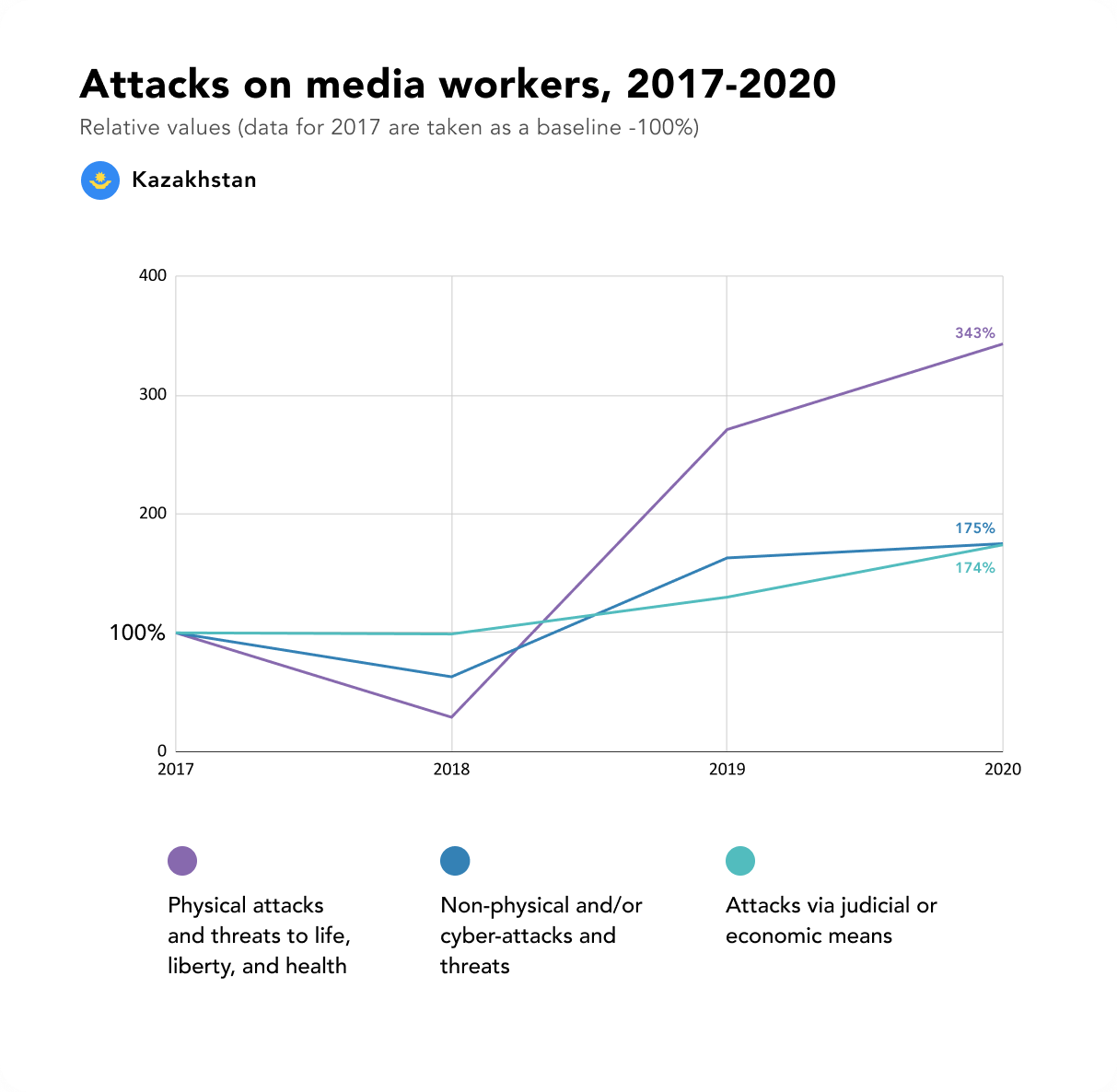
The number of attacks in all three categories rose from 2017 through 2020. In comparison with 2017, in 2020 the quantity of attacks via judicial and/or economic means increased by 34%; there were 6% more non-physical and/or cyber-attacks and threats, and 26% more physical attacks and/or threats to life, liberty, and health.
The main objective of the threats is to impede the publication of materials and to suppress civic activism. Threats of physical violence remained unpunished in practice: cases with respect to the not large number of claims lodged by representatives of the media were either quietly dropped or closed “due to the absence of the event of a crime” in nearly one hundred percent of the cases.
For the purposes of more precisely reflecting combination assaults on media workers in 2020 we are introducing a new category of attacks – hybrid.
We are calling systematic persecution of some publication or media worker with the use of tools from two or more categories of assaults – physical, non-physical, and judicial/economic – “hybrid”. Such a combination of means involving and not involving force with judicial means of pressure on undesirable journalists is carried out with a view to demoralising them or getting them to self-censor or to give up the profession or even life itself.
In 2020, 86 hybrid attacks were recorded, of which 63 attacks committed against 7 journalists. Presented below is the list of the journalists and bloggers who were being subjected to the most intensive hybrid attacks in 2020.
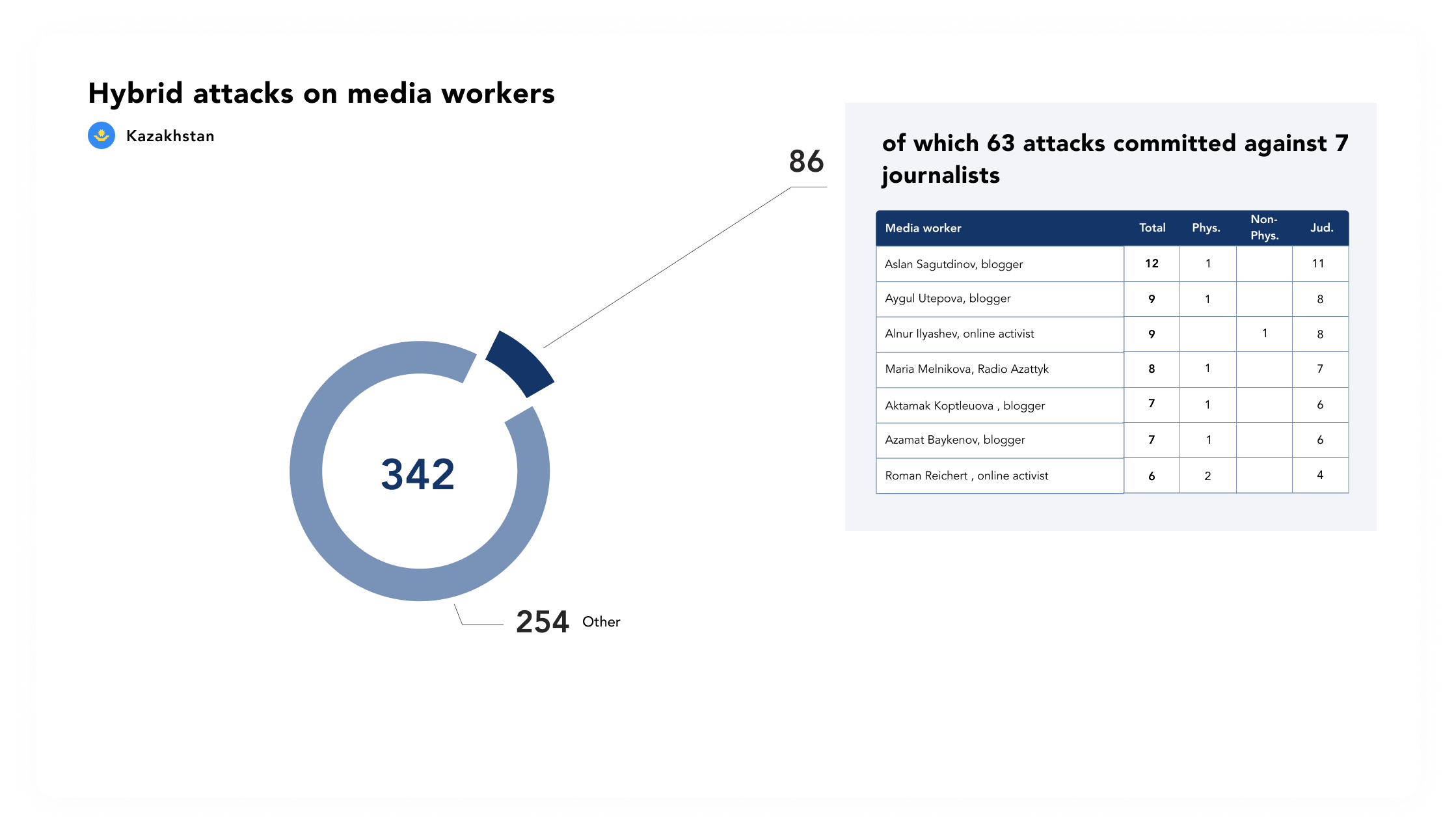
4/ PRESSURE ON JOURNALISTS UNDER THE PRETEXT OF RESTRICTIONS CONNECTED WITH THE COVID-19 PANDEMIC
A state of emergency was introduced in Kazakhstan in connection with the spread of COVID-19, and quarantine restrictions remained in effect after it had been lifted. In this context, attacks were undertaken in relation to journalists, bloggers, and online activists via judicial and/or economic means (37 instances), as well as non-physical attacks and threats (10 instances). The main source of the threats (43 instances) are representatives of the authorities.
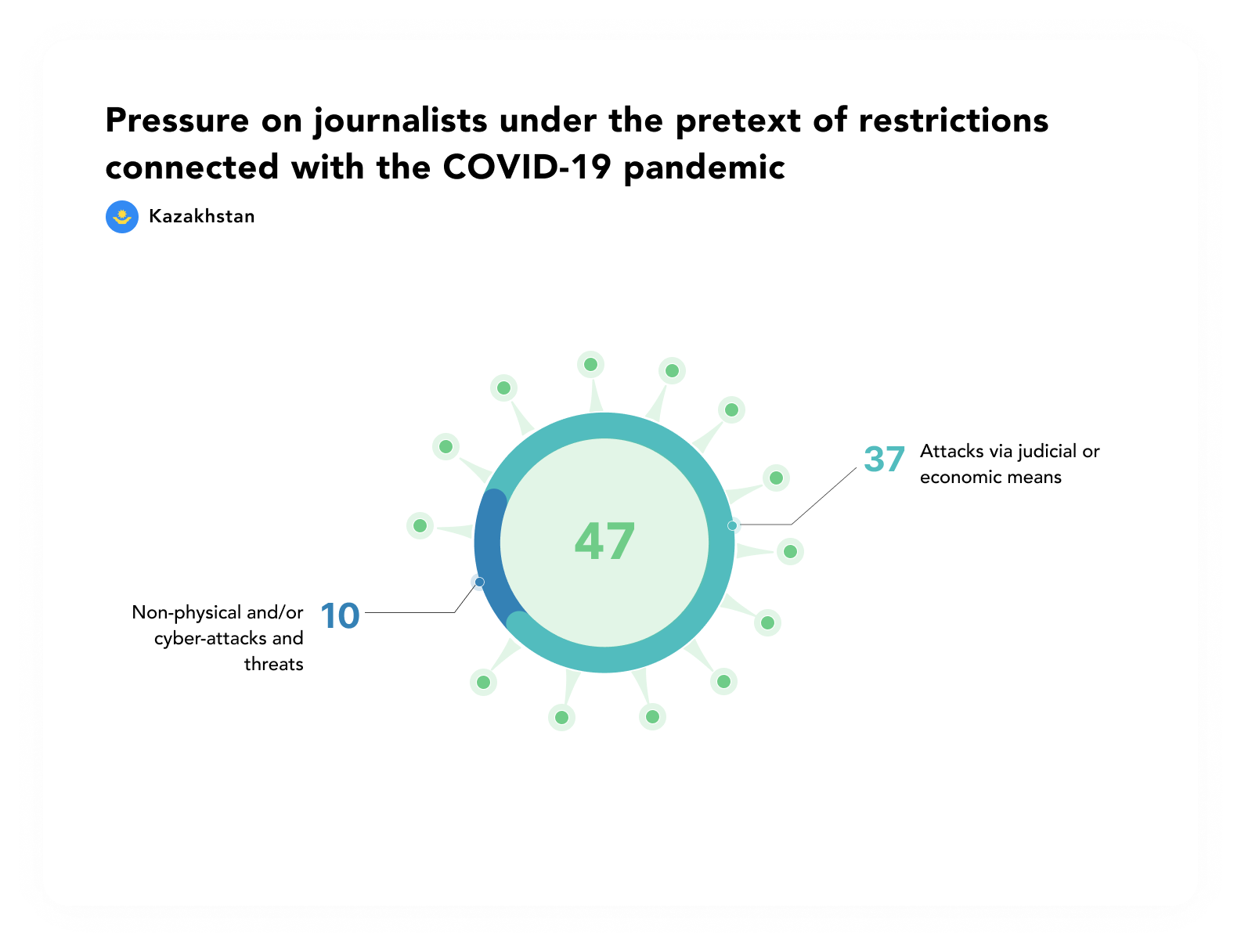
The graph represents the sub-categories of attacks/restrictions within the framework of the quarantine measures. Remaining in the top three methods of pressure on media workers, bloggers, and online activists are court trials (12) on charges of dissemination of knowingly false information in the period of a state of emergency and violation of the state of emergency regime, illegal impediments to journalistic activity (9), and administrative arrests and remand (7).
- On 28 March, blogger and civic activist Dias Moldalimov [Moldaälımov] was detained and delivered to the Almaty Police Department in connection with a pre-trial investigation into dissemination of knowingly false information in the conditions of a state of emergency (article 274 of the Criminal Code of the RK). The investigator proposed that Moldalimov give confessionary testimony; Moldalimov, however, exercised his constitutional right and refused. The reason for the prosecution became a video address on a YouTube channel from 27 March, in which Moldalimov had severely criticised the actions of the authorities during the time of the quarantine.
- On 18 April, civic activist Alnur [Älnūr] Ilyashev was arrested for two months on suspicion of “dissemination of knowingly false information during the time of a state of emergency”. On 22 June, the online activist was sentenced to three years of restriction of liberty, 100 hours of community service, and a five-year prohibition on public activity. His posts on Facebook criticising the ruling party, Nur Otan, formed the basis of the charges. Ilyashev declared that the verdict was a way of silencing him.
- On 18 April, a well-known public figure, former head of the KTK television channel Arman Shurayev [Şoraev], was detained in Karaganda [Qarağandı] on suspicion of dissemination of knowingly false information in the conditions of a state of emergency. Shurayev was placed in a temporary holding pre-trial detention facility. On 20 April, with the sanction of the court, he was released against a signed pledge not to leave the city.
- On 24 April, a production team from the KTK television channel – correspondent Beken Alirakhimov [Älirahymov] and television camera operator Manas Sharipov [Şärıpov] – was detained on the territory of the regional hospital in Atyrau at the time of shooting a story about the transfer of 257 medical personnel who had been in contact with infected people to a specialised early treatment tuberculosis clinic in Mahambet District. The journalists were charged with violation of the state of emergency regime. An administrative court issued them a penalty in the form of a warning.
5/ PHYSICAL ATTACKS AND THREATS TO LIFE, LIBERTY, AND HEALTH
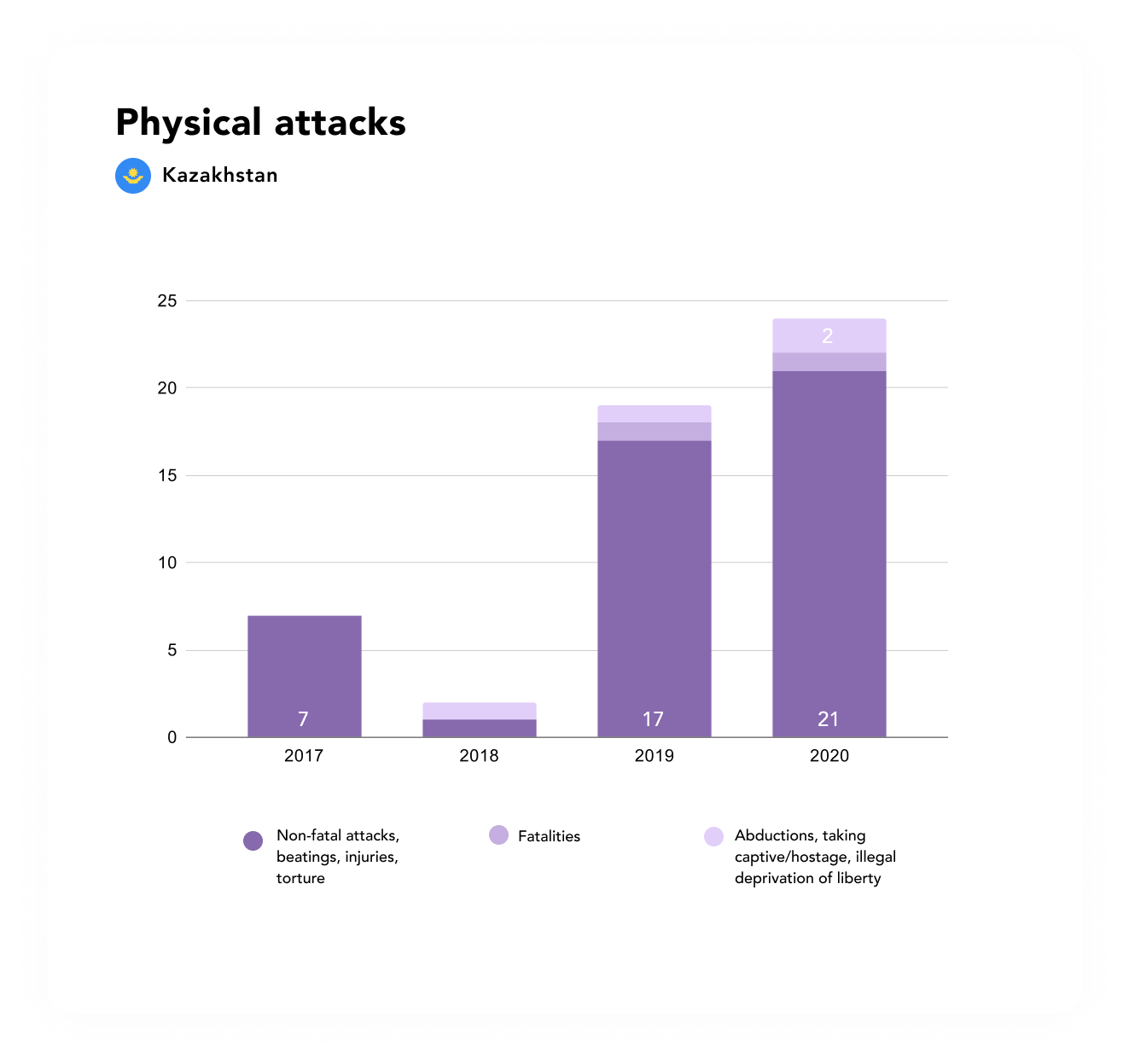
24 physical attacks and threats to the life, liberty, and health of media workers were recorded in 2020. Of these, 20 were non-fatal attacks, beatings, and injuries, in 13 of which the journalists suffered as the result of the actions of police and security service employees.
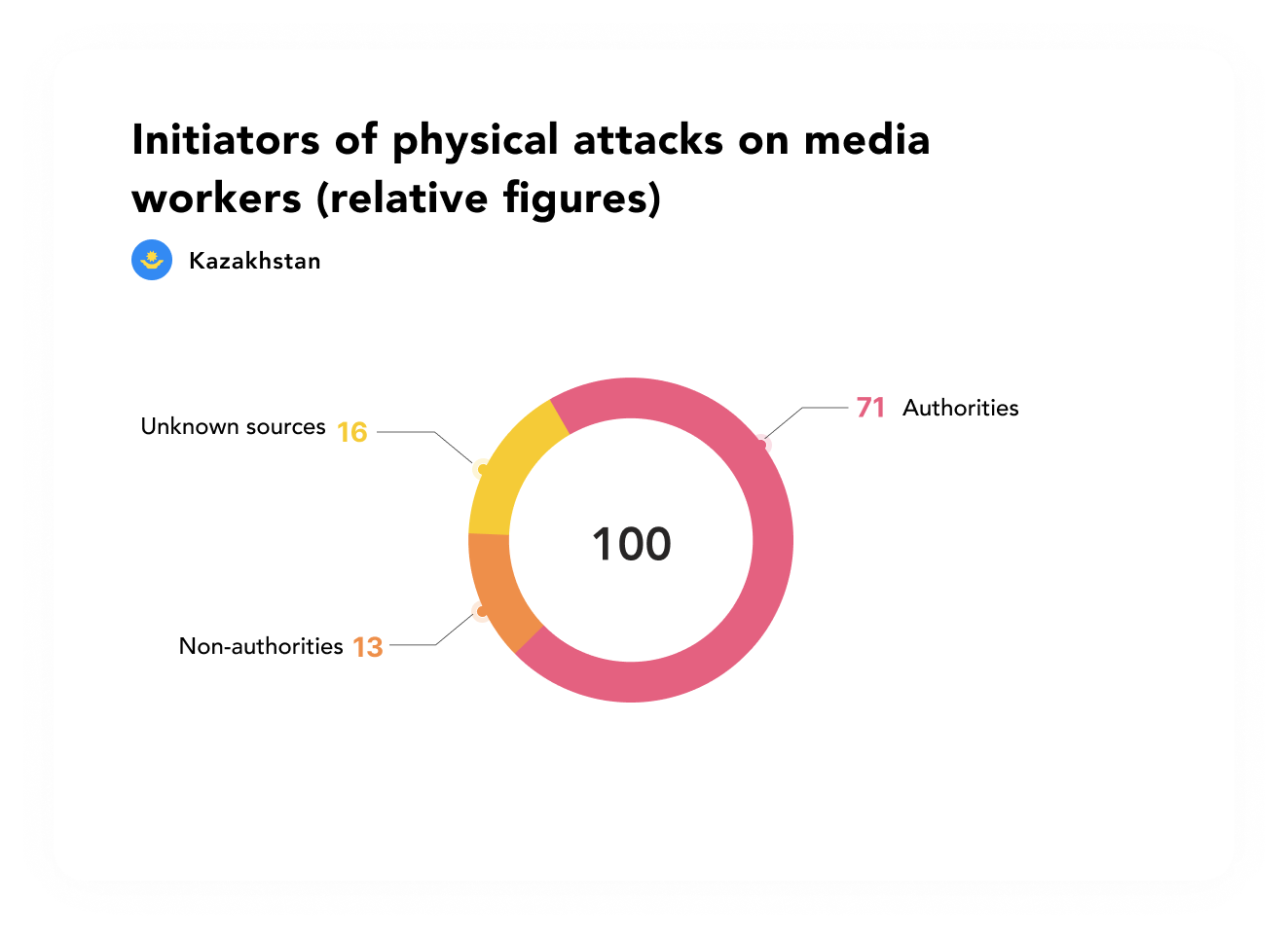
- On 10 January, security at the KazMedia Ortalygy [Ortalığı] television centre grabbed Vlast.kz journalist Tamara Vaal and began twisting her arms as she was trying to record Kazakhstan vice-premier Roman Sklyar’s commentary after a briefing.
- On 22 February, civic activist and blogger Aslan Sagutdinov was detained next to the place of an alleged unsanctioned rally in Uralsk. During the arrest,they tore his jacket; one of the policemen split his lip with a blow to the head. After Sagutdinov started feeling unwell in the police station (as the result of the ensuing aneurysm), they drove him in an ambulance to a hospital.
- On 17 March, head of the 101tv.kz public internet television Botagoz [Botaköz] Omarova was beaten,by a security employee working for a construction company, to which she had come with an editorial query.
- On 25 September, Radio Azattyq journalist Khadisha Akayeva [Aqayeva], covering detentions in Semey, reported that she had been subjected to a brutish detaining by police. “When they were dragging me into the police van, they injured my finger, broke my nails, and tore out some of my hair”, recounted Akayeva.
- On 24 October, Radio Azattyq reporter Sаniya Toyken was subjected to an assault by a policeman while covering an event in support of political prisoners.
The only fatal incident took place on 24 February 2020: the online activist Dulat Agadil [Ağadıl] died in a pre-trial detention facility in Nur-Sultan several hours after being taken into custody. According to the official story, death came due to acute cardiac insufficiency. Many activists and human rights advocates do not believe this story. They consider that the civic activist had been subjected to torture in the pre-trial detention facility, after which he passed away.
Two instances of the use of punitive medicine are known about:
- On 12 November, a court decreed to place blogger and journalist Aygul Utepova [Aigül Ötepova] in a specialised early treatment psychiatric clinic for involuntary observation. The author of critical posts had been detained on suspicion of participation in the banned DCK movement and placed under house arrest on 17 September 2020.
- On 16 April, online activist Asanali Suyunbayev [Asanälı Süieubaev] was detained, and after that placed in a psychiatric hospital. The hospitalisation was implemented with the participation of the police officers who had stopped Suyunbayev on the street.
One instance of pressure on a media worker by means of physical pressure on relatives and loved ones was recorded:
- On 31 March, a criminal case of “organisation and participation in the activity of a civic or religious association or other organisation after a decision of a court on the banning of their activity or liquidation in connection with the implementation by them of extremism or terrorism” (article 405 of the Criminal Code of the RK) was initiated in relation to civic activist Roman Reichert. On 31 March, policemen conducted a search in his house. They used violent force on Reichert and his wife when the activist tried to get dressed. His wife Regina Belalova tried to film what was happening, but they snatched the smartphone from her.
6/ NON-PHYSICAL AND/OR CYBER-ATTACKS AND THREATS
The most popular methods of pressure on media workers, bloggers, and online activists are: illegal impediments to journalistic activity, denial of access to information (25); bullying, intimidation, pressure, threats of violence and death, including cyber- (11); and damage to/seizure of property, vehicles, equipment, documents, journalistic materials, print run (5).
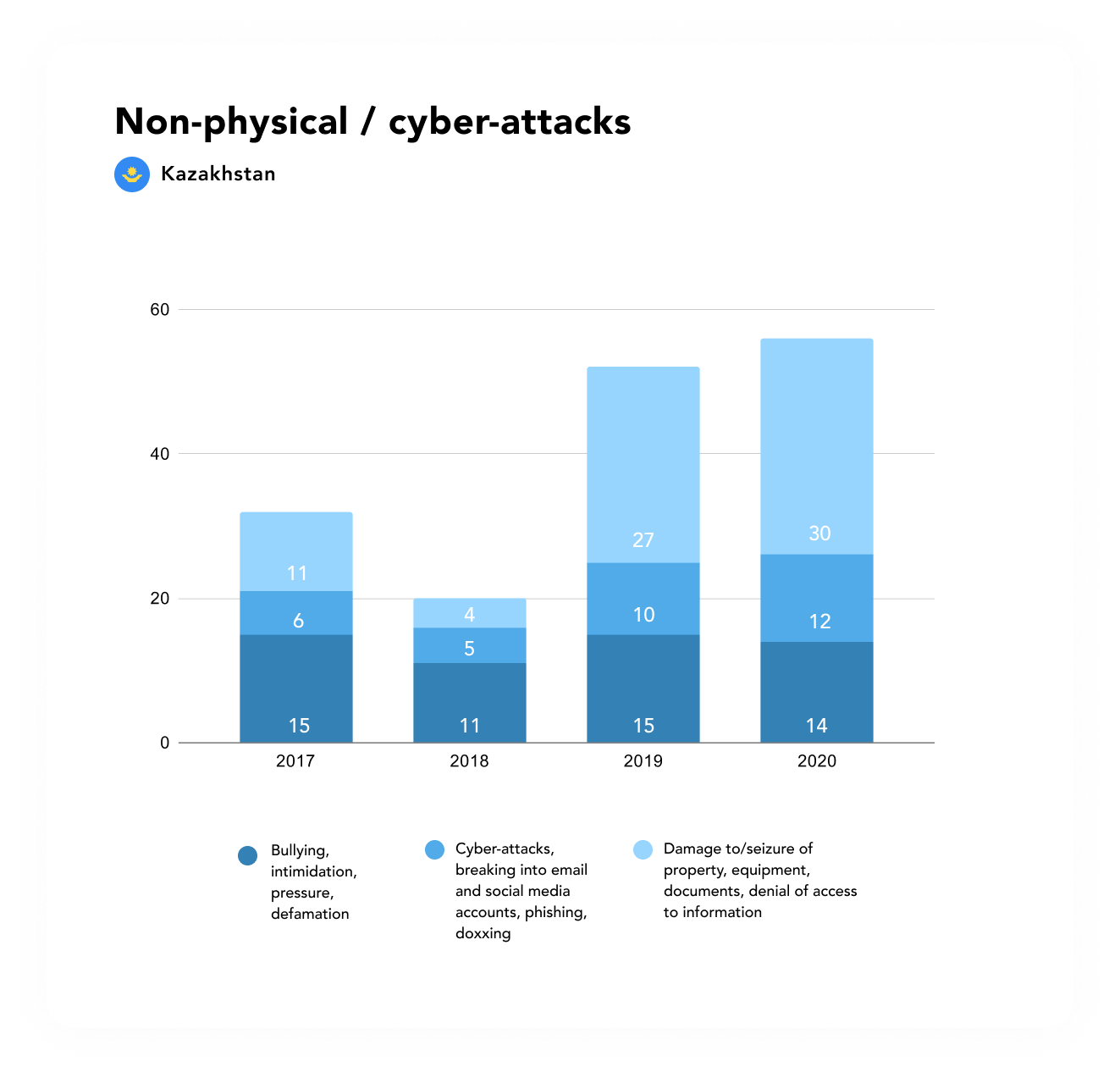
It ought to be noted that in 19 of the 25 instances, representatives of the media encountered impediments to journalistic activity on the part of representatives of the authorities. The impediments were expressed in refusing admittance or denying an online connection for media representatives to sessions of state bodies and courts, creation of obstacles to coverage of various events, and prohibitions on commenting on high-profile court trials.
- On 6 June, when Radio Azattyq reporter Dilara Isa was conducting a video shoot of rally participants being detained in Shymkent [Şymkent], two unknown persons tried to prevent the detainings from getting into the shot by blocking the camera with umbrellas. One of them introduced himself as an employee of the internal policy administration of the Shymkent akimat. Besides that, a man working in the press service of the city police department was continuously shooting video of the reporter as she was working.
- On 3 August, news resource iagorod.kz journalist Irina Starikova was not allowed into a meeting between entrepreneurs and the deputy akim [mayor] of the city of Rudny. “An employee of the Rudny akimat‘s internal policy section reported that the upcoming meeting was ‘closed’ and admission is not allowed,” writes Starikova. After that an employee of the security service tried to prohibit the journalist from shooting video and photos on a smartphone camera.
The second widespread method of attacks on journalists was bullying, intimidation, pressure, threats of violence and death, including cyber- (11 instances):
- On 2 March, MIA «KazTAG» correspondent Mahambet Abzhan [Äbjan], who had earlier been released early on parole, received a notification on WhatsApp from the precinct police inspector. The policeman reported that the journalist must come to division No. 28 of Saryarka District of Nur-Sultan and stay in a temporary holding cell until morning, because a session related to his case was scheduled to take place in the administrative court in the morning. As the precinct inspector said, “now there is such a way of doing things, that everybody’s trial goes like this”. After Abzhan wrote about this on Facebook, the question of spending the night in the police division was taken off the table.
- On 17 June, it became known that pressure is being exerted on civic activist Alnur [Älnūr] Ilyashev in a pre-trial detention facility. “They’re planting provocateurs and people who threaten me in the cell! It has likewise become known to us that Alnur’s state of health has deteriorated sharply and they’re not providing him with the proper medical care! His chronic illness, asthma, has become acute! The system is trying to break him or physically destroy him!”, reports the prisoner’s close associate Marat Tūrymbetov.
- On 12 September, journalist Tauirbek Bozekenov [Täuırbek Bözekenov] declared that he was being threatened with judicial prosecutions because of publications on Facebook. The journalist writes about the environmental situation in the region of Atyrau. The threats came after Bozekenov’s refusal to remove the publications.
- On 2 December, a well-known blogger from Shymkent, Kirill Pavlov, reported about a threat of reprisal and the police’s refusal to take his statement reporting the crime: “There is a threat to my life. A person who had previously openly expressed dislike for my ethnicity writes that he will come to Shymkent, deal with me, cut me, stab me. I had to go to the police, but the report of the crime was not accepted, they asked me to wait for someone. Just in case, I will post this video so that you know that if something happens to my family or me, blame Shyngys Sadenov [Şyŋğys Sädenov] for it”, said Pavlov in a video on Facebook.
7/ ATTACKS VIA JUDICIAL AND/OR ECONOMIC MEANS
In 2020, the top five main methods of pressure on media workers included: court trials (59), charges of libel and reputational damage (53), summonses for interrogation and questioning (28), short-term detention (22), and administrative arrests, remand, and pre-trial detention (16). The majority of short-term detentions of journalists took place during coverage of protests.
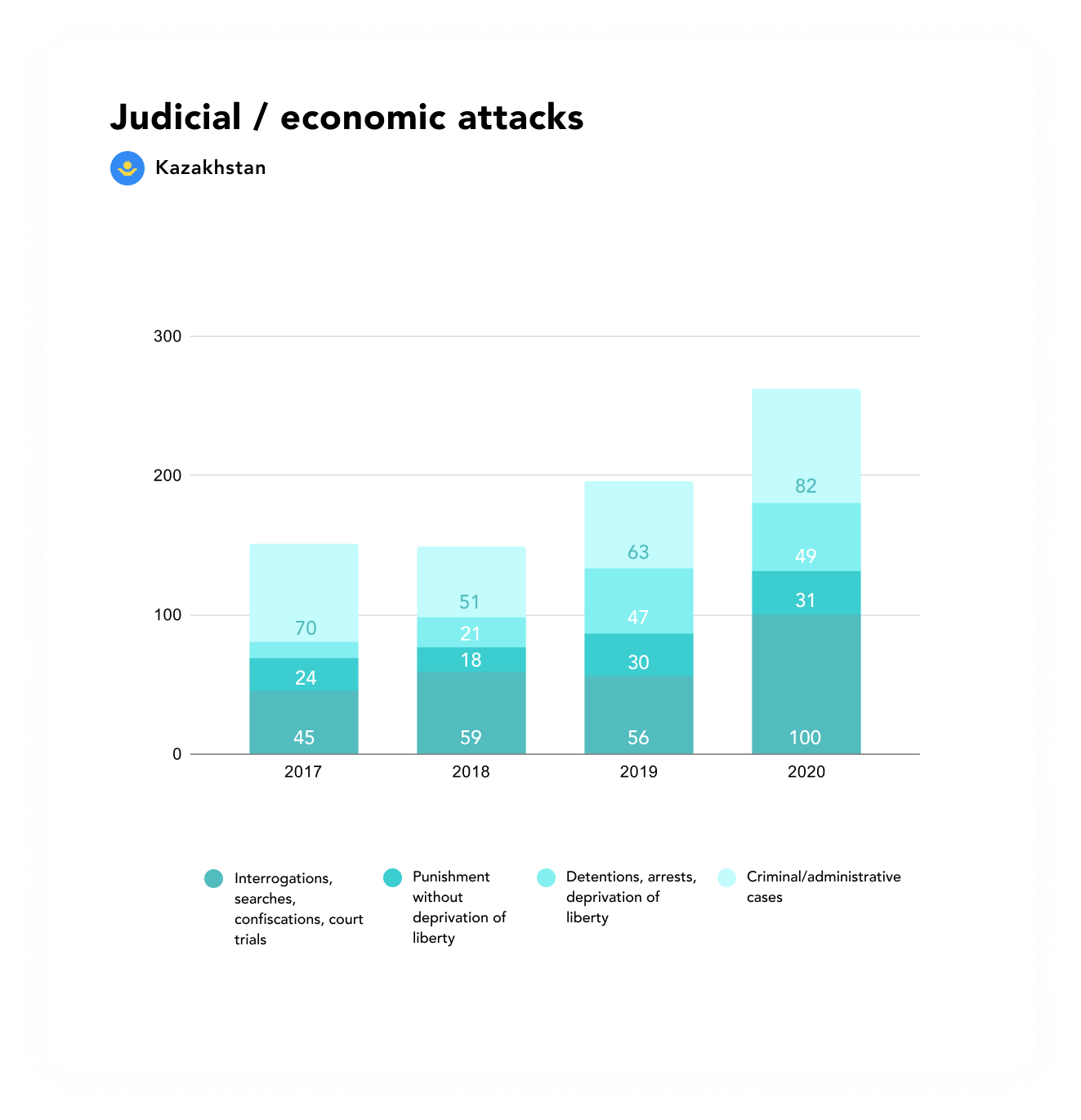
Court trials are the most widespread method of pressure on journalists, bloggers, and online activists in Kazakhstan. In the majority of situations, criminal cases on charges of dissemination of false information, inciting hate, and participation in the activity of an extremist organisation, as well as administrative cases for violating the state of emergency regime, end with guilty verdicts. Short-term detentions and arrests precede the charges in such cases.
- On 16 May, the Petropavlovsk city court sentenced blogger Azamat Baykenov to one year of restriction of liberty, suspended, on a charge of “participation in the activity of a banned organisation”. Besides that, the court obligated Baykenov to pay 10 monthly calculation indices (around 27 thousand tenge, or on the order of 65 dollars) into the Victims’ Compensation Fund. The blogger was prohibited from using social media over for three years. Baykenov denies the charges.
- On 20 September, blogger and journalist Aygul Utepova [Aigül Ötepova] was placed under house arrest in connection with the investigation of a criminal case of participation in the activity of a banned organisation. Utepova was prohibited from leaving her place of residence except to visit medical institutions “based on the state of her health and the health of close relatives”. On 12 November, the court sanctioned Utepova’s hospitalisation in a specialised early treatment psychoneurological clinic “for the conducting of a psychological-medical expert evaluation”. The journalist’s lawyer and relatives appraise the court’s decree as an attempt to isolate the author of critical posts. On 23 November, the police took Utepova from her home to the clinic, where she remained until 11 December. Doctors concluded that she is perfectly healthy.
- On 20 November, the court of Turkestan Region sentenced online activist Murat Baidauletov [Mūrat Baidäuletov] to one year of restriction of liberty for “participation in the activity of a banned organisation”. The activist was likewise assigned four hours of compulsory work per day until the moment he finds a permanent job. As the judge declared, Baidauletov had made a live broadcast on Facebook in which he had spoken out in support of the programmes of the Democratic Choice of Kazakhstan and Koshe [Köşe] partiyasy movements, which were banned by a Kazakhstani court.
In 40 out of 53 instances, the accusations of journalists with libel, insult, and reputational damage came from non-representatives of the authorities.
- On 2 March, the Sino-Kazakh oil production company «SP «Kazgermunai» turned to the Bostandyq District Court of Almaty with a claim for the protection of business reputation against the owner of the Caravan.kzmedia resource – the Kazakhstan Today agency and the correspondent Adil Urmanov.
- On 18 May, a court ruled in favour of businessman Malik Yesenbayev’s claim against the editorial office of the newspaper Vremya and the journalist Mikhail Kozakov. The editorial office has to publish a retraction of the controversial information presented in the article “Porochnye svyazi” [“Nefarious Ties”], remove this material from the newspaper’s website time.kz, and pay out 80 thousand tenge (around $200) to the plaintiff as compensation for pain and suffering.
- On 28 May, a statement of claim for the protection of honour, dignity, and business reputation was received by the Pavlodar City Court from the entrepreneur Georg Speiser [Shpeyzer]. The object of the suit became a publication posted on 1 April by Pavlodar journalist Alexander Baranov in his Facebook account. The author of this “April Fool’s joke” fantasy article had warned that all the heroes and events had been made up and that any similarities to actual persons or events were coincidental. However, Speiser discerned the dissemination of unreliable information in the publication. He is demanding retractions and a payout of compensation from the journalist in an amount of 1 million tenge (around $2500) for infliction of pain and suffering.
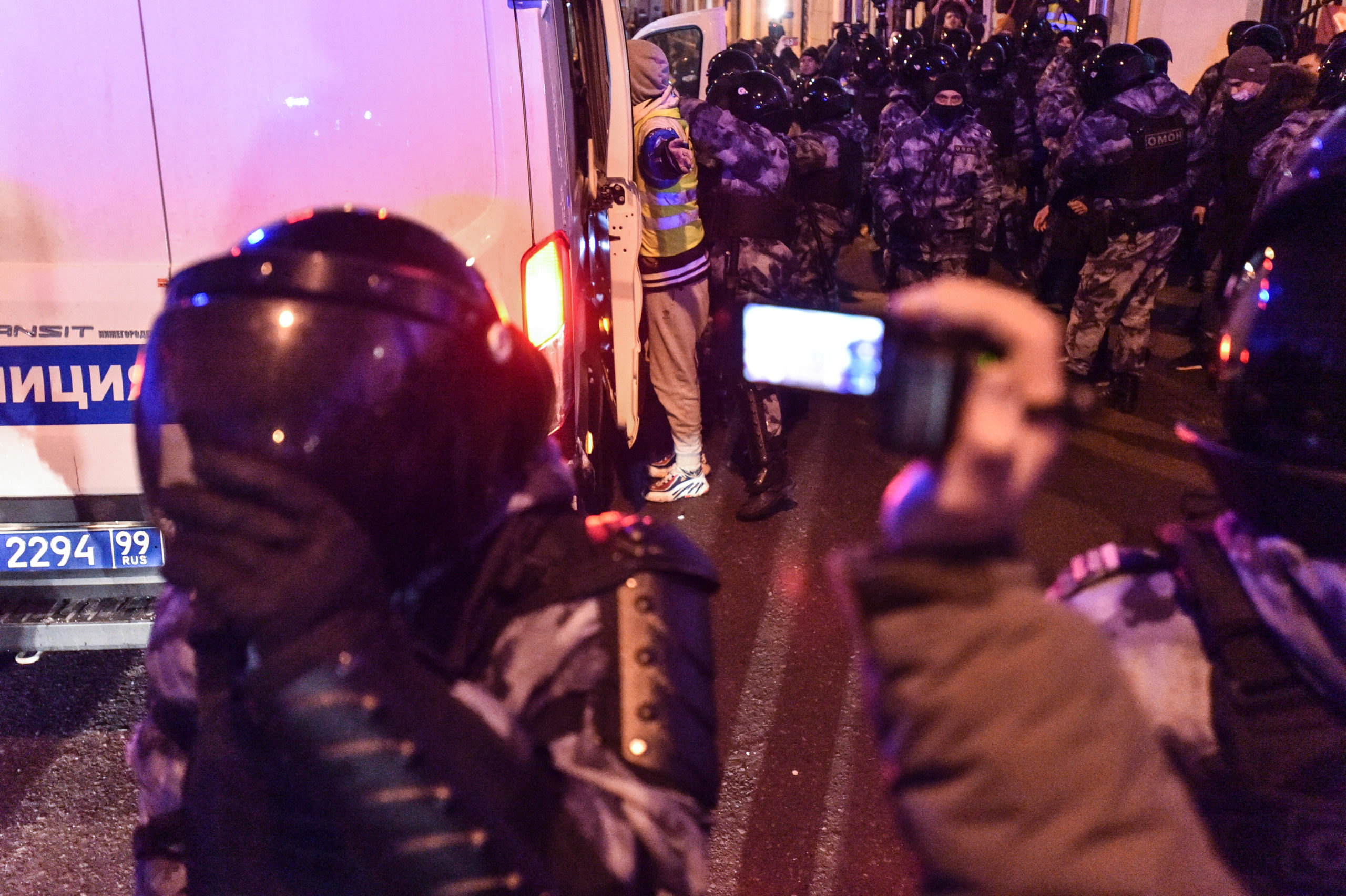
RUSSIA
AN INDEPENDENT EXPERT OPINION ABOUT ATTACKS ON MEDIA WORKERS IN RUSSIA REPORT
Described in detail in the Justice for Journalists Foundation’s report is the “legal framework” of repressions in relation to journalists and violations of freedom of speech and freedom of the media. New laws on “foreign agent” media outlets and on the rules for coverage of mass public assemblies, as well as excessive restrictive measures in connection with the COVID-19 pandemic, are making the work of professional and citizen journalists and the ability to help them on the part of human rights organisations even more difficult.
Russian journalists working at protest actions are ever more frequently being held liable under the criminal code article on participation in public events. Short-term detentions of journalists take place despite their carrying editorial assignments and wearing distinguishing markings: yellow “Press” vests and badges on the chest.
More and more often the authorities have begun having grievances against not-large regional (both registered and unregistered) mass information media within the framework of the so-called “Yarova’s law”. Roskomnadzor is demanding that they voluntarily join the register of organisers of disseminators of information. For a not-large regional media outlet or a blog this signifies closure of the publication, because the cost of the hardware required comprises several million roubles.
Among those receiving such demands were Svobodnye novosti (Saratov) and Dovod (Vladimir). The Dovod publication managed to escape inclusion in the register. Likewise, not-large publications are being subjected to pressure — for example the website The Vyshka, which constitutes a student media outlet. Roskomnadzor blocked the website, having accused it of disseminating prohibited content. In many cases Roskomnadzor blocks a publication’s website in its entirety without warning.
Lawsuits on defence of honour, dignity, and business reputation (article 152 of the Civil Code) from companies and persons affiliated with the state have become more frequent as well. Thus, “Putin’s chef” Yevgeny Prigozhin filed a lawsuit against the publications Meduza and Dovod with a demand to delete publications and refute the facts of his criminal past. The Russia Today television channel and Anton Krasovsky filed an analogous lawsuit on defence of honour, dignity, and business reputation against Novaya gazeta and the political columnist Leonid Gozman.
Lawyers with the Human Rights Project by Open Russia are actively working in Moscow and the Russian regions on the cases mentioned and others, helping independent media outlets and media workers lodge complaints about assaults, illegal detentions, and arrests, as well as Roskomnadzor’s demands, and to make their case in Russian courts. Among the people we are defending — journalists with such publications as Ekho Moskvy (Saint Petersburg), Kommersant, Novaya gazeta, Meduza, ZakS.ru, Fontanka, Vazhnye istorii, and others.
Anastasia Burakova
Coordinator, Human Rights Project by Open Russia
Author of the report – Justice for Journalists Foundation
1/ KEY FINDINGS
1284 instances of attacks/threats in relation to professional and citizen media workers and editorial offices of traditional and online publications as well as Russian journalists abroad in 2020 were identified and analysed in the course of the research. The data were obtained from open sources in the Russian and English languages using the method of content analysis. A list of the main sources is presented in the Annex 8.
- The number of attacks against professional and citizen journalists in 2020 was unprecedented for Russia and was more than double the total quantity of attacks over the three previous years.
- 8 Russian journalists perished in this year, including Irina Slavina from Nizhny Novgorod who committed suicide as the result of many years of harassment, opposition Chechen blogger Imran Aliyev who was killed in France, blogger Mamikhan Umarov (“Anzor from Vienna”) killed in an Austrian suburb, and Orenburg journalist Aleksandr Tolmachev who died one month shy of release from a penal colony after a 9-year term.
- The rise in the number of attacks against journalists took place primarily via judicial and economic means. Representatives of the authorities stood behind them in 93% of the cases.
- COVID-19 offered additional pretexts to persecute journalists: 188 attacks were recorded in this category from the end of March through the end of December 2020, including 3 beatings, 47 charges of disseminating unreliable information, and 48 fines and administrative offence reports for violating rules on self-isolation.
- 133 instances were recorded of illegal short-term detentions (for a period of up to 24 hours) and arrests (for a period from 24 hours to 30 days) of media workers at various protest rallies despite their having editorial assignments and press cards.
One can certainly consider the improvement in the system for collecting and updating data on assaults on Russian professional and citizen journalists as a positive phenomenon. Organisations engaged in monitoring attacks on journalists and media workers include: OVD-Info, Roskomsvoboda, Human Rights Project by Open Russia, the Journalists’ and Media Workers’ Union, the Glasnost Defense Foundation, and the international human rights group Agora.
2/ THE POLITICAL SITUATION AND THE MEDIA IN RUSSIA
A high degree of state influence on the media is a distinguishing feature of the media landscape in Russia. Russia holds 149th place out of 180 for the second year in a row in the Reporters Without Borders annual freedom of the press index for 2020, between Honduras and the Democratic Republic of the Congo. Russia has dropped 28 places in the 19 years that have passed since the first rating took place. As Reporters Without Borders note: “As TV channels continue to inundate viewers with propaganda, the climate has become very oppressive for those who question the new patriotic and neo-conservative discourse, or just try to maintain quality journalism”.
According to the Freedom on the Net report for 2020 drawn up by Freedom House, internet freedom is absent in Russia (30 out of 100 points in comparison with 34 points in 2017). By this indicator Russia finds itself in the same group of countries as Belarus, Turkey, Kazakhstan, Uzbekistan, China, Cuba, and Saudi Arabia. Freedom House associates the absence of internet freedom with draft laws, particularly those on the “sovereign internet”, aimed at increasing online censorship.
Freedom House notes that “In spring 2020, the government deployed intrusive surveillance systems, ostensibly to enforce its COVID-19 quarantine regime, and worked to censor or deter the circulation of any content that conflicted with official reports on the pandemic”.
OVERALL QUANTITY OF MEDIA OUTLETS AND AUDIENCE REACH
According to the data of Roskomnadzor [the Federal Service for Supervision of Communications, Information Technology and Mass Media], as of 30 September 2020 the overall quantity of actively functioning registered mass information media outlets comprises 62,876, which is 6.6% less than in the analogous period of 2019. Of these, 40,413 are print media, 21,356 are electronic, and 1107 are news agencies.
The leading TV channels in 2020 remain Russia-1 (average daily audience in Russia’s large cities– 1.3 million people), Channel One (audience– 1 million 128 thousand), and NTV (a million viewers per day). There is not a single channel in the main broadcasting line-up that offers independent, objective information.
The only such channel is Rain, which is accessible on the internet, on devices with the Smart TV function, and on cable television. On 3 February 2014, representatives of Trikolor TV announced that they were terminating cooperation with Rain due to the channel’s editorial policy.
According to Deloitte’s report “Media consumption in Russia 2020”, the number of people reading print media continues to fall, having reached the lowest indicator in the past five years. A mere 38% of respondents read print publications (down from 57% in 2015). From 2009 to 2019, the quantity of newspapers and magazines in Russia shrank by 40%. According to Deloitte’s data, the main source of news for Russians is the internet, including news, analytical, and official websites (72%). 40% get information from social media and blogs. Only 58% get their news from television programmes.
Proceeding from the data of the Levada-Center’s annual report on the media landscape in Russia in 2020, television continues to be the main source of information for 74% of the population. The Levada-Center analysts note that trust in television has increased: 48% of respondents consider that it objectively covers economic topics and 57% feel that way about foreign policy. The use of internet sources (38%) and social media (39%) are continuing to grow. However, only 22% of those surveyed trust the news about the world and their country from internet publications and social media.
According to the data of the Mediascope company’s establishment survey within the framework of the WEB-Index project, “In February-November of the year 2020 an average of 96.6 mln people, or 78.1% of the population of the whole country older than 12 years, used the internet in Russia at least once per month. On average 87.1 mln people, or 71.1% of Russia’s population, went on the internet in a day”.
STATE MEDIA OUTLETS
The main sources of funding for state media outlets, as was the case in 2019, are the state, AO Natsionalnaya Media Gruppa, and Gazprom-Media. 101.2 bln roubles were allocated for the state media in 2020, while in 2021 it is planned that 102.8 bln roubles of funding for the mass media will be allocated.
- At present, Channel One is owned by Rosimushchestvo [the Federal Agency for State Property Management] (38.9%), AO Natsionalnaya Media Gruppa (29%), VTB Capital (20%), TASS (9.1%), and Ostankno (3%). However, in December 2020 president of Russia Vladimir Putin enjoined the government to conduct the privatisation of Channel One in the shortest time possible in order to increase its financial stability.
- The founder of the private media holding company Natsionalnaya Media Gruppa is the Russian billionaire and owner of Severstal Alexey Mordashov. Among the number of Natsionalnaya Media Gruppa’s media assets — Channel One, REN TV, STS, Channel Five [5TV], Telekanal 78, the Izvestia newspaper, and others.
- Gazprom-Media belongs to Gazprombank and owns the television channels NTV, TNT, TV-3, Pyatnitsa, and a multitude of other entertainment channels, magazines, internet platforms, and radio stations, including Ekho Moskvy. Ex-head of Roskomnadzor, Alexander Zharov, has been the director-general of Gazprom-Media Holding since 24 March 2020..
- The All-Russia State Television and Radio Broadcasting Company [VGTRK] was founded by the Presidium of the Supreme Soviet of the RSFSR in 1990. The channels Russia-1, Russia-2, Russia-24, and others are a part of the corporation.
- The most popular Russian-language channel abroad is Russia Today, funded out of the budget of the RF. In 2020 the state spent 24.7 bln roubles on funding it. In 2021 this sum will increase to 27.3 bln roubles.
On 3 March 2021, information appeared about how the government of the Russian Federation was planning to increase the funding of the state programme “Informatsionnoe obshchestvo” [Information society], one of the goals of which is to increase the audience reach of the RT television channel and the citation rate of the Rossiya segodnya [Russia Today] agency, which includes RIA Novosti, radio Sputink, and other projects. It is being reported that the authorities are planning to spend no less than 211.1 bln roubles “on support for the creation of television and radio programmes and electronic media outlets”. 52.3 billion roubles are being earmarked for these tasks in 2021, 52.9 bln in 2022, and 53.4 bln roubles in 2023.
INDEPENDENT MEDIA OUTLETS
Despite the fact that independent media outlets lag far behind the state media in terms of audience size, they often top the citation rate ratings in social media (quantity of links on social networks). According to the data of the Medialogia mass media monitoring and analysis service (63% owned by VTB bank), as of January 2021:
- The five most cited newspapers, as in 2019, include Novaya gazeta (5th place).
- The Rain television channel holds first place on the list of the most cited TV channels (657,957 hyperlinks on social networks per month).
- Among the most cited radio stations, first place is held by Ekho Moskvy and second by Radio Liberty.
- The top 4 places in the citation rate rating for internet resources belong to independent media: the Meduzaportal holds first place, second is Open Media, third is MBK Media (having risen one spot in comparison with 2019), and fourth is MediaZona.
SOCIAL MEDIA
According to the data of the Levada-Center for February 2021, the most popular social networks in Russia are VKontakte (43%) and YouTube (35%); third place is shared by Instagram and Odnoklassniki (31%), and in fourth place is TikTok (14%). The most popular messaging services are WhatsApp (59% of Russians use it), Viber (31%), and the VKontakte messaging service (18%). 12% of those surveyed use the Telegram messaging service. In comparison with 2019 the quantity of Russians who do not use messaging services shrank by 29%.
The most highly paid socio-political bloggers on YouTube according to Forbes are Yury Dud (8.81 million people are signed up to his channel; advertising income comprises $980 000), Alexey Pivovarov (the Redaktsiya YouTube channel, 2.3 million subscribers, income comprises $920 000), Ksenia Sobchak (the Ostorozhno Sobchak YouTube channel, 1.94 million subscribers, advertising income – $840 000), and Irina Shikhman (the A pogovorit? YouTube channel, 1.63 million subscribers; the channel’s income from advertising is estimated at $650 000).
According to Medialogia’s data the top 5 Telegram channels covering socio-political topics, as of the end of 2020, included Davydov.Index (516.8 thsd.) and Stalingulag (368.8 thsd.). Indicated in the brackets is the size of the channel’s audience (the rating is compiled on the basis of the average quantity of views of a single post, however).
LEGISLATION ON THE MEDIA
Restrictions on freedom of speech in 2020 were tightened even more against the background the COVID-19 pandemic:
- On 31 March 2020, amendments were adopted to the Criminal Code that strengthened punishments for public dissemination of knowingly false information. Pursuant to article 207.1 of the CC, such an act shall be punishable by a fine in an amount from 300 thousand to 700 thousand roubles or in an amount of one [monthly] salary or other income of the convict for a period from one year to 18 months, or by compulsory work for a term up to 360 hours, or by correctional work for a term up to one year, or by restriction of liberty for a term up to three years.
- Administrative liability for dissemination of unreliable information was increased as well. The punishment pursuant to article 13.15 of the Code on Administrative Offences prescribes a fine up to 300 thsd. roubles for individuals and up to 10 mln roubles for legal entities.
- A law was adopted on fines for violating quarantine, which in 2020 was widely used against professional and citizen journalists. For individuals the fine comprises from 15 to 40 thsd. roubles, and for legal entities from 200 to 500 thsd. roubles or administrative suspension of activity up to 30 days. If the violation of quarantine entailed the causing of harm to health, then the fines go as high as 300 thsd. roubles for citizens and 500 thsd. roubles for legal entities.
In the words of director and lead lawyer of the Mass Media Defence Centre Galina Arapova, “the coronavirus has likewise had an impact on access to information – journalists were not being granted access to court trials. In many regions such a practice is continuing at the beginning of 2021 as well”.
A large-scale offensive against civil rights continued in Russia in the period of the COVID-19 pandemic. As Roskomsvoboda’s Pandemic Big Brother monitoring shows, the Russian authorities were actively using drones, and surveillance through online state services websites and through mobile telephones, as well as video surveillance and facial recognition, for surveillance over citizens.
A package of repressive laws was adopted at the end of 2020, including ones on “foreign agent” legal entities, sanctions for “censorship of Russian mass information media”, fines in the millions for refusing to remove information from websites, and criminal liability for “foreign agents”, as well as criminal penalties for libel on the internet.
- On 28 December 2020, individual citizens were included for the first time in the register of foreign mass information media carrying out the function of a foreign agent: journalists Lyudmila Savitskaya, Denis Kamalyagin, and Sergei Markelov, human rights advocate Lev Ponomarev, and artist Daria Apakhonchich. Included in the register of “foreign agent” media outlets were Voice of America, Radio Free Europe/Radio Liberty, their joint project Nastoyashcheye vremya [Current Time], and Radio Liberty sister projects: Idel.Realii, Kavkaz.Realii, Krym.Realii, the Tataro-Bashkirian service, Sibir.Realii, Sever.Realii, and Faktograf. Likewise entered in the register is the Czech news agency MEDIUM-ORIENT. The effect of the law on “foreign agent” media outlets extends to journalists working with foreign media outlets.
- Likewise being introduced from March 2021 is criminal liability for “foreign agent” individuals – citizens receiving funding from abroad and conducting political activity in the interests of a foreign source. “Foreign agent” individuals are required to label their materials as such. The founders, members, participants, and managers of “foreign agent” political associations and NGOs must do the same thing as well. Media outlets must likewise indicate a foreign agent’s status in publications about them (this requirement does not extend to the publications of internet users, including bloggers). For not furnishing documentation and other violations of the repressive law, persons designated as having “foreign agent” status can now be punished with a fine of up to 300 thousand roubles, or in the amount of a [monthly] salary or other income for a period up to two years, or by compulsory work for a term up to 480 hours, or by correctional work for a term up to five years, or by deprivation of liberty for that same term.
- Publication in the media of information about a “foreign agent” individual, as well as about materials produced by him or her, without the corresponding labelling, will entail a fine for individuals in an amount from 2 thsd. to 2.5 thsd. roubles, for corporate officers from 4 thsd. to 5 thsd. roubles, and for legal entities from 40 thsd. to 50 thsd. roubles. By 10 March 2021, Radio Free Europe/Radio Liberty and the director-general of its Russian division, Andrei Shary, were fined 53.9 mln roubles in cases of absence of labelling on the materials of a foreign agent.
- The Law on sanctions for censorship against Russians and Russian media outlets prescribes blocking, slowing down internet speeds, and administrative fines in relation to foreign internet platforms and social networks – YouTube, Facebook, and Twitter. The slowing down of Twitter’s traffic “with the aim of protecting citizens” took place on 10 March 2021 at the request of Roskomnadzor. The agency is threatening this social network with total blocking in Russia.
- The State Duma adopted a draft law on fines for the owners of websites, including social networks and video hosting sites, for refusing to remove banned information. Fines for citizens will comprise from 50 thsd. to 100 thsd. roubles, for corporate officers from 200 thsd. to 400 thsd. roubles, and for legal entities from 800 thsd. to 4 mln roubles. The same kind of measures are prescribed for web hosting providers as well.
- On 30 December 2020, president Putin signed a law that stiffens the criminal liability for libel. Now the corresponding article prescribes a fine in an amount up to 1 mln rub. or in the amount of a [monthly] salary or other income of the convict for a period up to one year. Compulsory work for a term up to 240 hours, or forced work for a term up to 2 years, or arrest for a term up to two months, or deprivation of liberty for a term up to two years, can be assigned instead of a fine. The most serious punishment — deprivation of liberty for a term up to five years — faces those who disseminate libel about the commission of grave crimes, ones such as murder or rape.
- On 30 December 2020, a law was adopted that classifies information about employees of the law enforcement and security agencies and their relatives as secret. The new document introduces amendments into the federal law “On the state protection of judges, official persons of law-enforcement and regulatory bodies”. In the opinion of Galina Arapova, lead lawyer of the Mass Media Defence Centre, the given amendment became a reaction to the anti-corruption investigative journalism of 2020.
The beginning of 2021 was marked by new repressive legislative initiatives, which make journalists more vulnerable:
- On 4 February 2021, the Federation Council’s commission on information policy and cooperation with the media proposed that the possibility of blocking social networks on which calls to participate in unsanctioned protests are being disseminated be prescribed in legislation. This proposal came after protests in support of Alexei Navalny.
- On 24 February 2021, a law was signed on increasing the fine for not carrying out the demands of law-enforcement and security agencies. For citizens the fine will comprise from 10 thsd. to 20 thsd. roubles, for corporate officers from 20 thsd. to 40 thsd. roubles, and for legal entities from 70 thsd. to 100 thsd. roubles.
- On 17 February 2021, the State Duma approved in the third reading a draft law on blocking illegal agitation on the internet. The law will allow Roskomnadzor, at the request of the Central Electoral Commission, to block pre-election agitation posted on the internet in violation of electoral legislation from the day elections are scheduled until five days after their results have been announced. Pursuant to this law, any pronouncement by citizens on the internet about their political preferences is going to be regarded as a violation of electoral legislation. Roskomnadzor can likewise force providers without going to court to temporarily block a resource where “illegal agitation” has been posted. If media outlets violate the law, the electoral commission must turn to the law enforcement agencies, a court, and Roskomnadzor in order for them to be held liable.
- On 10 March 2021, a draft law on blocking websites for “justifying extremism” was adopted in the first reading. It expands the opportunities for extrajudicial blocking implemented at the demand of the General Prosecutor’s Office.
- On 31 March 2021, the Federation Council approved a package of amendments to the Criminal Code and Code on Administrative Offences, which stiffens the punishments for rehabilitation of Nazism and publicly insulting veterans of the Great Patriotic War. Offenders face a fine up to 3 mln roubles or deprivation of liberty for a term up to 3 years. If the same thing is committed with the use of the internet, then the prison term increases to 5 years. Administrative liability includes a fine up to 5 mln roubles and confiscation of the item used to commit the offence. According to the amendments the same kind of punishment will be faced for denying the decisions of the Nuremberg Tribunal, approving of fascism, and public dissemination of knowingly false information about veterans and the actions of the USSR in the years of the Second World War.
- As of 1 June 2021, a law on educational activity will enter into force. Any educational activity, defined by the law as “dissemination of knowledge”, must be approved by government officials, while the procedure therefore is going to be determined by the government.
- On 24 February 2021, a law was signed that prescribed large fines for non-compliance with the law on a reliable internet and violation of the rights of Russians on the net. A change will be made to the Administrative Code.
- On 11 March 2021, deputies [MPs] likewise proposed introducing administrative liability in the form of a fine for mentioning terrorist organisations in the mass information media without indicating that they are banned or liquidated.
It is likewise worth noting that a practice that is widespread in Belarus is gradually being introduced in Russia – fines for absence of Foreign Ministry accreditation. For the first time under this article on 4 March 2021, Kemerovo journalist Roman Yanchenko was fined while working with Belsat TV.
3/ GENERAL ANALYSIS OF ATTACKS
The graph below represents the general analysis of the three main categories of attacks / threats on journalists in Russia and Russian journalists who left the country but continued their professional activities abroad in 2020.

In 2020, Russian authorities finally stopped being coy and unleashed all the might of the state’s machinery of repression against any manifestations of free thinking, including freedom of speech. The quantity of recorded attacks on journalists in this year exceeded the sum total indicator for the three previous years: 1284 as opposed to 1133 in the years 2017-2019. The explosive rise in the overall quantity of attacks took place on account of a three-fold increase in the number of judicial and economic attacks in 2020 in comparison with 2019.
The overwhelming majority of attacks – 83% (1067) – came from representatives of the authorities. It is specifically them, as a rule, who stood behind the 1056 attacks via judicial and economic means, including short-term detentions, interrogations, confiscation, fines, and prison terms under articles of the criminal code.
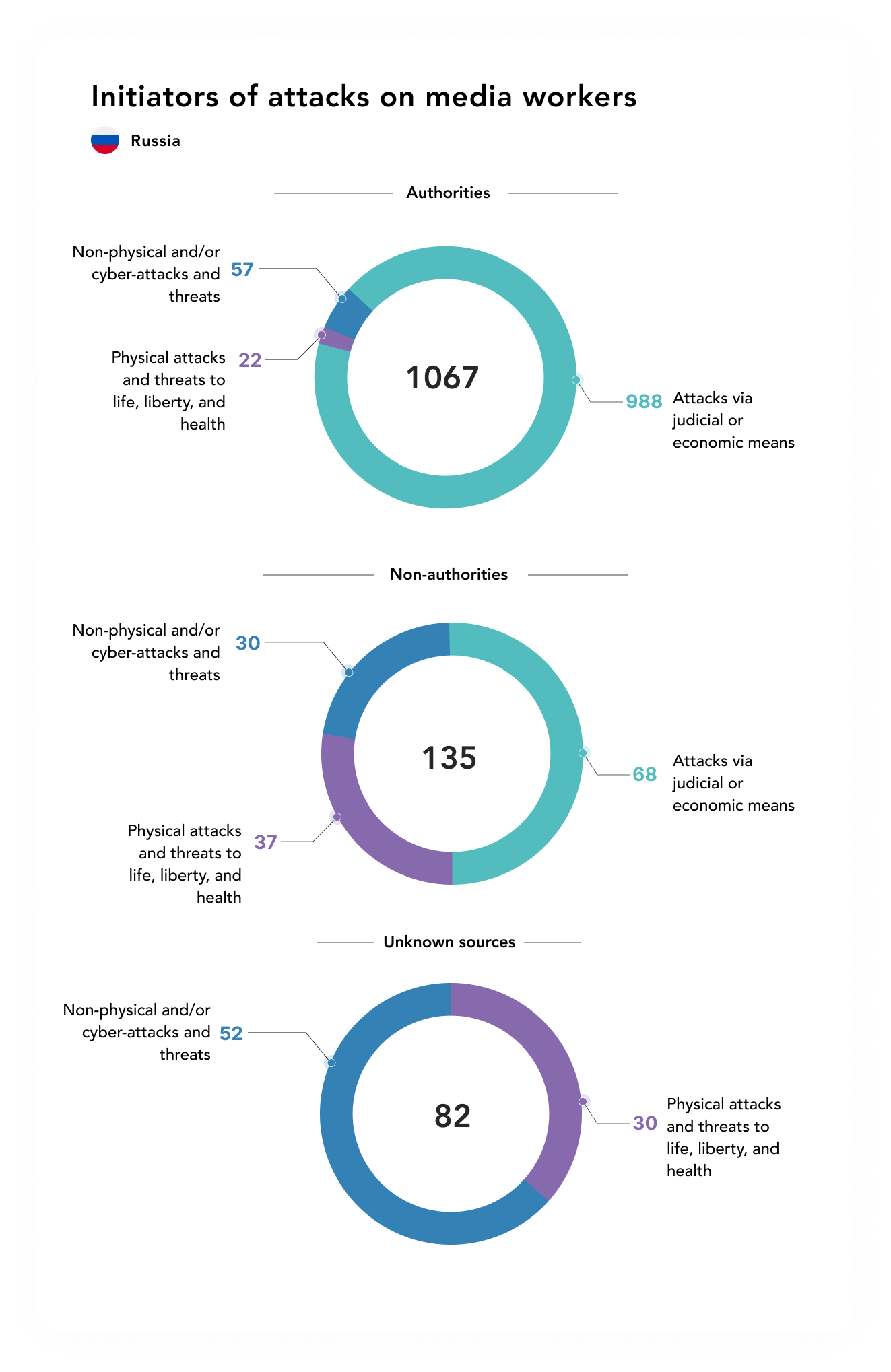
In 2020 the number of physical attacks remained nearly unchanged (89); that said, eight journalists perished – in 2019 there had been three. Incidents of death as the result of infection with COVID-19 are left out of the given report on attacks on media workers.
Non-physical and/or cyber-attacks and threats recorded in 2020 were nearly double the previous amount – 139 as opposed to 76 – on account of a sharp rise in instances of bullying, pressure, and threats of violence and death, as well as cyber-attacks.
A particular pretext for attacks on professional and citizen journalists became the COVID-19 pandemic and the new restrictions and laws associated with it. 177 out of the 188 incidents represent attacks via judicial means – above all charges of dissemination of knowingly false information or of violating the rules for self-isolation and quarantine, and fines and short-term detentions associated with this.
Cited in the report are examples of the most widespread kinds of attacks on media workers. All the facts of assaults from 2017 through the present moment have been gathered together on the Media Risk Map on the Justice for Journalists Foundation website.
HYBRID ATTACKS
For the purposes of more precisely reflecting combination assaults on media workers in 2020 we are introducing a new category of attacks – hybrid.
We are calling systematic persecution of some publication or media worker with the use of tools from two or more categories of assaults – physical, non-physical, and judicial/economic – “hybrid”. Such a combination of means involving and not involving force with judicial means of pressure on undesirable journalists is carried out with a view to demoralising them or getting them to self-censor or to give up the profession or even life itself.
In 2020, 33 journalists and bloggers were victims of hybrid attacks. Moreover, the most frequent kind of such attacks (14) was the use of non-physical assaults in combination with judicial means. Presented below is the top-10 list of the journalists and bloggers who were being subjected to the most intensive hybrid attacks in 2020.

- The tragic death on 2 October 2020 of Irina Slavina, editor-in-chief of the Nizhny Novgorod publication Koza.Press, became the consequence of many years of hybrid attacks. The systemic harassment of the journalist included several administrative violation cases, fines, leaflets with abusive language in the entrance to the block of flats where she lived, and constant denunciations and police checks. The last straw became a search in her flat at 6 in the morning on 1 October as part of a criminal case about participation in an “undesirable organisation” (her denunciation had been written by Ilya Savinov). 12 employees of the Investigative Committee of the Russian Federation, the police, and the SOBR [Special Rapid Response Unit] seized all the electronic information storage media, computers, and telephones of the journalist and her family, and all work-related writing pads. Besides that, the Koza.Press website was subjected to a DDoS attack. The next day the journalist committed suicide, having inculpated the Russian Federation in her death in a Facebook post.
- Being subjected to systematic hybrid attacks is the founder and editor-in-chief of the Novosti Kiselevska website, Natalia Zubkova, who gained international prominence after the publication of a video address by the inhabitants of the settlement of Podzemgaz to prime minister of Canada Justin Trudeau concerning a catastrophic environmental situation. In May 2020, a case was started up against Zubkova for dissemination of unreliable information (article 13.15 of the Code on Administrative Offences); she and her family were threatened with death on numerous occasions for her investigations; in August the focus of one of her articles, the lawyer Anton Reutov, struck her in the presence of bailiffs who had come to take the journalist’s car as recovery of damages in a lawsuit on defence of honour and dignity. In December the Novosti Kiselevska website was subjected to a series of DDoS attacks.
- On 30 June, in St. Petersburg at polling station N2191 during the time of voting on amendments to the Constitution, policeman Denis Dmitriev beat up photographer David Frenkel and broke his arm. On 27 July, the Dzerzhinsky District Court of Saint Petersburg fined Frenkel 500 roubles in a case of failure to obey a policeman (article 19.3 of the Code on Administrative Offences) at the polling station. The court likewise set him a two thousand rouble fine in a case of interference in the implementation of the work of an electoral commission (article 5.69 of the CoAO) and issued a warning in a case of violation of the “self-isolation regime” (article 20.6.1 of the CoAO). On 27 August, all the windows of the photographer’s car were smashed and all the tyres punctured, while the day before this his lawyer received notification of a refusal to initiate a case with respect to Frenkel’s report of crime about policemen having assaulted him.
4/ PHYSICAL ATTACKS AND THREATS TO LIFE, LIBERTY, AND HEALTH
The quantity of physical attacks in 2020 grew by a quarter in comparison with 2017. The level of cruelty of the crimes against journalists also increased, no doubt contributing to which is the fact that year in and year out the majority of them remain unsolved.
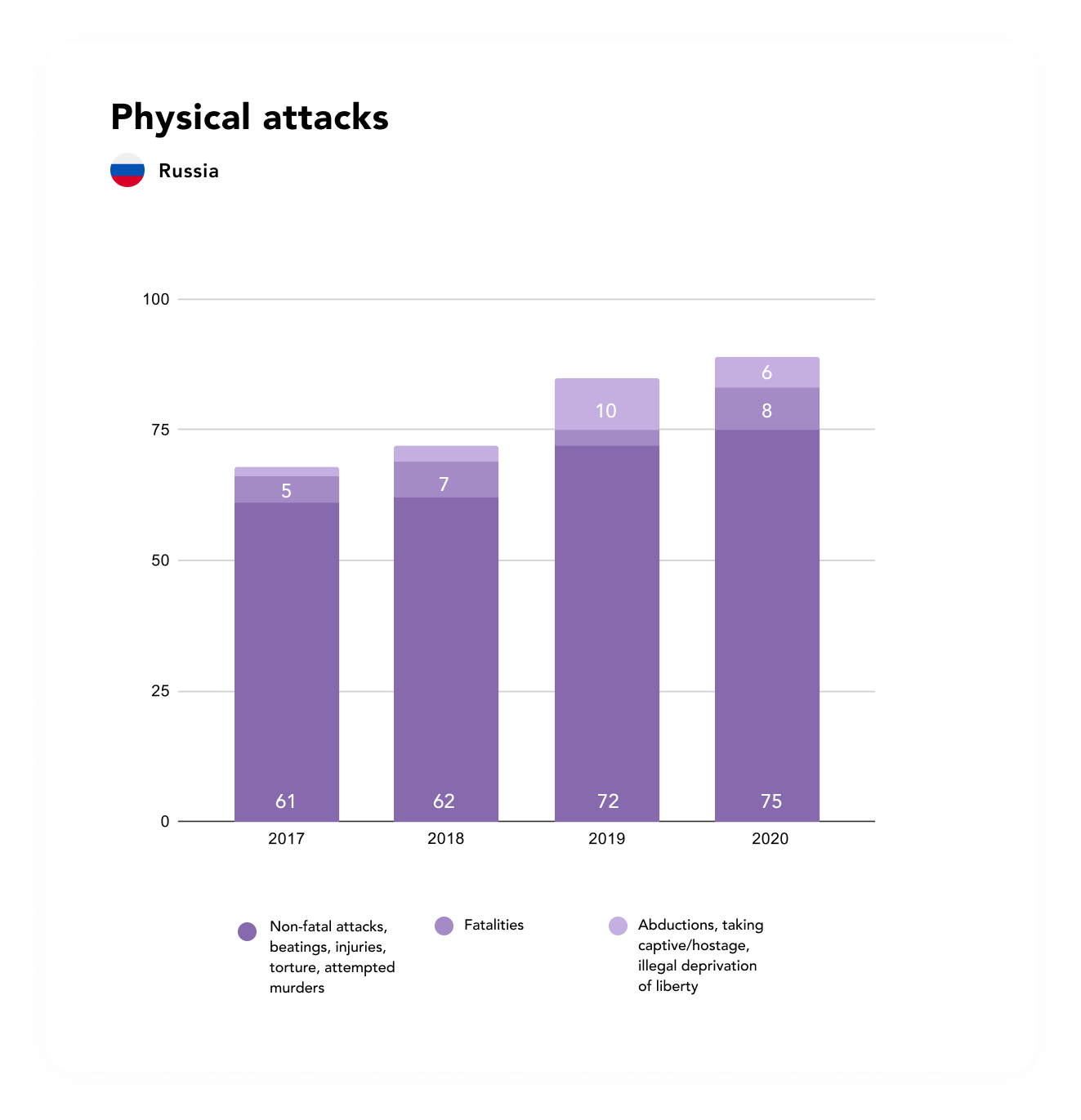
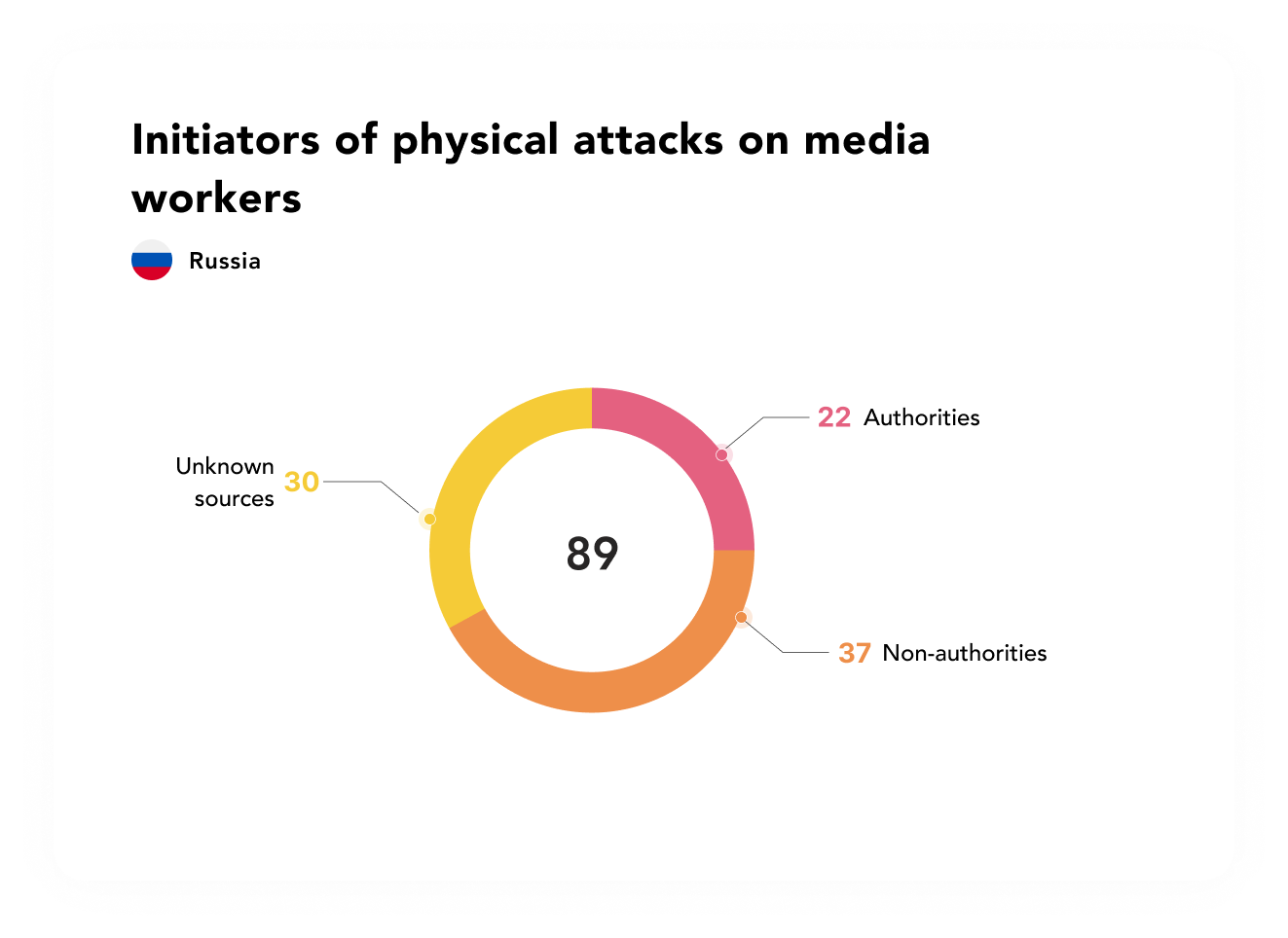
FATAL INCIDENTS AND ATTEMPTED MURDERS
The most high-profile incidents in 2020:
- Chechen blogger and critic of Ramzan Kadyrov, Imran Aliyev (Mansur Stary), was stabbed to death on 30 January in the French city of Lille. The main suspect, 34 year old Usman Mamadiyev, returned to Chechnya.
- On 26 February, another opposition Chechen blogger, Tumso Abdurakhmanov, who had fled from Chechnya in 2015, was able to fight off his would-be murderers. Russian citizens Ruslan Mamayev and Elmira Shapiayeva were convicted, while the Swedish court named the blogger’s criticism of former president of Chechnya Akhmad Kadyrov and current head of the republic Ramzan Kadyrov as the reason for the attempt on his life.
- Mamikhan Umarov, known as “Anzor from Vienna” – yet another popular Chechen blogger speaking out against Kadyrov and his retinue – was killed with a shot to the back of the head on 4 July in a suburb of Vienna.
- An attempt on the life of opposition Chechen blogger Musa Lomaev, residing in Finland, was thwarted with the help of information passed on to him by the 1ADAT Telegram channel. The suspect was detained in Finland on 10 September.
- In those same days the moderator of the 1ADAT Telegram channel chat room, Salman Tepsurkaev, was abducted in Gelendzhik by people with Ministry of Internal Affairs identification documents, after which, judging from his telephone’s geolocation data, he was driven out onto the territory of the police patrol and checkpoint service’s Akhmad Kadyrov Regiment in Grozny. A video was posted on the internet in which he is being subjected to humiliation, torments, and sexual violence. At the time of the writing of the report (February 2021) it is unknown if Tepsurkaev is still alive.
- On 15 October, the Khabarovsk journalist for RusNews Sergey Plotnikov, who had been conducting live video reports from protest events, was abducted by unknown persons. They drove the journalist out into a forest and were intimidating him by shooting at the legs and feet. After several hours of tormenting him they released him.
- The Rostov journalist and human rights advocate Aleksandr Tolmachev, who had spent nearly nine years in prison on a charge of extortion, died suddenly on 9 November in an Orenburg penal colony a month before release. Activists consider the case against him to have been fabricated in retaliation for articles exposing corruption in the courts and police.
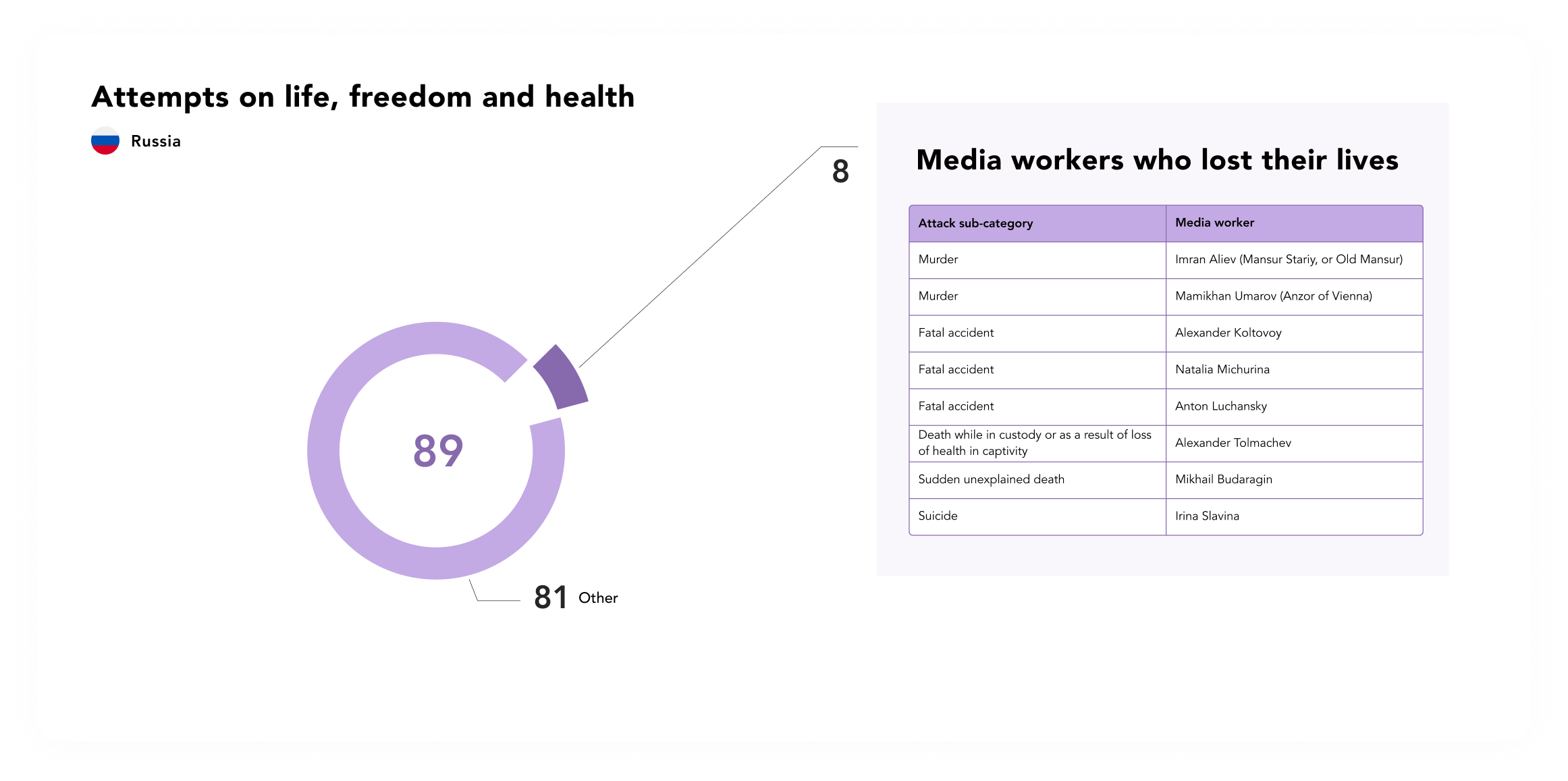
NON-FATAL ATTACKS, BEATINGS, INJURIES, TORTURE
There were 70 recorded incidents of non-fatal assaults, beatings, and torture of journalists in 2020. As before, revenge beatings are widespread, committed after hard-hitting material has come out. Investigations of such beatings, committed by unknown provocateurs or hired thugs known as “titushki” are, as a rule, not conducted or do not lead to any results. Here are some examples:
- The beating of former VGTRK camera operator Leonid Krivenkov, which occurred after he had given an interview about political censorship at the state channel.
- Oleg Anisimov, founder of the Vklader portal and initiator of investigations into financial machinations, was beaten unconscious by unknown persons as he was returning home from a shop.
- Polina Ryabova, correspondent for the independent Altai newspaper Listok, was assaulted in a cafe. The journalist was beaten and humiliated for her publications about the district authorities.
- Dmitry Nizovtsev, formerly a journalist with the Khabarovsk Region television channel Gubernia, and subsequently presenter of the programme Navalny Live, was beaten up after his latest live video broadcast from a protest rally in Khabarovsk.
- Blogger and Ekho Moskvy radio presenter Yegor Zhukov was twice subjected to assault by unknown persons who addressed him by name.
- Aleksandr Dorogov, video blogger and Rosderzhava journalist, was beaten by four cellmates in Yegorievsk’s pre-trial detention facility “for the stories that he shoots”.
Journalists are frequently assaulted and beaten, often having their equipment seized or damaged, right as they are working – whilst taking pictures or videos for stories, conducting interviews, etc.
- In Surgut, three men beat SurgutInform-TV correspondent Yevgeny Neupokoyev unconscious while he was filming a story at an impound car park.
- In Nizhnevartovsk, tour firm director Ruslan Ivashko beat up Megapolis television channel camera operator Ilya Beglenok and damaged his equipment.
- In Anapa, a journalist filming the demolition of a house on video was beaten and had her telephone taken away by a lawyer representing a law-enforcement officer who was a beneficiary of the building’s demolition.
- In Moscow, Kommersant journalist Andrei Zhdanov was beaten up and robbed as he was shooting pictures of currency exchange rates on assignment from the editorial office.
- In Krasnoyarsk, businessman Alexey Talyuk knocked down Dezhurnaya chast programme correspondent Pavel Brykin with his Mercedes as the latter was trying to interview him.
- In Syktyvkar, three unknown persons sprayed pepper spray in Novaya respublika publication journalist Viktor Kokarev‘s face while he was filming a story about pre-election agitation.
Parishioners and security guards at Orthodox churches are noted for their
- Video blogger Mikhail Baranov was beaten up by NOD [National Liberation Movement] and SERB [South East Radical Block] militants and Orthodox activists during a funeral service for the protopriest Vsevolod Chaplin.
- Television presenter Ksenia Sobchak and her camera crew were beaten up and robbed in the Sredneuralsk Women’s Convent during shooting of video for a story about the Schema-Hegumen Sergii.
Three incidents of beatings of journalists shooting pictures at Easter services during the time of a prohibition on the conducting of mass events are reflected in the section on Pressure on journalists under the pretext of restrictions connected with the COVID-19 pandemic.
Beatings of professional and citizen journalists in the republics of the North Caucasus form an entirely separate topic. Besides the above-mentioned Salman Tepsurkaev, abducted in Gelendzhik and subjected to torture and abuse on the territory of Chechnya, the following were also subjected to beatings in the past year were :
- Novaya Gazeta journalist Elena Milashina in Grozny;
- blogger Said Gubdenskiy in Makhachkala;
- blogger and journalist Devid Mamendov in Vladikavkaz.
In a series of instances, deputies [MPs] and civil servants were assaulting journalists:
- Sergey Kozin, the head of a district in Penza Region, beat up journalist Alexander Rogozhkin, who had asked questions he found inconvenient.
- In the office of the Tagansky Electoral Commission, head of Moscow’s TEC Rimma Bakhtiyarova beat up the journalist Svetlana Vidanova and damaged camera operator Igor Vinkovsky’s camera.
- Duma deputy [MP] from the Saratov Region, Sergey Kurikhin, beat up Chetvertaya vlast publisher Vadim Rogozhin.
- Yugorsk’s Duma deputy [MP] Vladimir Bendus assaulted TochkaNews journalist Anton Pantin on the street and took away his telephone.
- Kirill Tsvetkov, an employee with the press centre of the city administration of Berdsk, beat up Svidetelnewspaper correspondent Sergey Boldyrev in the editorial office for a comment on social media.
As a rule, the police and state security services were assaulting journalists during short-term detentions at protests, searches, or simply during a document check.
- Khabarovsk police 5th precinct employee Vitaly Grebenyuk was dismissed from the bodies of internal affairs for an assault on a camera crew from the Gubernia television channel, while they filmed a road accident that had taken place due to the fault of a female acquaintance of his. He received a suspended sentence.
- Sovremennaya Kalmykia editor-in-chief Valery Badmayev was beaten up by a police lieutenant colonel in the police station where he was being questioned about participation in a picket showing solidarity with Khabarovsk.
- The administrator of the public channel YaGrazhdanin! Sergey Belyayev was beaten up in a Saint Petersburg police station after being detained in the course of protests against amendments to the Constitution.
- At the Prazhskaya metro station in Moscow, police inflicted bodily injuries to RusNews journalist Sergey Kouk in the course of a rough detaining as he had supposedly refused to show documents.
- Journalist Alexey Malinovsky of Kaliningrad’s Novye kolesa was beaten during a search of his flat in a libel case.
5/ NON-PHYSICAL AND/OR CYBER-ATTACKS AND THREATS
The number of attacks and threats of this type in 2020 exceeded the indicators for the previous year more than two-fold (139 and 76 respectively). The number of incidents associated with bullying, intimidation, and death threats increased nearly three-fold: from 22 to 59. The quantity of recorded cyber-attacks comprised 14 as opposed to 3 in 2019. Recorded break-ins and attempted break-ins to email and social media accounts numbered 13 as opposed to 9 in 2019.
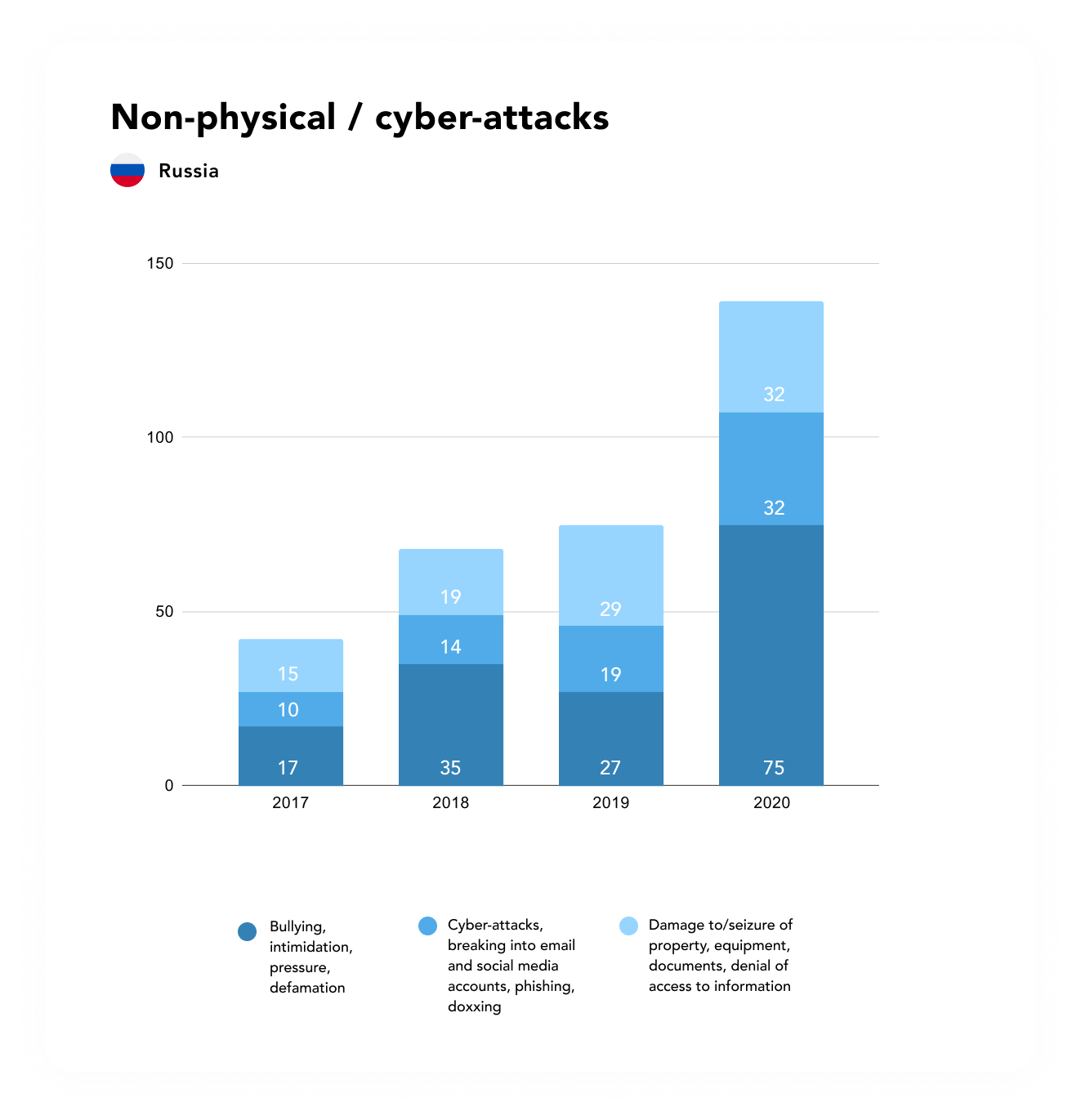
Subjected to attacks most frequently were:
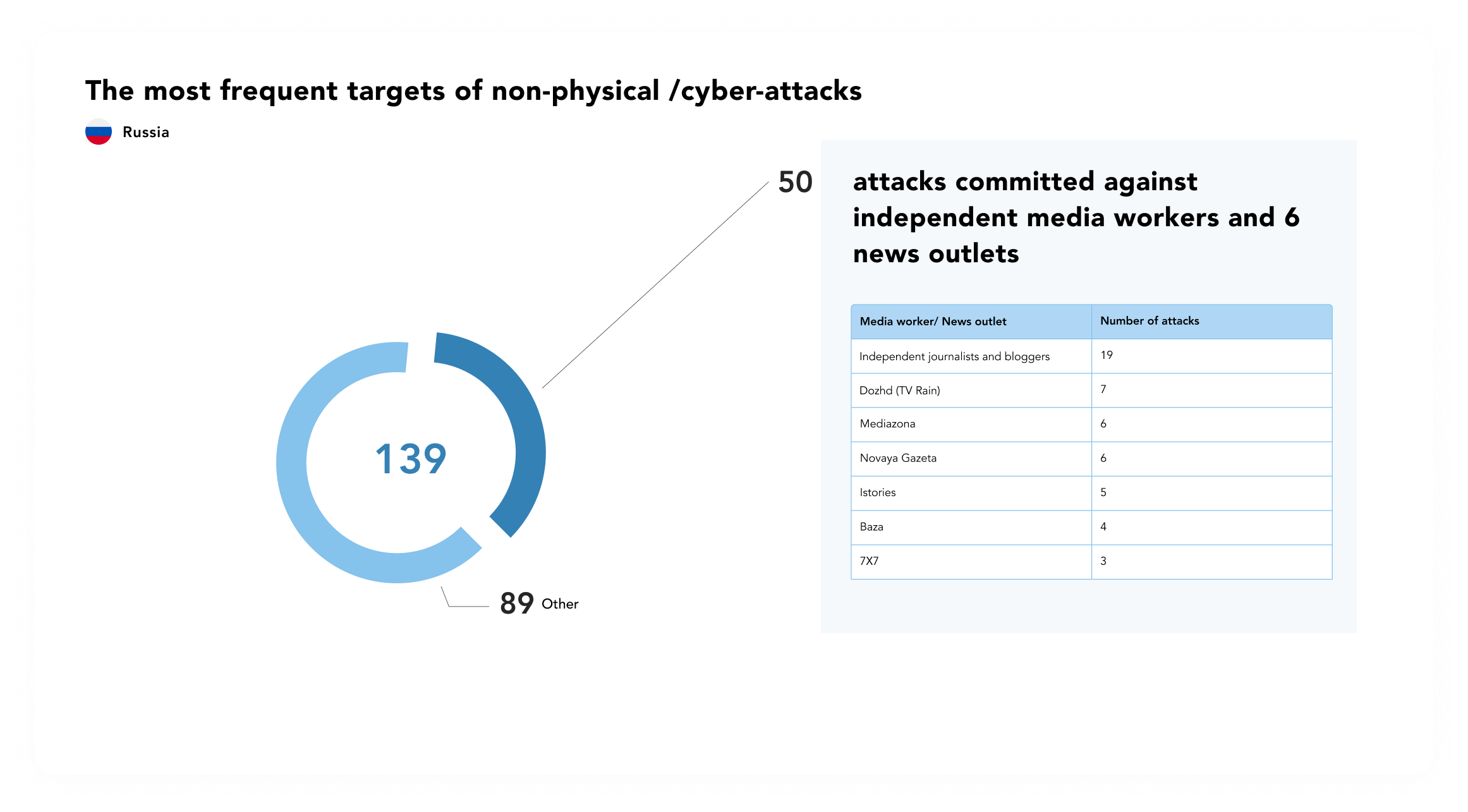
As a rule, bullying, pressure, and threats are accompanied by either physical assaults on media workers or arrests and short-term detentions, or cyber-attacks, and sometimes even a whole series of attacks of different types. This year religious fundamentalists and so-called “defenders of traditional values” stand out among the assailants. Some of those receiving verbal abuse and threats from them included:
- television presenters Ivan Urgant – for jokes on religious topics (“offending the sensibilities of believers”) and Ksenia Sobchak – for critique of the reaction of Islamists to the Charlie Hebdo caricatures;
- editor of the magazine Daptar Svetlana Anokhina – for creating emergency care centres for women who had been subjected to domestic violence. After numerous death threats, Anokhina was forced to flee Dagestan.
- Instagram and TikTok blogger Maria Magdalena Tunkara from St. Petersburg – for clips talking about racism in Russia;
- blogger Nika Vodvud, about whom a complaint was made for “propaganda about non-traditional sexual relations”;
- bloggers and journalists covering the activity of the artist Yulia Tsvetkova, the prosecution of the Khachaturyan sisters, and Pussy Riot’s protest performances.
PRESSURE ON JOURNALISTS THROUGH RELATIVES
In comparison with the previous years, the number of incidents of pressure on journalists by means of intimidating their loved ones increased. Among the victims were:
- friends and acquaintances of the Khabarovsk video blogger Sergey Naumov,
- relatives of the Ekaterinburg video blogger Ruslan Sokolovsky,
- the wife and children of the editor of St. Petersburg’s MK Maxim Kuzakhmetov.
Pressure was exerted by the police, the Centre for Combating Extremism, and the police together with children’s services agencies, respectively.
According to a number of witnesses, the father of Salman Tepsurkaev, who had been subjected to torture, involuntarily recorded a video with a renunciation of his son.
Karina Dzhikayeva, sister of the North Ossetian Instagram blogger Malika Dzhikayeva who had been arrested in Grozny, was found dead in a flat in the north of Moscow.
DAMAGE TO AND SEIZURE OF PROPERTY, EQUIPMENT, DOCUMENTS, JOURNALISTIC MATERIALS, PRINT RUN
20 attacks of the given type were recorded in 2020. Most often the equipment is deliberately broken, simultaneously with the beating and/or detention of the journalists or with the impeding of their professional activity. There are other incidents as well, however.
DESTRUCTION OF/ DAMAGE TO A JOURNALIST’S AUTOMOBILE IN RETALIATION FOR PROFESSIONAL ACTIVITY
- TNT Vorkuta head Gennady Knyazev’s car was set on fire (after he had released material on the non-payment of bonuses to ambulance crews).
- The windows of Dzerzhinskoe Vremya editor-in-chief Sergey Kulakov‘s car were smashed in July, while on New Year’s Eve the vehicle was completely destroyed by fire as the result of arson recorded by surveillance cameras.
- Znak.com Chelyabinsk correspondent Marina Malkova‘s car was set on fire.
CYBER-, DDoS-, AND HACKER ATTACKS AND BREAK-INS TO SOCIAL MEDIA ACCOUNTS
The main targets of the cyber-malefactors in 2020 were
- the Navalny Live YouTube channel
- the accounts of the editor of Fergana.ru
- the accounts of employees of the Vazhnye istorii publication
- MediaZona
- the servers of the Rain television channel
- the website and the computers of employees of Ekho Moskvy
- TheInsider
- Znak.com
- the website of the Sobesednik newspaper
- Pskovskaya gubernia
- Bloknot. Taganrog
- the Kuzbass internet newspaper Novosti Kiselevska
- the social media accounts of Ekaterinburg political scientist Fedor Krashennikov
- the social media accounts of Ufa blogger Ruslan Nurtdinov.
The account break-ins and hacking and other cyber-attacks were as a rule taking place after the publication of high-profile investigations of crimes and corruption in circles of power and near the power. There were 26 such incidents recorded, however we maintain that there were actually far more of them as journalists accept such attacks as a normal part of their work and rarely report them.
DOXXING
A minimum of three journalists and bloggers this year were subjected to doxxing, or publication of information about their place of residence:
- Yuri Izotov, a journalist with the banned Grani.ru, who was forced to flee Russia because of persecution;
- a journalist with UralPress from the city of Zlatoust, whose data were posted by unknown persons on a sex services website;
- Maria Magdalena Tunkara, an Instagram and TikTok blogger (submitted a report of crime to the police about a person threatening to kill her, who had also revealed her address).
6/ ATTACKS VIA JUDICIAL AND/OR ECONOMIC MEANS
The number of such attacks in 2020 exceeded the aggregate indicator for the three previous years by a factor of two and consisted of 1056 incidents. On the whole, we can speak of the state’s system of repressions against professional and citizen media workers finally having come together: they are being prosecuted under a concrete list of Administrative and Criminal Code articles. Once a media worker ends up in the meat grinder of this system, each new punishment becomes more severe: from relatively insignificant fines for violating the rules on protesting, to 19 years in a strict regime penal colony for participating in an extremist and terrorist organisation.
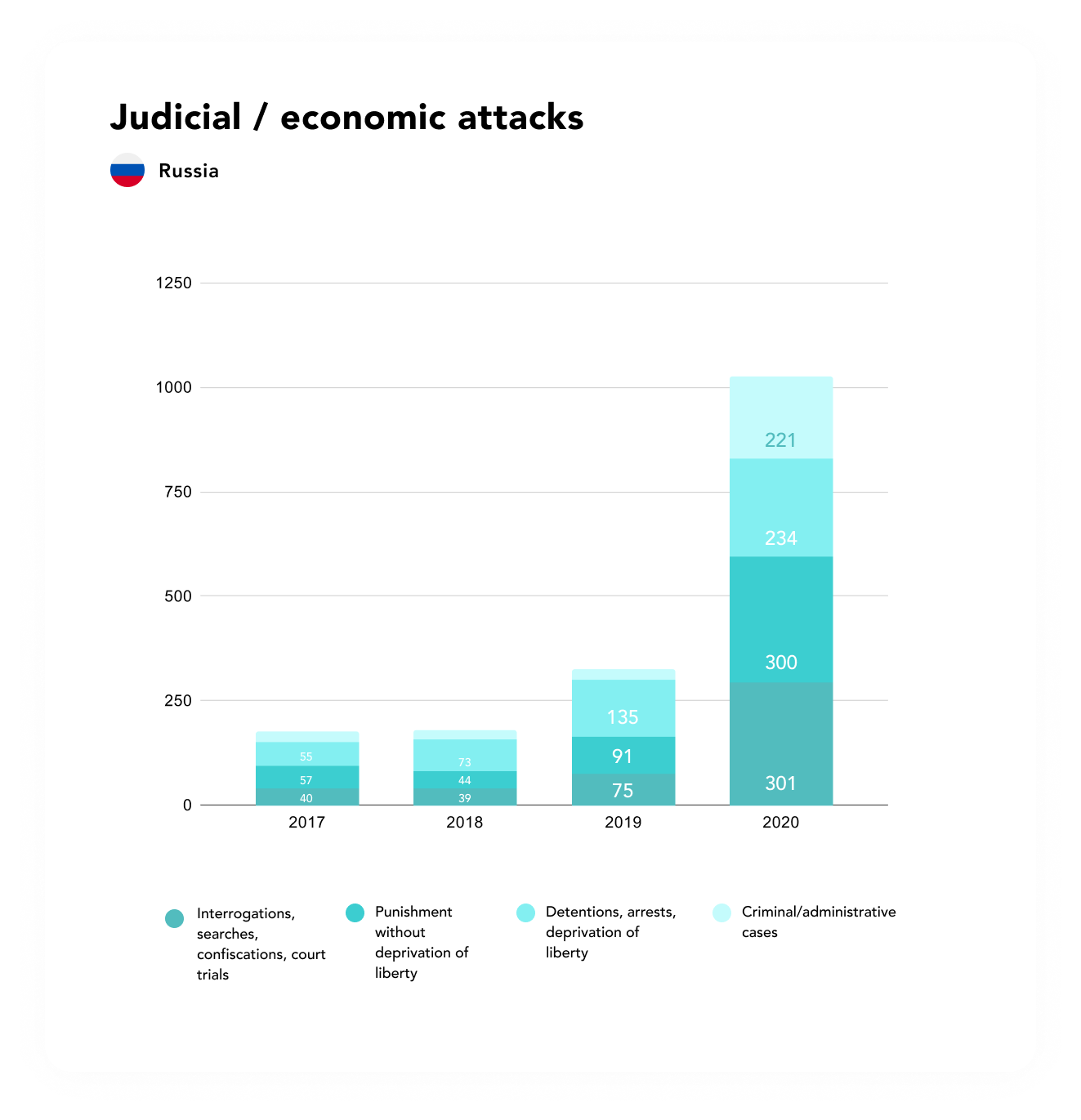
69 journalists were subjected to arrest, including remand – four times more than in 2019.
There were no fewer than 211 court trials of journalists, which exceeds last year’s indicator by a factor of six.
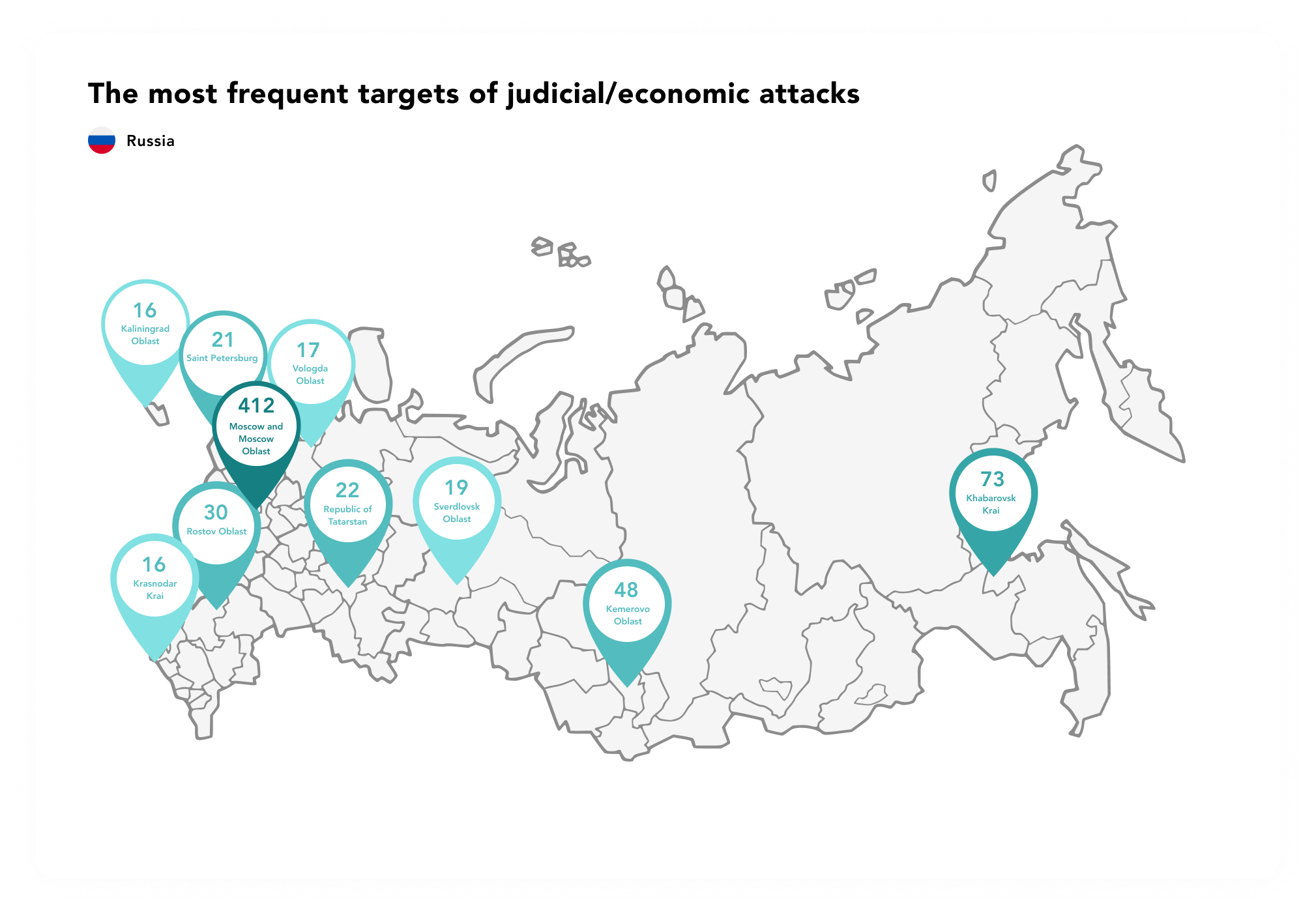
COURT TRIALS
Nearly a third of all the court trials against journalists (62) took place in Moscow: professional and citizen media workers were most often tried under administrative code articles on:
- violation of the rules for picketing (part 5 of article 20.2 of the Code on Administrative Offences)
- repeat violation of the rules for participating in a public event (part 8 of article 20.2 of the CoAO)
- failure to obey the police (article 19.3 of the CoAO)
- organisation of an unapproved public event (part 2 of article 20.2 of the CoAO)
- participation in a public assembly creating an obstruction to traffic (part 6.1 of article 20.2 of the CoAO)
- violation of the self-isolation regime (article3.18.1of the CoAO of Moscow)
The methods of prosecuting journalists under criminal and administrative code articles connected with the pandemic are examined separately below, in the section on ” Pressure on journalists under the pretext of restrictions connected with the COVID-19 pandemic.”
ADMINISTRATIVE CASES
Many Moscow journalists were fined and/or sentenced to compulsory work and administrative arrests for participating in or covering protests against:
- the arrest of former Kommersant journalist Ivan Safronov, charged with high treason;
- the arrest of journalist and politician Ilya Azar for 15 days for a single-person picket in support of the previously arrested activist Viktor Nemytov and administrator of the Ombudsmen politsii public channel Vladimir Vorontsov;
- the prosecution of Pskov journalist Svetlana Prokopieva under the article on justification of terrorism.
Based on the results of a minimum of 20 court trials of journalists covering the protests in Khabarovsk, 17 people received fines and various terms of administrative arrests. It is specifically in Khabarovsk that the “revolving door” mechanism for the arrest and conviction of journalists has been successfully implemented. For example, the Central District Court of Khabarovsk thrice tried video blogger Anton Kurdyumov: after each term he had completed he was once again being detained and driven off to court, where he would be given his next term.
CRIMINAL CASES
The quantity of charges against journalists and media outlets for libel, insult, and reputational damage grew nearly seven-fold: from 13 in 2019 to 85 in 2020. In the vast majority of instances, the journalists and media outlets were found guilty and required to pay compensation for pain and suffering.
The greatest number of lawsuits under these articles was examined in Moscow (26). Among the plaintiffs ought to be mentioned senators Suleyman Kerimov and Yelena Mizulina, the state company Rosneft, Russia Today, ex-minister of culture Vladimir Medinsky, MGIMO [Moscow State Institute of International Relations] prorector Natalia Kuzmina, the Aeroflot airline, the Concord firm which belongs to Yevgeny Prigozhin, and Roscosmos head Dmitry Rogozin.
The harshest punishments were borne by 12 journalists, whom military courts sentenced to lengthy prison terms in strict and general regime penal colonies on charges of extremism, links with terrorists, calls for terrorism, high treason, justification of Nazism, and calling for the overthrow of the constitutional order.
- The Southern District Military Court in Rostov-on-Don sentenced four independent citizen journalists from Krymskaya solidarnost under part 2 of article 205.5 of the Criminal Code (participation in the activity of a terrorist organisation) and article 278 (preparation of a violent seizure of power) with the application of part 1 of article 30 of the CC. Bloggers Marlen Asanov, Server Mustafayev, Seyran Saliyev, and Timur İbragimov received from 14 to 19 years in a strict regime penal colony.
- The 2nd Western District Military Court in Moscow sentenced Dagestani blogger Alibek Mirzekhanov to 10 years of strict regime on a charge of participating in the activity of a terrorist organisation (part 2 of article 205 of the CC).
- The Central District Military Court in Samara sentenced Bashkir activist Ayrat Dilmukhametov to 9 years of strict regime. He was declared guilty under four articles of the CC at once: on two counts of public calls for separatism on the internet (part 2 of article 280.1 of the CC; 3 years for each count), of financing extremism (part 1 of article 283.1 of the CC; 5 years), of public calls for extremism (part 1 of article 280 of the CC; 2 years), and of public justification of terrorism on the internet (part 2 of article 205.2 of the CC; 6 years).
- An appellate military court in Vlasikha near Moscow upheld the sentence for Kalugan blogger Ivan Lyubshin: 5 years and 2 months of general regime. The blogger was found guilty under part 2 of article 205.2 of the CC (public justification of terrorism through the internet) for a comment on VKontakte about the bombing of the Arkhangelsk Administration of the Federal Security Service [FSB]. The blogger was being beaten and tortured upon being detained in October 2019. In 2017, Lyubshin became a figurant in cases under part 1 of article 282 of the CC (arousing hate or enmity), part 2 of article 354.1 (rehabilitation of Nazism), and item «b» of part 3 of article 242 (distribution of pornography) for posts on VKontakte.
- The Second District Military Court, at a circuit session in Kursk, sentenced local citizen journalist Sergey Lavrov to five years in a general regime penal colony on a charge of public calls for terrorist activity on the internet (part 2 of article 205.2 of the CC).
- The Southern District Military Court sentenced blogger Valery Klimenchenko from Rostov-on-Don to four years and one month in a general regime penal colony in a case of justification of terrorism (part 2 of article 205.2 of the CC) and insulting the authorities (article 319). In 2018 Klimenchenko had published the post “Mikhail Zhlobitsky’s Feat” about the bombing of the Arkhangelsk FSB Administration, as well as two posts about policemen, on VKontakte.
- Kaliningrad blogger Aytahaji Halimov was sentenced to three and a half years in a general regime penal colony under part 2 of article 205.2 of the CC (public calls for terrorism on the internet) for three documentary video clips about the Chechen war published on VKontakte.
- A military appellate court in Vlasikha near Moscow upheld the sentence for Crimean Tatar blogger Nariman Memedeminov, having denied the defence’s appellate complaints. He served two and a half years in a settlement-colony in a case of public calls for terrorism (part 1 of article 205.2 of the CC) for three videos published on his personal YouTube channel even before the annexation of Crimea, and two reposts of other peoples’ video recordings on VKontakte.
We shall note several more high-profile criminal cases that gained momentum in 2020. Some of the journalists have already been convicted; others are awaiting hearings.
- The 2nd Western District Military Court sentenced Pskov journalist Svetlana Prokopieva to a fine of 500 thousand roubles, having found her guilty of public justification of terrorism (part 2 of article 205.2 of the CC). The prosecutor had requested that Prokopieva be given 6 years in a penal colony with a four-year prohibition on her profession. The journalist was being tried for a comment on the air of Ekho Moskvy v Pskove concerning the bombing of the Arkhangelsk FSB Administration.
- Bryansk video blogger Alexander Kolomeytsev was sentenced to one year three months of deprivation of liberty to be served in a settlement-colony. He had been accused of battery, insulting representatives of the authorities, and violation of the inviolability of private life. Five criminal cases in all were initiated against Kolomeytsev. He was shooting exposé stories about Bryansk public officials.
- The Zavodskoy District Court of Grozny sentenced video blogger Ilham Nukhanov to 4 years in a settlement-colony in a fabricated case of storing cartridges and use of force on a policeman. Nukhanov was abducted and subjected to torture in November 2019 after publication of a video from the elite residential community of Baronovka in the centre of Grozny, where the top Chechen public officials and their relatives live.
- Since 7 June, advisor to the head of Roscosmos and former Kommersant and Vedomosti correspondent Ivan Safronov has been awaiting trial in the SIZO-2 Lefortovo pre-trial detention facility on suspicion of high treason. The FSB suspects him of working for one of the NATO special services; he faces from 12 to 20 years in a penal colony.
- Blogger Karim Yamadayev, from Naberezhnye Chelny, spent about a year in Samara’s pre-trial detention facility on a charge of insulting the authorities (article 318 of the CC) and public calls for terroristic activity, justification or propaganda of terrorism (part 2 of article 205.2 of the CC) for a video clip about a trial of Putin, Peskov, and Sechin (sentenced to a fine of 510 thousand roubles and released on 4 March 2021).
- Blogger Vladimir Vorontsov, a retired police major and founder of the popular public channel Ombudsmen politsii, is in the Muscovite SIZO-4 pre-trial detention facility since 7 May 2020; no fewer than 14 criminal cases have been initiated against him, including on charges of extortion (article 163 of the CC), distribution of pornography (article 242 of the CC), libel (article 128.1 of the CC), and insulting a representative of the authorities (article 319 of the CC).
- In Kemerovo, two participants in the “Don’t be inert” project — the video bloggers Maxim Lavrentiev and Sergey Kamensky have been in custody since the end of July. They are charged with hooliganism committed by a group of persons (part 2 of article 213 of the CC). A report of crime was written up against the bloggers when they were filming a clip about an illegal car park. According to another story, the YouTubers are being persecuted for shooting a clip about the FSB.
- Rosderzhava journalists Yan Katelevsky and Alexander Dorogov, who were detained after publication of an investigation about the funeral business, have been in custody since 29 June 2020. They are being charged in three criminal cases: under part 3 of article 163 of the CC (extortion), part 2 of article 167 (deliberate destruction or damaging of another’s property), article 213 (hooliganism), and article 319 (insulting a representative of the authorities).
CONFISCATION/SEIZURE OF PROPERTY, VEHICLES, EQUIPMENT, AND MATERIALS FOR EXPOSE STORIES IN 2020 DURING SEARCHES AND DETAINING OF JOURNALISTS
No fewer than 23 such incidents were recorded in 2020, in particular:
- The police seizedall of MBK Media chief editor Sergey Postakov‘s professional equipment and bank cards in the course of a search of his Moscow flat.
- Police seized Belsat correspondent Dmitry Lebedev‘s telephone while he was being detained at a NYET movement protest against amendments to the Constitution.
- Policemen took away flash cards from photographer Alexey Molotorenko, who was shooting pictures of a CPRF [Communist Party of the Russian Federation] rally “For honest elections” in Kostroma, and drew up an official record of the seizure.
- In Komsomolsk-on-Amur policemen took away all the material that had been shot by a camera crew from The New York Times working on a film about the activist Yulia Tsvetkova.
- Policemen took away all the professional equipment from an FBK [Anti-Corruption Foundation] camera crew as they were working on an investigation in Tatarstan.
- In the Penza Region, employees of the Roads Patrol Service stopped an automobile with the print run of the newspaper Novaya alternativa, which is critical in relation to the governor, and seized it.
- In the course of a detaining them during a performance by Pussy Riot, policemen took away Radio Liberty journalist Artyom Radygin‘s and Activatica reporter Denis Styazhkin‘s telephones and did not return them.
In connection with the rise in systemic persecution of a series of journalists for working with non-Russian organisations and individuals, in 2020 JFJ added a new sub-category of judicial attacks —designation of foreign agent status and/or judicial prosecution for non-compliance with the law on “foreign agents”.
At the very end of 2020, the Ministry of Justice included three journalists in the register of “foreign agent” media: Denis Kamalyagin and Lyudmila Savitskaya from Pskov, and Sergei Markelov from Petrozavodsk. They became the first journalists – individual persons designated as “foreign agents” under the new law.
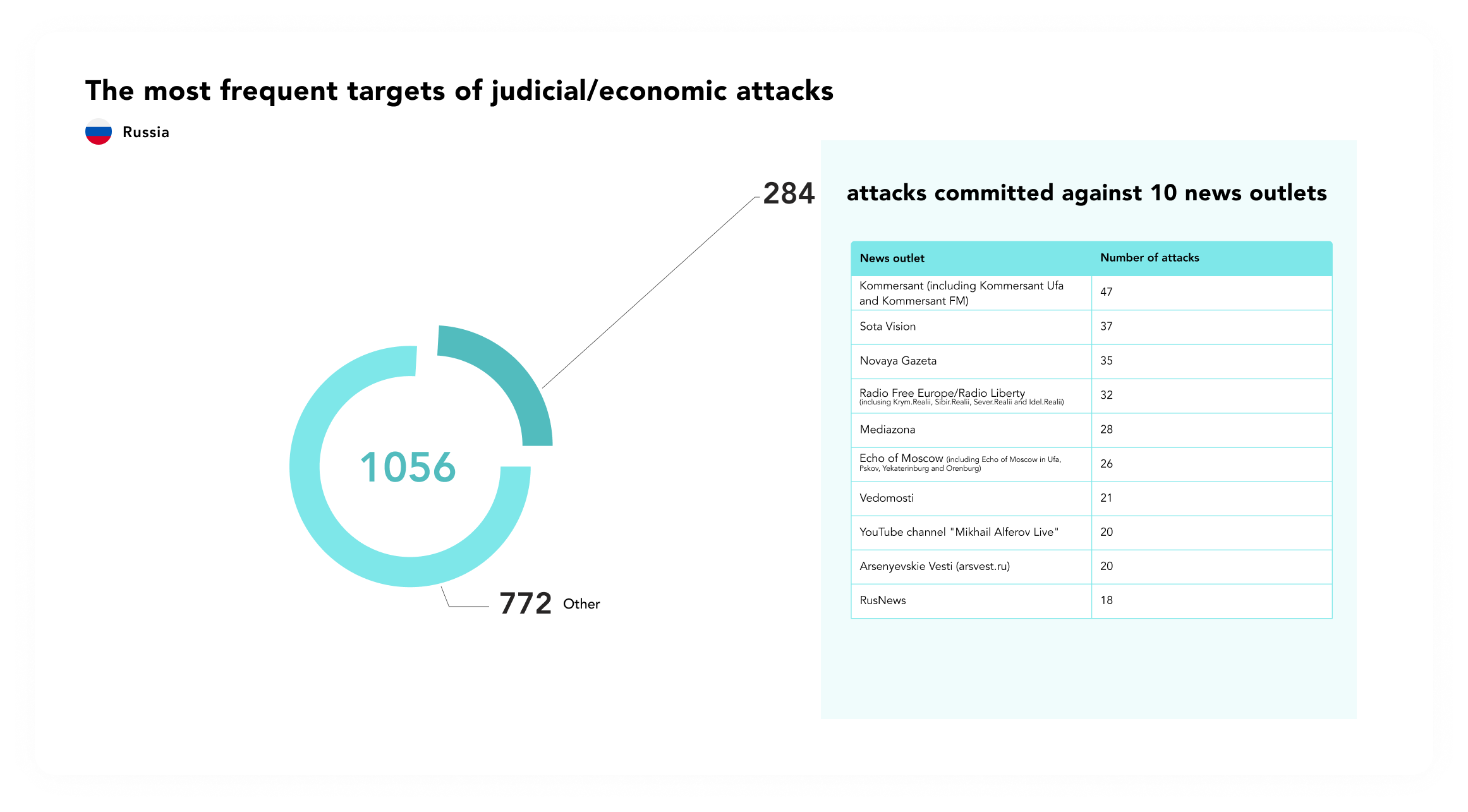
7/ PRESSURE ON MEDIA WORKERS UNDER THE PRETEXT OF RESTRICTIONS CONNECTED WITH THE COVID-19 PANDEMIC
The overwhelming majority of instances of attacks on journalists under the pretext of sanitary restrictions connected with the COVID-19 pandemic fall in the category of attacks via judicial means – 177 of 189. Besides that, three beatings of journalists shooting video of Easter services and nine non-physical and cyber-attacks have been recorded.
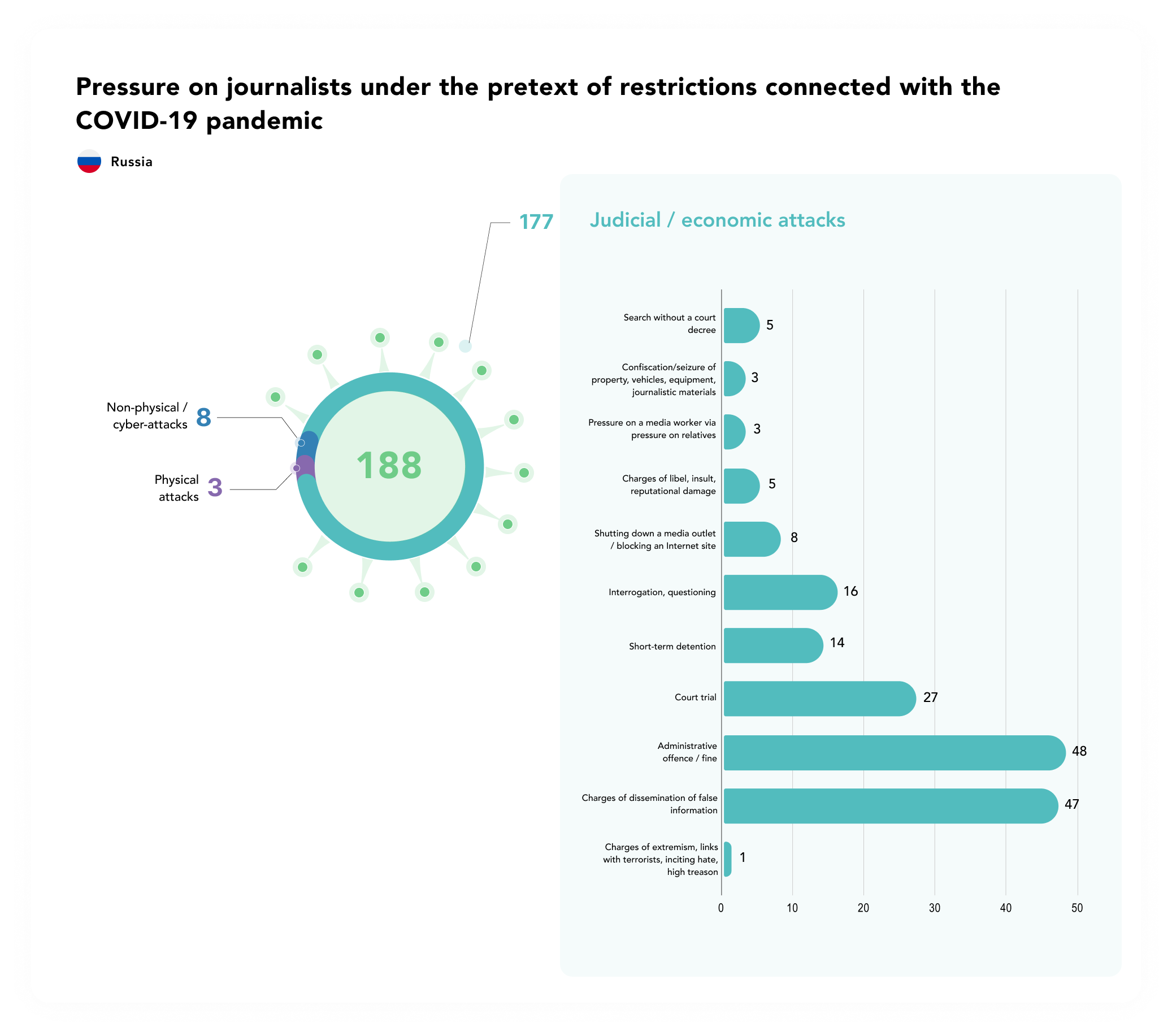
Three beatings took place in churches conducting Easter services in spite of the prohibition on mass events due to the threat of the spread of COVID-19:
- MediaZona photographer David Frenkel was beaten up and kicked out of a temple in Vsevolozhsk.
- A female journalist with the BAZA publication shooting pictures of a VIP service in the Sophia Wisdom of God temple in Moscow was beaten up by the actor Ivan Okhlobystin.
- Clergy and parishioners of the temple of the icon of the Mother of God “The Sign” in Omsk assaulted BK55 journalists and used force to try to take a telephone away from them.
Non-physical attacks included verbal abuse, humiliation, and threats addressed at media workers, and forcing them to remove publications under the pretext that they are “fake” or “deliberately false information” or “promote extremist activity”. Attacks of such a kind came, inter alia, from state television propagandists, the police, local authorities, president of the Chechen Republic Ramzan Kadyrov, the «E» Centre [for Combating Extremism], the FSB, the General Prosecutor’s Office, and the embassy of the RF in the USA. In the majority of instances such pressure and bullying were accompanied by the initiation of administrative or criminal cases.
- Thus, Kadyrov demanded that FSB “stop the non-humans who are writing, provoking my people” after Elena Milashina‘s publication about the realities of the coronavirus situation in Chechnya.
- The police came with a check to the Nizhny Tagil newspaper Mezhdu strok on the basis of a denunciation from the head doctor at the city hospital after an article was published about the coronavirus situation.
- Two criminal investigation workers conducted an interview with Krasnodar blogger Sergey Dorovskikh, threatening to initiate a criminal case for his critical publications.
- Zhivaya Kuban editor Konstantin Zvyagintsev was subjected to a similar visit from a local policeman, and was being threatened with a criminal case for extremism for his article about mass gatherings of people in the period of the pandemic.
- The prosecutor’s office “recommended” to Denis Volin, editor-in-chief of Orlovskie novosti, to remove part of a published interview about the shortage of beds in hospitals.
- The Bloomberg agency was forced to enter changes into material on the coronavirus in Russia after a strongly worded statement from Russia’s embassy in the USA.
Leading among attacks via judicial means were charges of disseminating false information or fakes.
At the end of March, the authorities hastily added a new article (207.1) to the Criminal Code (public dissemination of knowingly false information about circumstances presenting a threat to the life and safety of citizens), which carries up to 3 years of deprivation of liberty. No fewer than 12 publications and journalists were subjected to prosecutions under this article (searches, initiation of a criminal case, interrogations as witnesses or accuseds), including:
- three independent journalists from Karachay-Cherkessia – editor-in-chief of the Cherny Kub YouTube channel Vladimir Bidzhiyev, Region Online journalist Yana Toporkova, and Zhizn bez barierov journalist Anna Dargan;
- blogger Alexander Torn from Moscow;
- Novaya gazeta and Ekho Moskvy observer Yulia Latynina from Moscow;
- Reporter-NN editor-in-chief Alexander Pichugin from Nizhny Novgorod;
- administrator of the VK group Sestroretsky aktiv Anna Shushpanova from Sestroretsk.
Besides that, widely applied was part 9 of article 13.15 of the Code on Administrative Offences (publication of false information creating a threat to public order), under which cases were initiated in relation to no fewer than 35 journalists and media outlets. As a rule, the authorities were calling information about the existence and quantity of infected persons, about shortages of beds in hospitals, about deaths from COVID-19, and expert estimates of the number of victims of the virus “a fake news about the coronavirus”. Fines under this article ranged from 15 thousand roubles (for Novokuybyshevsk journalist Anna Krylova for publication of information about a patient which had been taken from his personal social media page) to 750 thousand roubles (for the Perm internet magazine Zvezda for publication of the number of medical personnel infected with the virus). Among others there was also Irina Slavina, fined 65 thousand roubles for the article “First case of coronavirus identified in Kstov”.
In second place by the number of attacks via judicial means associated with COVID-19 was the imposition of fines against journalists. Besides “dissemination of fakes”, the pretexts for handing out fines were, as a rule:
- Violation of the self-isolation regime– article 20.6.1 of the CoAO (among others – Yevgeny Domozhirov from the Permian Pozitsia, Pyotr Verzilov from MediaZona, Ilya Azar, Elena Chernenko from Kommersant, Roman Ivanov from Pravda studiya, Alexey Melnikov from the Orenburgian Orenday, Denis Kamalyagin and Vladimir Kapustinsky from Pskovskaya gubernia, Ivan Zhuravkov from 7X7, Lyudmila Savitskaya from Severo-Zapad. MBK Media, Steven Derix and Konstantin Salomatin from NRC Handelsblad, Andrei Kysh from Sota.Vision, Sergey Belyayev from YaGrazhdanin!, blogger Ilya Varlamov and Elena Kostyuchenko and Yuri Kozyrev from Novaya Gazeta).
- Violation of the rules pertaining to public assembly – article 20.2 of the CoAO (Ilya Azar).
- Violation of the rules for picketing – part 5 of article 20.2 of the CoAO (Viktoria Ivleva).
- Failure to obey the police – article 19.3 of the CoAO (Sergey Poznyakov from Kommunisty Rossii).
Practically all the journalists indicated above were detained and interrogated; Murat Tokov, Anna Dargan, and Anna Shushpanova had equipment and work materials seized. Five were subjected to searches; moreover, in the case of Vladimir Vorontsov (Ombudsmen politsii) and Anna Dargan (Zhizn bez barierov), searches likewise took place at their relatives’ homes.
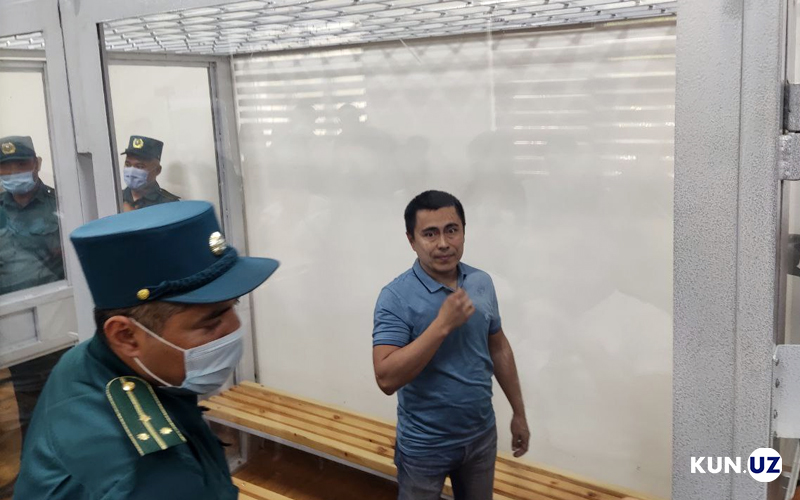
UZBEKISTAN
An independent expert opinion about Attacks on media workers in Uzbekistan report
Ever since coming to power in late 2016, President Mirziyoev has announced his commitment to media freedom and to end censorship. On the onset of his presidency, upon his initiative, a number of media representatives, including some from Western media outlets as well as a few formerly outcasted foreign based Uzbek media outlets, such as BBC Uzbek and Freghana.ru, were invited to participate in this grand media event. However, though certain improvements have been made, largely, the situation with the intimidation of journalists and bloggers remains the same.
The report clearly and rightly states the number of cases when journalists were under attack. However, the most alarming conclusion that comes out of this report is that the majority of attacks on media representatives are taking place not in the capital, Tashkent, rather in the Uzbek regions where local administration and governors have ultimate control.
President Mirziyoev’s calls for media openness go in sharp contradiction with what is really happening in the media landscape. There are several cases of attacks on journalists, stated in the report, which were not investigated by the Uzbek authorities and no perpetrator of crime has been punished. Sadly, we continue to witness the same impunity as regards to attacks on journalists during Mirziyoev’s era, as it was during his predecessor, President Karimov.
Ambiguity as regards to the newly added article in the Criminal Code of Uzbekistan regarding spreading false information also didn’t help. The law doesn’t define “false information” and therefore is open to interpretation of the authorities and law enforcement agencies. This again reminds of the old times of President Karimov, when the law makers left a lot of important and potentially controversial clauses in the laws open to interpretation which has resulted in a number of arrests of opposition members, journalists and anyone critical to the regime.
The report rightly emphasizes the role of Asadjon Khodjaev, the Head of the Agency on Mass Media and Communications under the President of Uzbekistan, as one of the obstacles to media freedom in the country. Being part of the previous regime, born and bred under the strict dictatorial environment of the previous president, Mr. Khodjaev’s idea of the media is one to spread government propaganda. Anything else is considered either fake news or an attempt to undermine the government. Having somebody like Mr. Khodjaev in charge of the main agencies overseeing mass media says a lot about the commitment of President Mirziyoev to free media.
It apparent from the report that Uzbek authorities who are used to traditional media, such as TV and newspapers, now are facing a new challenge -bloggers. It is obvious that popularity of telegram channels and Instagram is something which they did not expect and were not prepared for. However, it is obvious from the report that they are committed to carry on silencing independent voices, especially at times of pandemic or during catastrophic events such as the Sardoba water reservoir falling.
In conclusion, it is beyond disappointing to see that during 2017-2020 reviewed by authors of the report, the progress on media freedom was minimal and it looks like the government of President Mirziyoev doesn’t have a real commitment to media reforms, rather it is busy giving an impression of doing so to appease potential Western investors and to create a positive image of the country.
Author of the report – Sergey Naumov, freelance journalist
1/ KEY FINDINGS
129 instances of attacks/threats in relation to professional and citizen journalists, media workers, and editorial offices of traditional and online publications, as well as online activists in Uzbekistan in 2020 were identified and analysed in the course of the research. The data for the research were obtained from open sources in the Russian, English, and Uzbek languages using the method of content analysis. Data that have previously not been made public and were obtained using the expert interview method were likewise used in the report. A list of the main sources is presented in the Annex 9.
- The main type of attacks in relation to journalists, bloggers, and media workers are attacks via judicial and/or economic means (71 incidents).
- The main source of threats are representatives of the authorities; they became the initiators of 89 attacks.
- The quantity of non-physical and/or cyber-attacks and threats has increased eight-fold since 2019.
- 23 attacks connected with restrictions in the period of the COVID-19 pandemic were recorded over the monitoring period; non-physical attacks and threats account for six of these, attacks via judicial and/or economic means account for 16, and physical attacks for one.
- The most highly publicised attack in 2020 became the extradition from Kyrgyzstan to Uzbekistan and the short-term detention of the independent journalist Bobomurod Abdullayev [also spelled Abdullaev].
2/ THE POLITICAL SITUATION AND THE MEDIA IN UZBEKISTAN
Uzbekistan took 156th place out of 180 in the Reporters Without Borders annual freedom of speech rating for 2020. In 2019, Uzbekistan held the 160th position.
In the international human rights organisation Freedom House’s 2020 rating of internet freedom in the world (“Freedom on the Net”), Uzbekistan took 57th place out of 65 (58th in 2019) and remains in the category of countries with unfree internet. Freedom House asserts that the level of access to the internet in the country continues to grow, although the authorities have not loosened control over the communications and information technology infrastructure.
Those who touch upon “prohibited” topics in reports or comments – who criticise the president or blow the whistle on corruption – can meet with stern punishment. Extensive non-technical censorship of online content exists in Uzbekistan, although it is not always reported about, notes Freedom House.
According to data given by a representative of the Agency of Information and Mass Communications under the Administration of the President of the Republic of Uzbekistan at the OSCE’s 22nd Central Asia Media Conference, 1800 media outlets are registered in the country (in 2019 there were 1765), of which 643 are state-owned.
One of the main sources of information has become the Telegram messaging service; in Uzbekistan it boasts no fewer than 18 million active users. The number of channels is constantly growing; as of today, there are no fewer than 30 thousand of them.
In the course of the realisation of the Digital Uzbekistan-2030 strategy, internet speeds have increased, which has contributed to growth in the quantity of users – in excess of 22 million.
In January 2020 former press secretary of the head of state Komil Allamjonov and the president’s daughter Saida Mirziyoyeva became heads of the board of trustees of a new Foundation for Support and Development of National Mass Media. They became Uzbekistan’s main representatives on various international platforms. Announced as the main goals of the new civic organisation were development of mass information media, promotion of the exercise of the rights of journalists and bloggers, strengthening of the role of civic institutions in consolidating freedom of speech in the country, and improving Uzbekistan’s international image.
In the meantime, censorship in the country has intensified. Online publications, as had been the case in 2019, were being forced to delete publications. A new trend has emerged, however: the largest online publications were reprinting the articles of competitors that had been deleted at the demand of the authorities.
Bloggers express their point of view more freely in comparison with traditional media outlets. Texts have appeared about language policy, opposition to the state propaganda about “national spirituality”, LGBT people, human rights and political prisoners, torture and the work of the law-enforcement services, the events of 2005 in Andijan [Andijon], and the harm caused by state monopolies and corruption. The blogger Ali Kaxxorov conducted an anonymous survey among the subscribers to his Telegram channel; 827 people took part in it. To the question “Who is more courageous and more independent?” 89% of those surveyed responded that it is bloggers and 9% that it is electronic media outlets. To the question “What for you is domestic journalism in our country”, out of 684 people 78% gave the response “Just a business, where the interests of advertisers and personal connections with the elites stand above journalistic ethics”. In the situation that has emerged, editorial offices and bloggers are compelled to go for compromises, taking into account both the need to monetise content and the threat of repressions.
The head of the Agency of Information and Mass Communications, Asadjon Xodjayev [Khodjaev], an electrical engineer by education, regards mass media outlets and bloggers as a part of the state propaganda apparatus. In November 2020, he accused an online publication of lack of objectivity and warned about “serious legal consequences”. The reason for the threats was critical posts on social media and in media publications with respect to problems with electrical and gas supply. The head of the AIMC discerned “an accusation addressed at the government of Uzbekistan of having committed a crime in relation to the populace” in these texts. Also incurring the displeasure of the AIMC chief was the fact that bloggers had brought attention to inconsistencies in the open statistical data about the number of persons who had fallen ill with COVID-19 and patients in special hospitals.
On 25 December 2020, punishment for dissemination of false information was added to legislation. The concept of “false information” is not concretised in the law, which opens the door to broad opportunities for abuse in criminal and administrative prosecution. After the introduction of amendments to the Administrative Code for false information that leads to an affront to dignity or defamation of character, offenders will face a fine in an amount of 1065 dollars, while for disinformation creating a threat to public order or safety the fine increases to 2130 dollars.
The Criminal Code has been supplemented with an article for repeat dissemination of false information: the fine will increase to 3195 dollars; besides that, the violator can be ordered to perform up to 240 hours of community service or correctional work up to two years, or have his or her liberty restricted for that same term. For information that threatens public safety, offenders face a fine up to 4200 dollars or community service up to 300 hours. If from judges’ point of view the violator’s actions have caused significant loss, then the fine can go as high as 85 thousand dollars, while restriction of liberty will comprise up to three years. If the violation took place during mass events or during a time that a state of emergency was in effect, then the terms of restriction or deprivation of liberty can increase to five years.
3/ GENERAL ANALYSIS OF ATTACKS
The graph below represents a general analysis of attacks on journalists, bloggers, and media workers in 2020 in Uzbekistan.
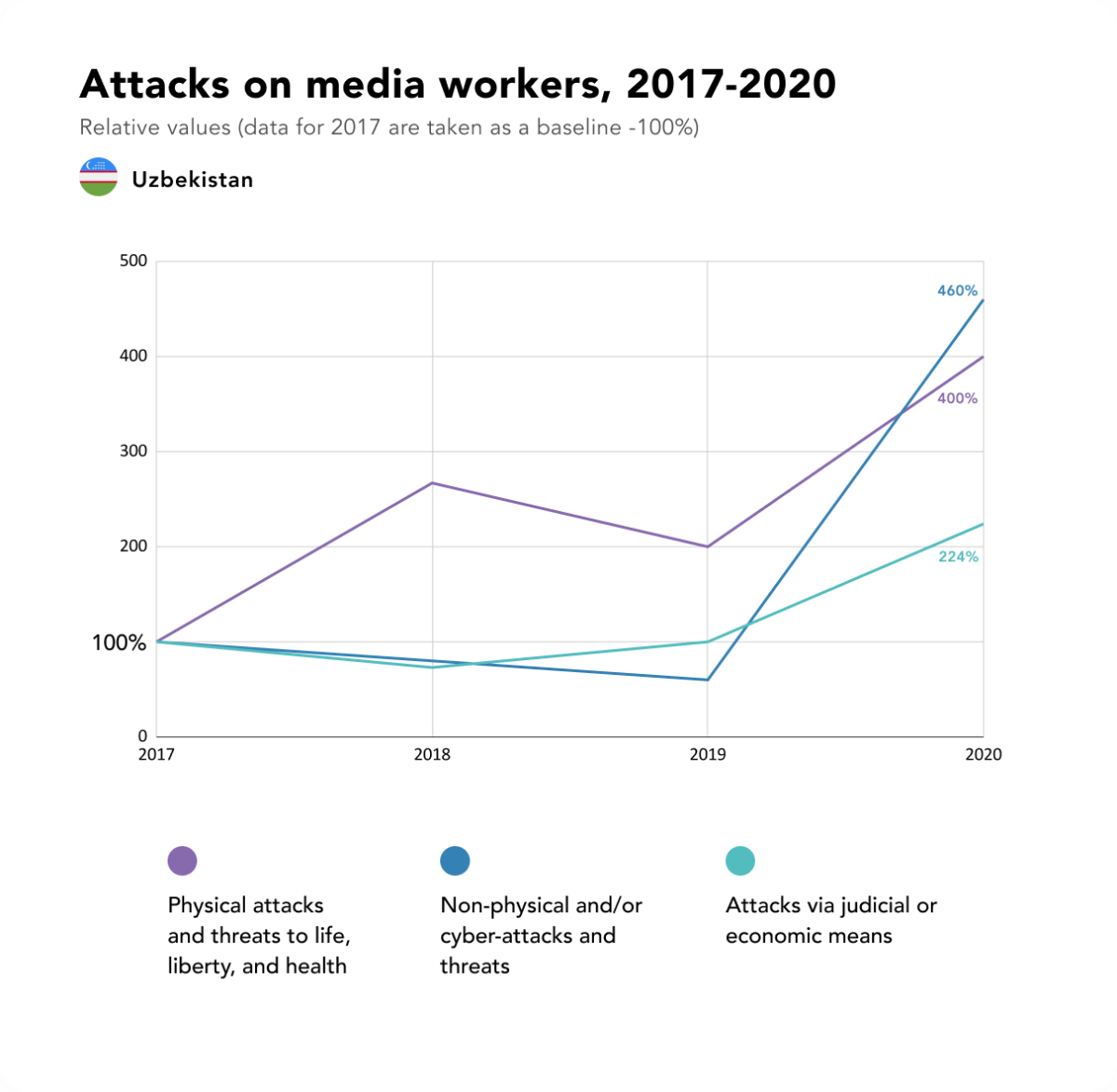
The number of attacks increased in all the categories, but non-physical and/or cyber-attacks/threats became particularly greater in frequency –an eight-fold rise is observed in this category in comparison with 2019. The number of attacks via judicial and/or economic means increased more than two-fold. There were 12 physical assaults recorded.
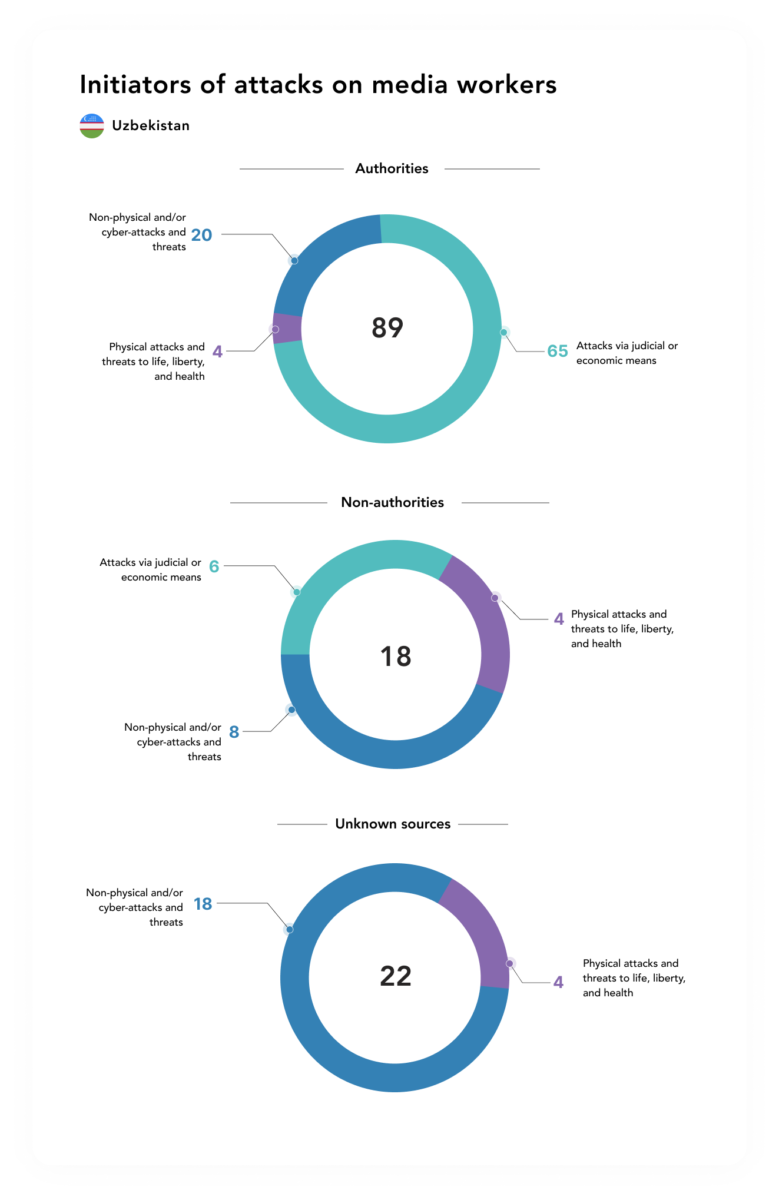 For the purposes of more precisely reflecting combination assaults on media workers in 2020 we are introducing a new category of attacks – hybrid.
For the purposes of more precisely reflecting combination assaults on media workers in 2020 we are introducing a new category of attacks – hybrid.
We are calling systematic persecution of some publication or media worker with the use of tools from two or more categories of assaults – physical, non-physical, and judicial/economic – “hybrid”. Such a combination of means involving and not involving force with judicial means of pressure on undesirable journalists is carried out with a view to demoralising them or getting them to self-censor or to give up the profession or even life itself.
In 2020, 28 hybrid attacks were recorded, of which 20 attacks committed against 4 journalists. Presented below is the list of the journalists and bloggers who were being subjected to the most intensive hybrid attacks in 2020.
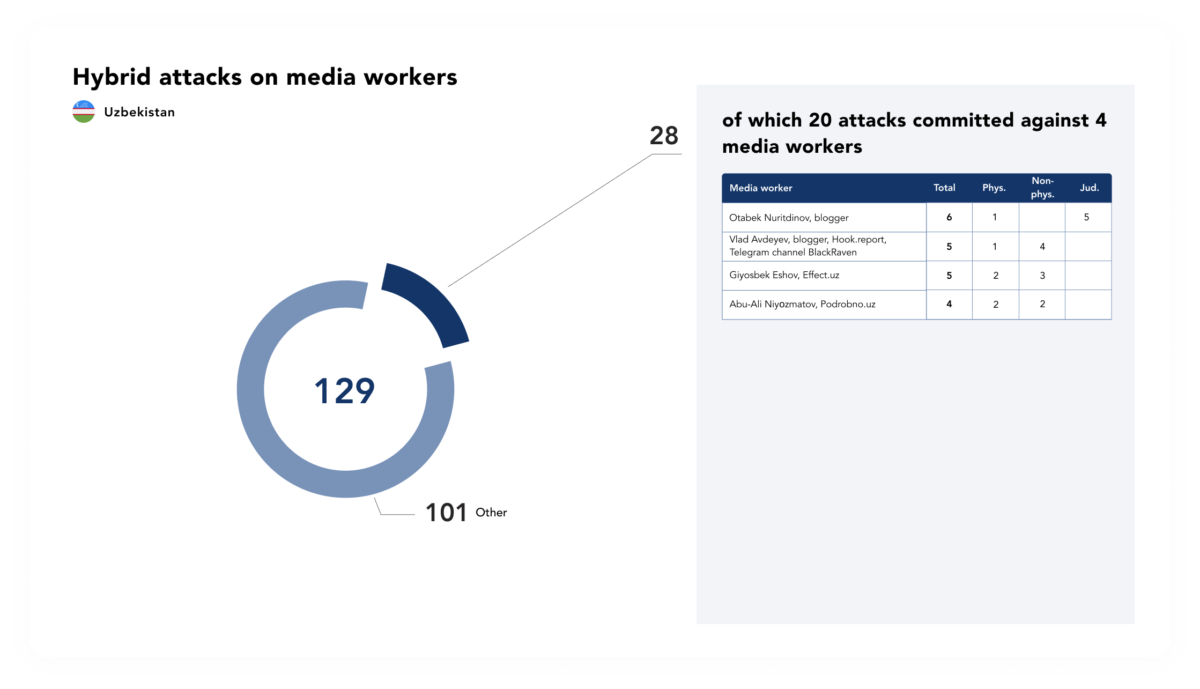
4/ PRESSURE ON MEDIA WORKERS UNDER THE PRETEXT OF RESTRICTIONS RELATED TO THE COVID-19 PANDEMIC
In the period of the pandemic, all registered media outlets and bloggers became rebroadcasters of the reports of the Special Commission for Fighting the Coronavirus. From March through May, the authorities were restricting the movements of media workers, which elicited a sharply negative reaction on their part. As of 16 March the authorities began introducing harsh administrative measures and on 26 March they introduced fines in a sum from 650 to 900 dollars for creating panic amongst the populace.
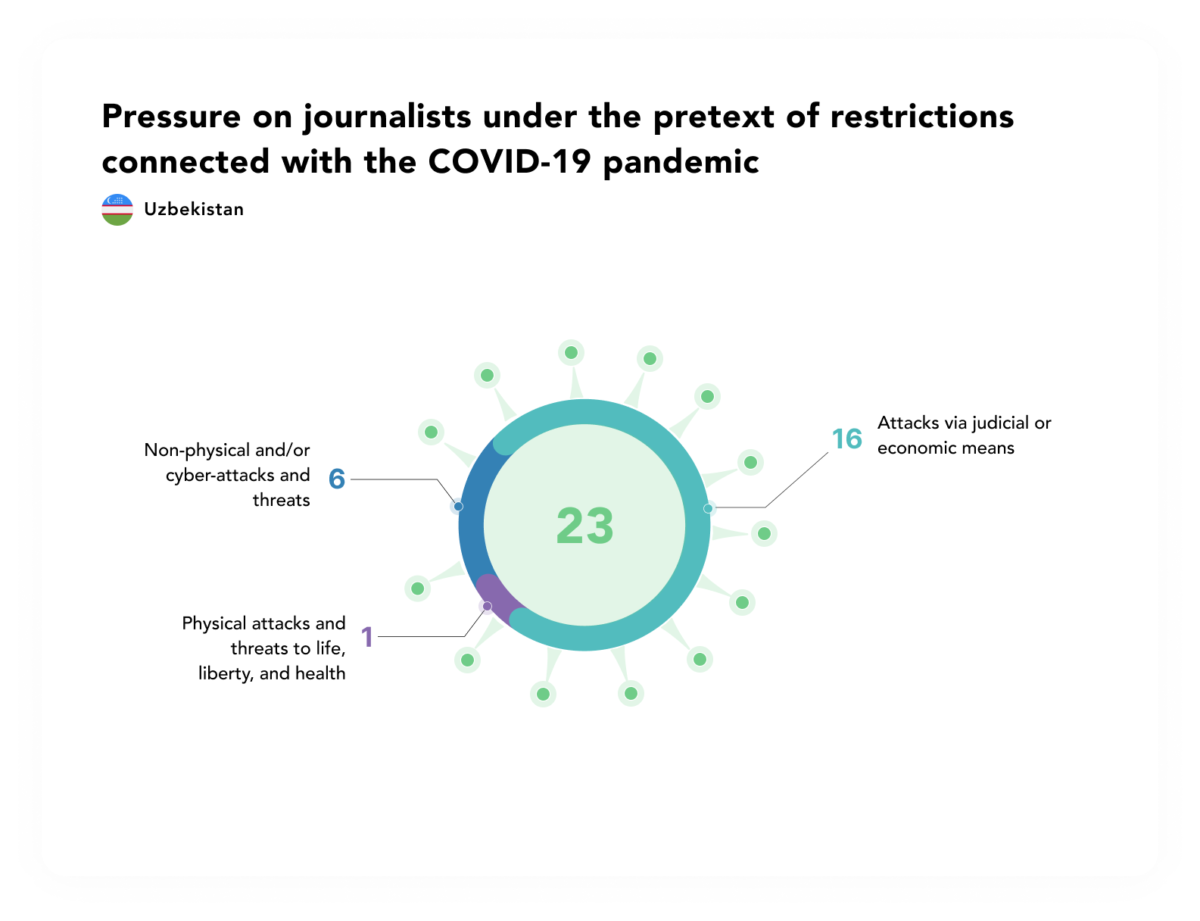
Changes to article 244 of the Criminal Code of the Republic of Uzbekistan prescribe that “dissemination of information not corresponding to reality about the spread of quarantinable and other infections dangerous to humans” in “a printed or otherwise duplicated text or in the mass information media, as well as the Internet worldwide information network”, shall be punishable by a fine in an amount from 200 to 400 base calculation values or compulsory community service from 300 to 360 hours, or correctional work from two to three years, as well as restriction of liberty up to three years.
Journalists switched to working online. They made do with information from a cabinet of ministers working group and the Coronavirus info Telegram channel, created by the Foundation for Support and Development of National Mass Media. This foundation is also involved in the Antifake.uz project: the channel’s administrators look for inaccuracies in the publications of the local media and try to refute the reports of Radio Liberty‘s Uzbek service. At times things could get rather bizarre – the reports of special groups affiliated with the government were being refuted as fakes. However, the first to fall under the watchful eye of the police were bloggers and independent journalists.
23 attacks associated with pressure and restrictions in the period of COVID-19 were recorded over the monitoring period, six of which represent non-physical attacks and threats and 19 are attacks via judicial and/or economic means; one attack was physical in nature.
- Baxtiyor Karim, editor-in-chief of the print publication Adabiyot gazetasi (Literary newspaper), found himself in compulsory quarantine in a special zone. His colleagues are confident there is a political undercurrent to the isolating of the journalist.
All non-physical attacks belonged to the “bullying, intimidation, pressure, threats of violence and death, including cyber-” subcategory:
- On 23 March, unknown persons telephoned journalist and blogger Yuri Chernogayev and reminded him about criminal liability for “dissemination of panic” in posts about the situation with COVID-19 in Uzbekistan.
- On 24 March, an employee of the Urgench department of internal affairs and a sanitary-epidemiological station worker compelled freelance journalist Sergey Naumov to sign on for self-isolation for 14 days, despite the fact that he had returned long before the introduction of quarantine and had flown in from a “green zone” – Georgia. Subsequently, a precinct police officer tried to force Naumov to take a test for AIDS and venereal diseases after a three-day sojourn in Georgia, supposedly as a labour migrant.
- On 31 March, an employee of the law-enforcement agencies called photojournalist Timur Karpov and demanded that he set off with him to a shipping container camp for quarantine, despite the fact that three weeks had passed since the journalist’s return from Georgia. The need for compulsory isolation was not explained to Karpov. The journalist ignored the unlawful demands.
- On 20 November, the editorial offices of the Gazeta.uz, Daryo.uz, and Podrobno.uz publications received a letter from the director-general of the Agency of Information and Mass Communications under the Administration of the President, Asadjon Xodjayev, who was threatening them with serious legal consequences for publication of statistics and news about COVID-19.
The main methods of pressure via judicial and/or economic means were court trials (5), administrative arrests, remand, pre-trial detention, prison (5), and criminal/administrative case (5).
- On 7 April, bloggers Umid Hamidov, Kamola Majidova, and Olmosbek Razikov [Razыkov (sic)] were arrested for 15 days for “violation of quarantine rules” and “petty hooliganism”. They were circulating a video taken at a monument to Amir Temur: Majidova was jokingly asking the monument “when will the coronavirus leave Uzbekistan?” Being found in public places without personal protection equipment should carry a fine, not 15 days of arrest. The court discerned disrespect for a historical figure in the video. Besides that, it deemed that “actions expressing deliberate flouting of the rules of conduct in public” had been “demonstrated” in the video.
- On 8 April, the blogger Heydar Aliyev was arrested for seven days under article 183 (petty hooliganism) of the Code on Administrative Liability. As the judge asserts, the blogger “was demonstrating disdain for sanitary-epidemiological requirements, as well as ridiculing, with the use of explicit language, the work of employees of internal affairs bodies being conducted in the days of quarantine”.
- On 19 May, employees of the law-enforcement agencies fined Sabina Bakayeva, a journalist with the online publication uz, for not wearing a mask. They did not display video evidence of the violation of the quarantine regime – their body cameras had been shut off in violation of an agency instruction. According to eyewitness evidence, Bakayeva had been wearing a mask.
- On 25 May, the administrative court of Mirobod District of Tashkent fined the journalist Sabina Bakayeva for riding a bicycle, even though she was not violating the authorised procedure for travel during the time of quarantine.
- On 27 May, the Fergana city administrative court found Fergana Regional Television and Radio Company journalist Usmonjon Qodirov [Kodirov] guilty of the offences prescribed by part 1 of article 54 (violation of the rules for fighting epidemics), article 183 (petty hooliganism), and part 1 of article 194 (not carrying out the lawful demands of an employee of internal affairs bodies) of the Code on Administrative Liability. The journalist was meted out 15 days of arrest. The real reason for his administrative prosecution was a post on Facebook about medical personnel being called to do landscaping work before the arrival of the president.
- On 22 July, “handlers” at one of the law-enforcement agencies compelled administrator of the Telegram channel Troll.uz Umid Gafurov to remove a post about corruption in the period of the pandemic. He had conducted an anonymous survey among readers and had brought to light that patients were signing receipts that they had supposedly undergone a course of treatment costing 3 thousand dollars, for which they were promised monetary compensation. Several dozen people had confirmed the fact of corruption.
5/ PHYSICAL ATTACKS AND THREATS TO LIFE, LIBERTY, AND HEALTH
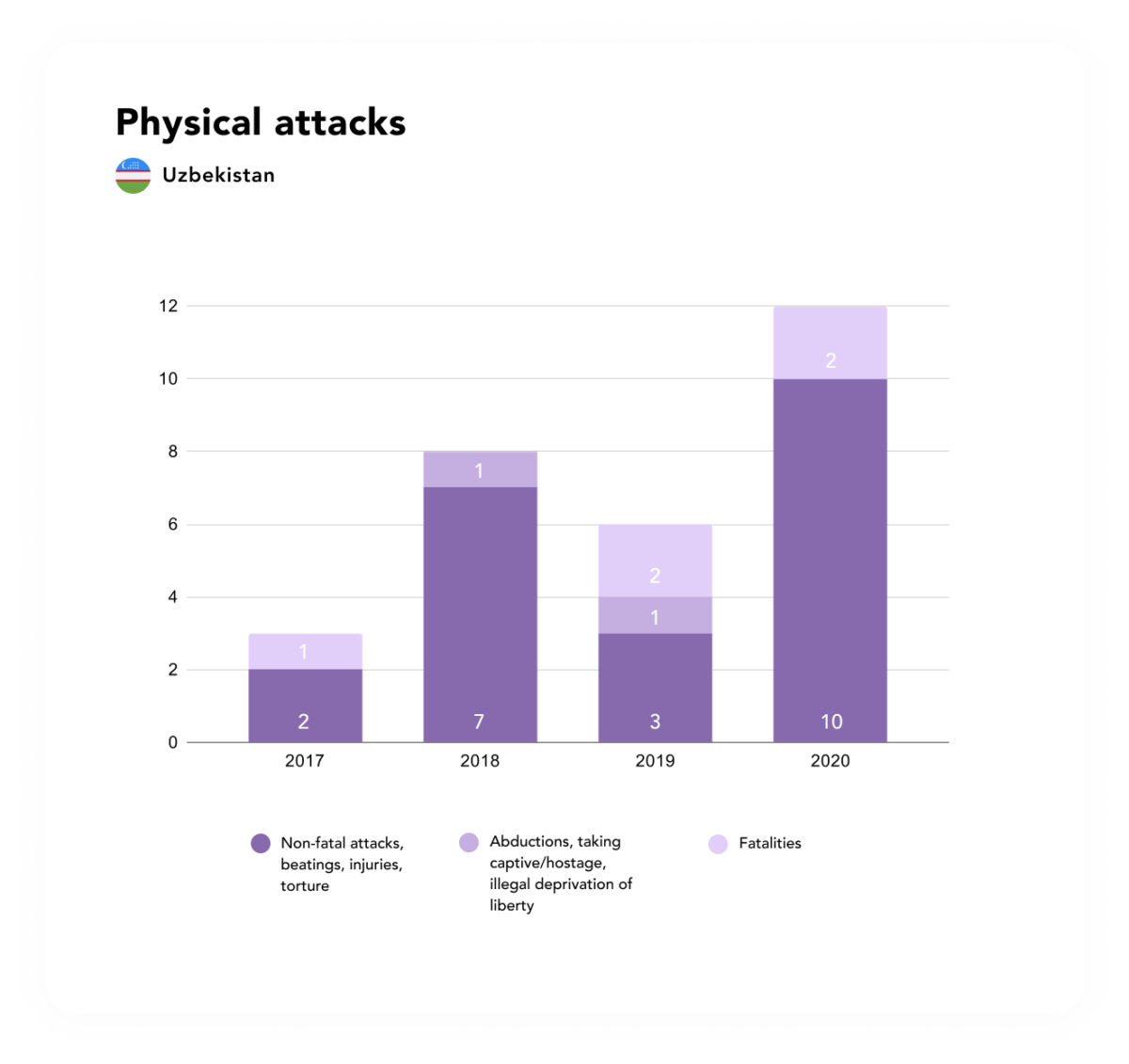
As compared with 2019 the quantity of attacks on journalists and bloggers in 2020 grew significantly; the geography of the attacks expanded and the degree of their cruelty increased. 8 of the 12 recorded attacks were physical assaults:
- On 18 February, blogger Otabek [Abdufatto] Nuritdinov was cruelly beaten up by the owners of a shop for a post on social media about the sale of alcohol next to the Khalid ibn al-Walid [“Xolid Ibn Valid” in Uzbek] mosque in Asaka District of Andijan Region. They ripped apart Nuritdinov’s mouth. Doctors had to put five stitches in his oral cavity and one on his face.
- On 13 May, online publication Effect.uz video operator Giyosbek Eshov [G‘iyosbek Eshov] ended up in hospital in Quva District of Fergana Region after being assaulted by four unknown persons as he was carrying out an editorial assignment. They sprayed him from a gas canister and
- On 6 July, in the Tashkent Region four employees of the law-enforcement bodies beat up and illegally detained the blogger Saodat Abduzakirova. During the time of the detaining, they ripped her blouse and inflicted mild bodily injuries.
- On 23 July, two unknown persons beat up the journalist Vlad Avdeyev of the independent online publication report and took away his smartphone. Threatening reprisal, they forced him to pay ransom for his telephone. The journalist did not have the necessary sum with him; he was forced to let the unknown persons into his flat and to give them the money there. After the criminal incident the journalist wrote a report of crime to Tashkent’s Uchtepa District Department of Internal Affairs; however, an investigation was not duly conducted. The journalist connects this attack with his publications about the LGBT community.
- On 7 October, the journalist Abu-Ali Niyоzmatov was shooting pictures of the illegal felling of trees next to a cafe in Tashkent Region. Unknown persons dragged him into the establishment, beat him up, took away his smartphone, and locked him up inside the premises. After a call from Niyоzmatov’s friend, internal affairs employees arrived and freed the journalist. The forcible confinement was not investigated.
- On 23 October, in Tashkent, checkpoint-and-patrol service employees beat up online publication uz journalist Alisher Ruziohunov [Alisher Roʻzioxunov] with truncheons. Being behind the wheel, the journalist had lightly brushed against a police inspector, who deliberately provoked a road accident. One of the employees took his telephone from him, whilst another inspector in a mask hit the journalist full force with a truncheon in the stomach.
- On 18 June, the moderator of the Sukut Saqlama Telegram channel, Nigora Adizova, was threatened with murder by a neighbour. In the presence of law-enforcement agency employees, Gulnoza Mamatova, armed with a knife, was breaking down Adizova’s door shouting “I’m going to butcher you and your children!”
One instance of pressure on a media worker by means of physical pressure on relatives and loved ones was recorded:
- On 4 September, the father of print publication Navoiy ziyosi journalist Mahfuza Pulatova was beaten up by acquaintances of the chairman of the «Bogʻi Shamol» mahalli (quarter) of Karmana District of Navoiy Region. Earlier, the chairman had threatened her with consequences for a critical article. The publication “Blagotvoritel’nost’ dlya efira” [“Charity for the cameras”] contained sarcastic remarks addressed at the chairman of the mahalli.
6/ NON-PHYSICAL AND/OR CYBER-ATTACKS AND THREATS
In comparison with 2017-2019, twice as many non-physical and/or cyber-attacks and threats were recorded in 2020 – 46 as opposed to 24. The most widespread forms of pressure were bullying, intimidation, pressure, threats of violence and death, including cyber- (20), defamation, spreading libel about a media worker or media outlet (6), and breaking into email/social media accounts/computer/smartphone (6).
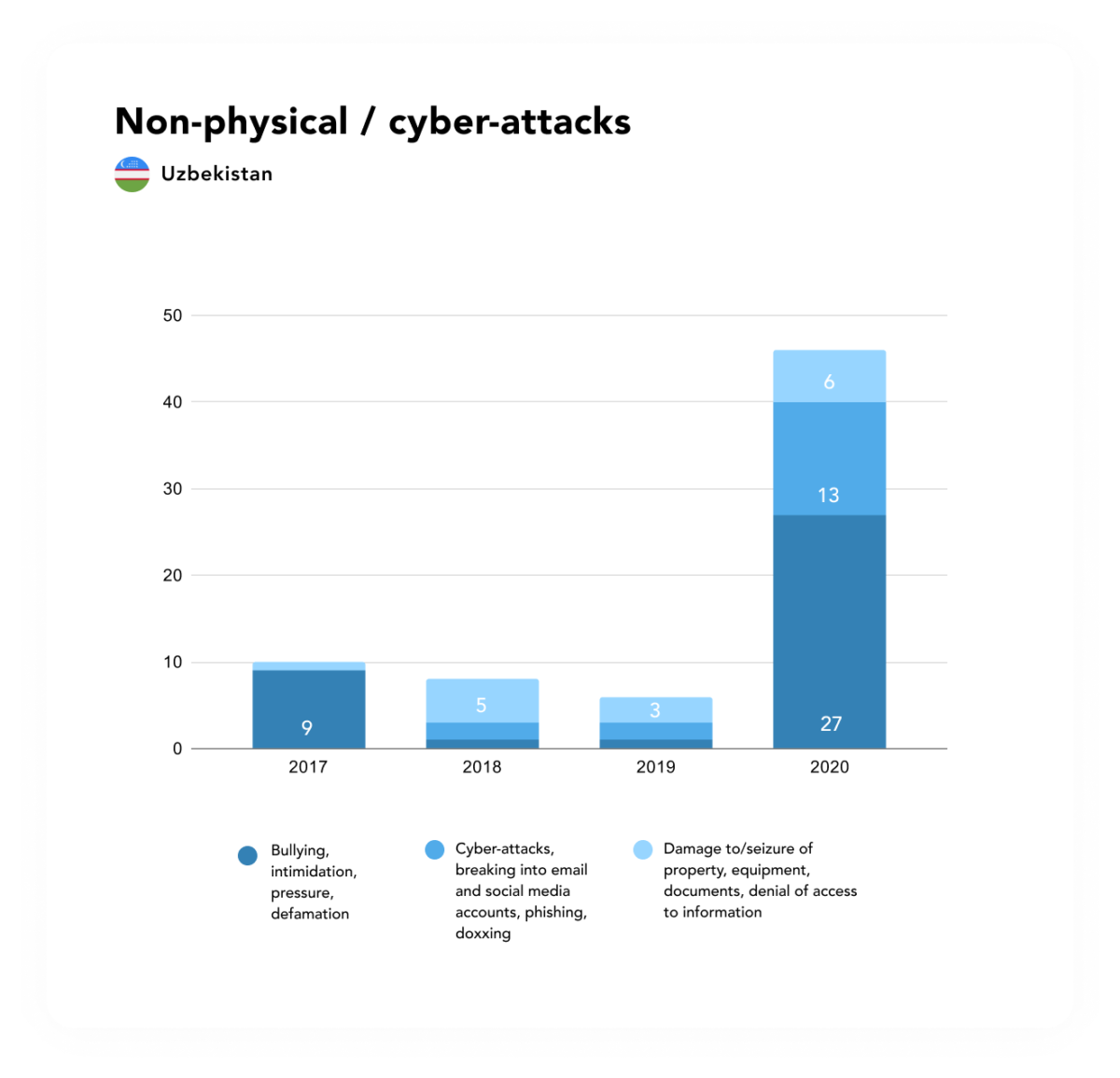
Only a few attempted cyber-attacks have been documentarily confirmed. In reality there were far more of them.
- On 23 March, the Hook.report website was subjected to a DDoS attack and was working intermittently. Texts of dubious content appeared on the website instead of the normal materials.
- On 25 July, a hacker attack was perpetrated on the Repost.uz news agency website. The malefactors posted news about the death of Musa Yerniyazov, chairman of the Joqarg’ı Ken’es [Supreme Soviet] of Karakalpakstan [Qaraqalpaqstan]. In the course of several days the headline was not visible on the website; the publication did open with a direct link, however. According to the editorial office’s story, the hackers had gained access to the editorial control panel of one of the editors. The news went viral on Telegram channels.
- On 31 July, journalists from the independent website Hook.report published material about the summons to the State Security Service of the blogger Miraziz Bazarov. After this, announcements about the rendering of sexual services appeared on the net in the name of two employees of this publication, Vlad Avdeyev and Darina Solod. The journalists’ personal data and telephone numbers and photographs were published. It is assumed that Uzbekistan’s special services are behind the attack.
- On 6 August, unknown persons tried to break into the Telegram accounts of several bloggers, including Zafarbek Solijonov, Alexandra Ivanyuzhenko [Sasha Ivanyujenko], Feruzkhan Yakubkhodjaev [Feruzxon Yoqubxo‘jayev], and Shukhrat Kurbanov [Shuxrot Qurbonov].
Three attacks associated with trolling were also recorded:
- Blogger Kirill Altman was subjected to trolling by students from the University of Journalism and Mass Communications on 29 January. As if by command, dozens of students began posting angry posts threatening Altman with court and indicating at his having mental health problems.
- On 1 September, Artel, an Uzbek group of companies producing household appliances and electronics, forced their employees to engage in trolling in relation to uz administrator Umid Gafurov after he had posted a satirical clip about Tashkent mayor Jahongir Ortiqhojaev [Jahongir Ortiqxoʻjayev].
- On 3 September, blogger Aqida Hanum organised a live interview on Facebook with a victim of domestic violence. The woman recounted that she was an orphan and that her husband had been regularly beating her for eight years and was forcing her to eat soiled diapers. As a result, trolls attacked the blogger and she received threats addressed to her.
Bullying, intimidation, pressure, threats of violence and death, including cyber- were the most widespread methods of pressure in 2020. In roughly half of the incidents, attacks of this type came from representatives of the authorities:
- On 8 January, former manager of the government Citizen Reception Office of Samarkand [Samarqand] Jamshid Umarov was verbally abusing the blogger Timur Sattarov, who had come to a polling station to observe the course of the voting, and was trying to get him to leave.
- On 17 January, a major of the local police, accompanied by a precinct police officer, lay in wait for the independent journalist Sid Yanishev by his house in Tashkent. Without introducing himself, the officer demanded that Yanishev produce a passport and said to him “Remember me!”.
- On 27 April, an unknown person was intimidating an asiaterra.info journalist (name withheld in the interests of security) by telephone, having introduced himself as an employee of the Ministry of Justice.
- On 3 September, Mahfuza Pulatova, a journalist with the Navoi ziyоsi newspaper, was threatened with consequences by the chairman of the «Bogʻi Shamol» mahalli (quarter) of Karmana District of Navoiy Region for a critical article.
- On 23 November, the director-general of the Agency of Information and Mass Communications under the Administration of President Asadjon Xodjayev accused the online publication Kun.uz of lack of objectivity and warned of “serious legal consequences”. The threats were associated with the publication of critical posts in regard to problems with electric power and natural gas in Uzbekistan.
7/ ATTACKS VIA JUDICIAL AND/OR ECONOMIC MEANS
In 2020, the quantity of attacks in the given category more than doubled, reaching 74 incidents. The main methods of pressure were court trials (12), criminal and administrative cases, excluding libel, insult, and charges of extremism and dissemination of false information (12), confiscation/seizure of property, vehicles, equipment, documents, journalistic materials (10), and administrative arrest, remand, pre-trial detention, prison (9).

The most highly publicised attack against a journalist in 2020, one that attracted the attention of international human rights organisations, became the incident with Bobomurod Abdullaev. Abdullaev, a journalist from Uzbekistan, was detained by employees of the State Committee for National Security of Kyrgyzstan in one of Bishkek’s cafes. The Uzbek journalist had arrived in Kyrgyzstan from Berlin, where he had spent several months at the invitation of Reporters Without Borders after he had been convicted and had served punishment in Uzbekistan for his journalistic activity.
The leading international human rights organisations were calling on Kyrgyzstan’s authorities not to extradite the journalist to Uzbekistan, where earlier he had already been subjected to torture on the part of the local special services. However, after a two-week spell in a pre-trial detention facility, Bishkek’s SCNS handed Abdullaev over to Uzbekistan. There, employees of the State Security Service subjected him to an eight-hour interrogation, after which the state security service disseminated a video in which the journalist expresses appreciation to president Mirziyoyev for concern for his fate and humaneness.
The journalist is under investigation on charges of assault on the constitutional order of the Republic of Uzbekistan and assault on the president of the Republic of Uzbekistan. He is prohibited from leaving Uzbekistan, and his movements within the country are restricted. In the meantime, the authorities have given him a three-room flat in order to placate the international community, which had been fighting for his release.
Confiscation/seizure of property, vehicles, equipment, documents, and journalistic materials have become the main methods of attacks on journalists in this category:
- On 22 April, special correspondent for the newspaper Ma’rifat and member of the Fargʻona regional section of the Creative Union of Journalists of Uzbekistan Sharifa Madrahimova was being held over the course of two hours in the department of internal affairs of Uchkoʻprik District of Fergana Region for shooting video of a food fair. The hokim‘s (head of the local administration) secretary was trying to grab her telephone from her as she was recording. After the journalist’s release from the department of internal affairs, the recordings on her device turned out to have been deleted.
- During the detaining of a Human.uz camera operator on 3 May, employees of the department of internal affairs damaged his camera, after which they deleted footage with victims of the Sardoba reservoir dike breach he had filmed. A Human.uz journalist was likewise detained. After the detaining employees of the local law-enforcement bodies deleted the material that had been shot.
Another widespread method of pressure on journalists and bloggers was interrogation.
- On 26 July, six Karakalpak journalists and bloggers were summoned for interrogation to the prosecutor’s office. The reason became a repost of a report on the Repost.uz website about the death of the long-time leader of Karakalpakstan. The interrogation went on until three o’clock in the morning; some people had smartphones and notebooks confiscated.
One incident of forced emigration was recorded in 2020:
- On 19 January, the blogger Nafosat Olloshukurova fled Uzbekistan, fearing another hospitalisation in a specialised early treatment psychiatric clinic. Earlier Olloshukurova had been arrested for covering a local journalist’s individual protest, had announced a hunger strike, and had spent three months in the Xorazm [Khorezm] specialised early treatment psychoneurological clinic.
Besides the criminal and administrative cases connected with the COVID-19 pandemic and described in the corresponding section, several more incidents of judicial persecution ought to be mentioned:
- On 4 January, the Andijan Administrative Court found the blogger Otabek Nuritdinov guilty of libel, insult, and petty hooliganism and set him punishment in the form of a fine in the amount of 1365 US dollars and administrative arrest for 15 days.
- On 4 March, the Military Court of Uzbekistan sentenced Vladimir Kaloshin, a former journalist with the print publication Vatanparvar (Patriot), to 12 years in a general regime prison colony. Kaloshin was found guilty under Article 157 (high treason) of the Criminal Code of Uzbekistan. The evidence of the crime was not read out in court.
- Dadaxon Haydarov, administrator of the YouTube channel DENGIZ TV, the lone blogger in Sokh District of Fergana Region, was arrested on August 25. Haydarov is suspected of organising mass disturbances and resisting representatives of the authorities.
ANNEX 5: OPEN SOURCES USED FOR THE REPORT (BELARUS)
- Belorussian Association of Journalists –non-governmental, non-profit and non-partisan association of media workers, promoting freedom of expression and independent journalism ideas in Belarus.
- Ministry of Information of the Republic of Belarus –a national government agency in the field of mass media that has serious administrative and sanction powers (from registering mass media to initiating their closure, as well as extrajudicial blocking of Internet resources).
- Belsat – a Polish free-to-air satellite television channel aimed at Belarus.
- Belapan –an independent news agency of Belarus.
- Belta – state news agency created to disseminate information about the activities of the state bodies of Belarus.
- TUT.BY – leading information website of Belarus.
- Reporters without Borders – an international non-profit and non-governmental organization that safeguards the right to freedom of information.
- Belarusian and English-language resources that are available online.
ANNEX 6: OPEN SOURCES USED FOR GATHERING DATA (CRIMEA)
- Crimean Human Rights Group – an initiative of representatives of human rights organisations, the aim of which is to promote the observance and protection of human rights in Crimea.
- Crimean Solidarity civic movement – an informal human rights organisation for protection of the victims of political repressions.
- Realii – a service of the international media company Radio Free Europe/Radio Liberty; an internet media outlet providing detailed coverage of political persecutions in Crimea.
- Crimean Process [Krymsky protsess] civic initiative – an association of experts and volunteers who evaluate the peculiarities of judicial proceedings in political cases on the territory of Crimea.
- Sova Center for Information and Analysis– a Russian non-governmental organisation researching such topics as nationalism and xenophobia, relations between the churches and the secular society, and political radicalism.
- The Facebook social network
- Open source Russian-language media on the internet.
ANNEX 7: OPEN SOURCES USED FOR GATHERING DATA (KAZAKHSTAN)
- The International Foundation for Protection of Freedom of Speech Adil Soz – a Kazakhstani human rights organisation whose major priority is “establishment of open civil society over the statement in daily life of the country free, objective and progressive journalism”.
- The Kazakhstan International Bureau for Human Rights and the Rule of Law – a non-governmental organisation whose aim is to promote the observance of civil and political rights and liberties in Kazakhstan.
- Committee to Protect Journalists (CPJ) – an international non-governmental organisation engaged in defending the rights of journalists.
- Radio Azattyq – the Kazakh service of the international media company Radio Free Europe/Radio Liberty; an internet media outlet that provides detailed coverage of political persecutions.
- MIA «KazTAG» – a news agency.
- The Facebook social network
- Russian- and Kazakh-language open access media on the internet.
ANNEX 8: OPEN SOURCES USED FOR GATHERING DATA (RUSSIA)
- Agora International Human Rights Group – Agora International Human Rights Group is an association of more than 50 lawyers working on landmark human rights cases.
- Caucasian Knot – an online news site that covers the Caucasus region in English and Russian. It has a particular focus on politics and on human rights issues, including freedom of the press.
- Committee to Protect Journalists -an American independent non-profit, non-governmental organization. CPJ promotes press freedom and defends the rights of journalists.
- Council of Europe – a platform to promote the protection of journalism and safety of journalists.
- Delovoy Peterburg – Russian language daily business newspaper published in Saint Petersburg.
- Deloitte Analysis Media Consumption in Russia
- DW – a global English-language news and information programme from German public international broadcaster Deutsche Welle.
- Federal Agency on Press and Mass Communications of the Russian Federation – a federal executive body responsible for providing government services and managing government property in the field of press, mass media and mass communications, including public computer networks used in electronic media as well as in printing and publishing.
- Freedom House – a U.S.-based, U.S. government-funded non-profit non-governmental organization that conducts research and advocacy on democracy, political freedom, and human rights.
- Journalist – the website of the magazine Journalist
- Journalists’ and Media Workers’ Union – an independent organization for the protection of journalists and media workers.
- Kommersant – a nationally distributed daily newspaper published in Russia mostly devoted to politics and business.
- Obshaya Gazeta – online newspaper with socio-political focus.
- Mass Media Defence Centre – an NGO working in the field of media rights protection and the promotion of freedom of expression standards in Russia.
- Mediascope – a media research and advertising monitoring company.
- Medialogia – a leading developer of media monitoring systems and social networks. In real-time, we collect data from the media and social media – tens of millions of messages per day.
- Mediazona – Mediazona focuses on the judicial, law enforcement and penal system in Russia.
- Novaya Gazeta -Russian newspaper well-known for its critical and investigative coverage of Russian political and social affairs.
- OVD-Info -a Russian non-governmental human rights media project aimed at combating political persecution.
- Open Media – an online publication about politics, economics, science and culture.
- Official Internet portal of legal information
- Official website of the State Duma
- Roskomsvododa – a public organization whose activities are aimed at protecting digital rights, promoting the ideas of freedom of information, the inadmissibility of state censorship and interference in private life.
- Glasnost Defence Foundation-a non-profit organization with the stated goals of defending journalists, journalism, and freedom of expression in Russia.
- Index on Censorship – an organization campaigning for freedom of expression, which produces a quarterly magazine of the same name from London.
- The Bell – media startup founded by Elizaveta Osetinskaya.
- Levada-Center – a Russian non-governmental research organization. The Centre regularly conducts sociological research. Levada-Center is one of the largest Russian centers in the field.
- MBK Media -an independent online news outlet that focusses on what is happening in Russia and its regions.
- Pandemic Big Brother – monitoring of digital rights and freedoms of citizens during the epidemic (the Roskomsvoboda project)
- Reporters without Borders – an international non-profit, non-governmental organization that conducts political advocacy on issues relating to freedom of information and freedom of the press.
- Roskomnadzor – The Federal Service for Supervision of Communications, Information Technology and Mass Media or Roskomnadzor is the Russian federal executive body responsible for censorship in media and telecommunications.
- RIA Novosti – a Russian state-owned domestic news agency, which since 9 December 2013 has operated under Rossiya Segodnya. RIA Novosti is headquartered in Moscow.
- Znak.com – news website.
- Russian and English-language rescources that are available online.
ANNEX 9: OPEN SOURCES USED FOR UZBEKISTAN REPORT (UZBEKISTAN)
- The Fergana Information Agency – a resource covering events in Central Asia.
- Radio Ozodlik – the Uzbek Service of Radio Free Europe / Radio Liberty.
- Centre1.com – an independent media organisation specialising in Central Asian news.
- Asiaterra– an information and analysis site covering Central Asia
- Front Line Defenders– an international defence foundation and Irish human rights organisation set up in Dublin, Ireland, in 2001.
- International Partnership for Human Rights (IPHR)– an international non-profit organisation with its headquarters in Brussels, Belgium. Established in spring 2008.
- Committee to Protect Journalists– an international non-governmental organisation that defends the rights of journalists.
- The Association for Human Rights in Central Asia (AHRCA) – an independent human rights organisation. The initiators behind the founding of the AHRCA were citizens of Central Asian countries who had experienced politically motivated persecution.
- ACCA.media – an independent human rights media project that writes about human rights violations.
